The document discusses secure compilation of partial programs, highlighting the risks associated with linking to buggy or malicious contexts and the importance of proving the security of compiled programs. It introduces proof techniques, particularly data-flow back-translation, aimed at ensuring that the compiled programs maintain the robust safety of the original source programs. The work addresses challenges in memory sharing and seeks to improve the trace-directed back-translation method to accommodate syntactic dissimilarity between source and target programs.
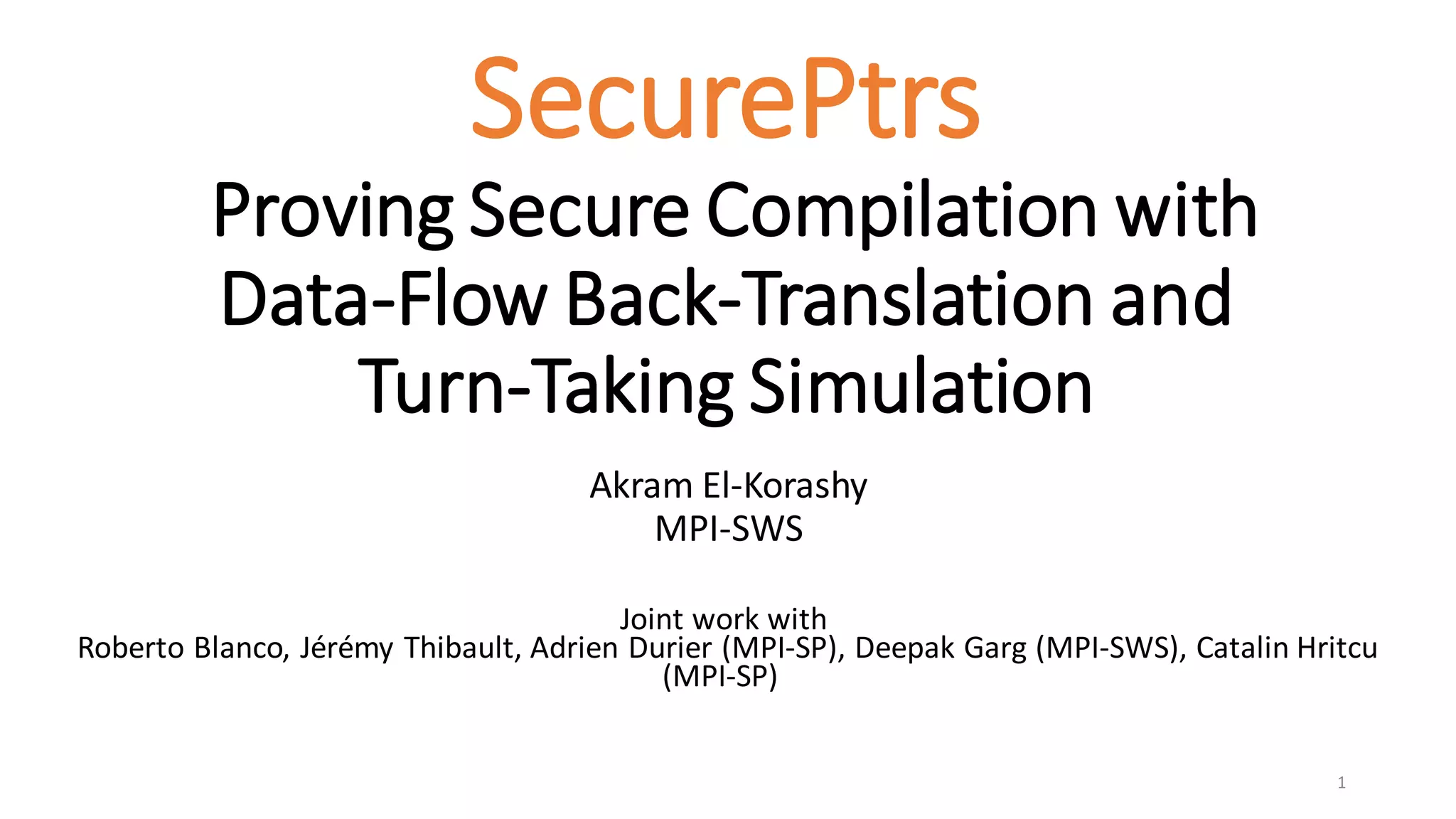
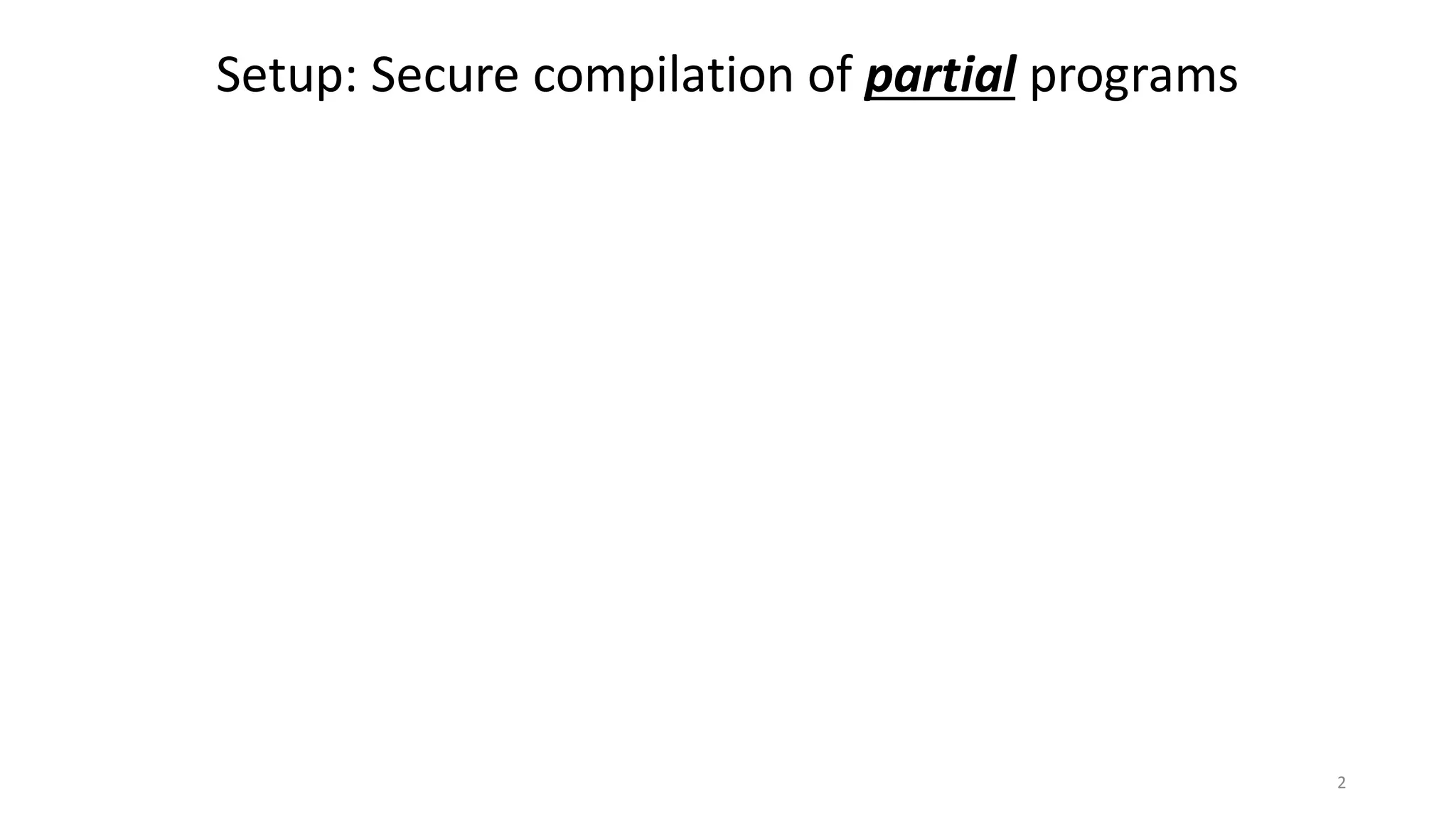
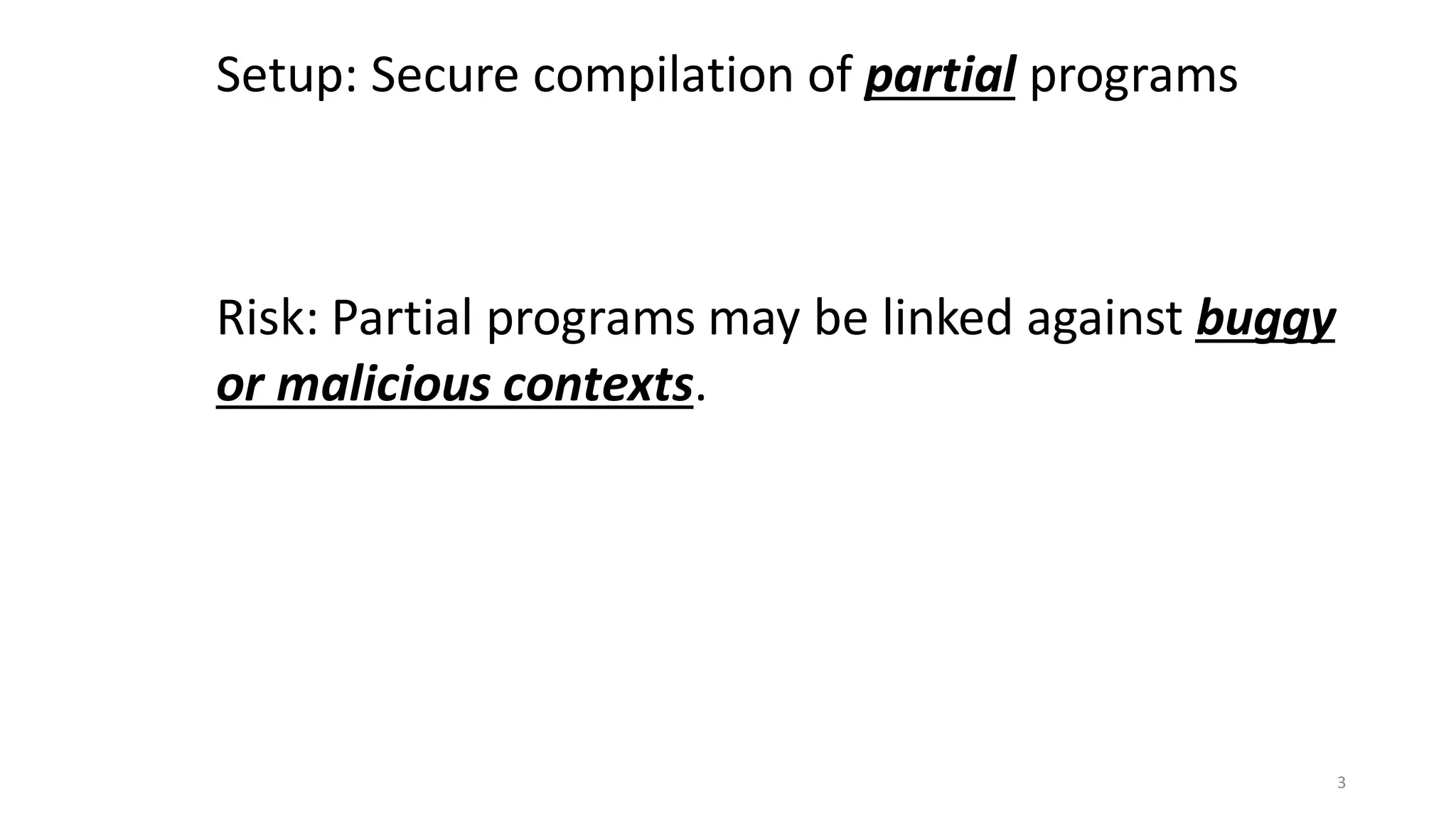

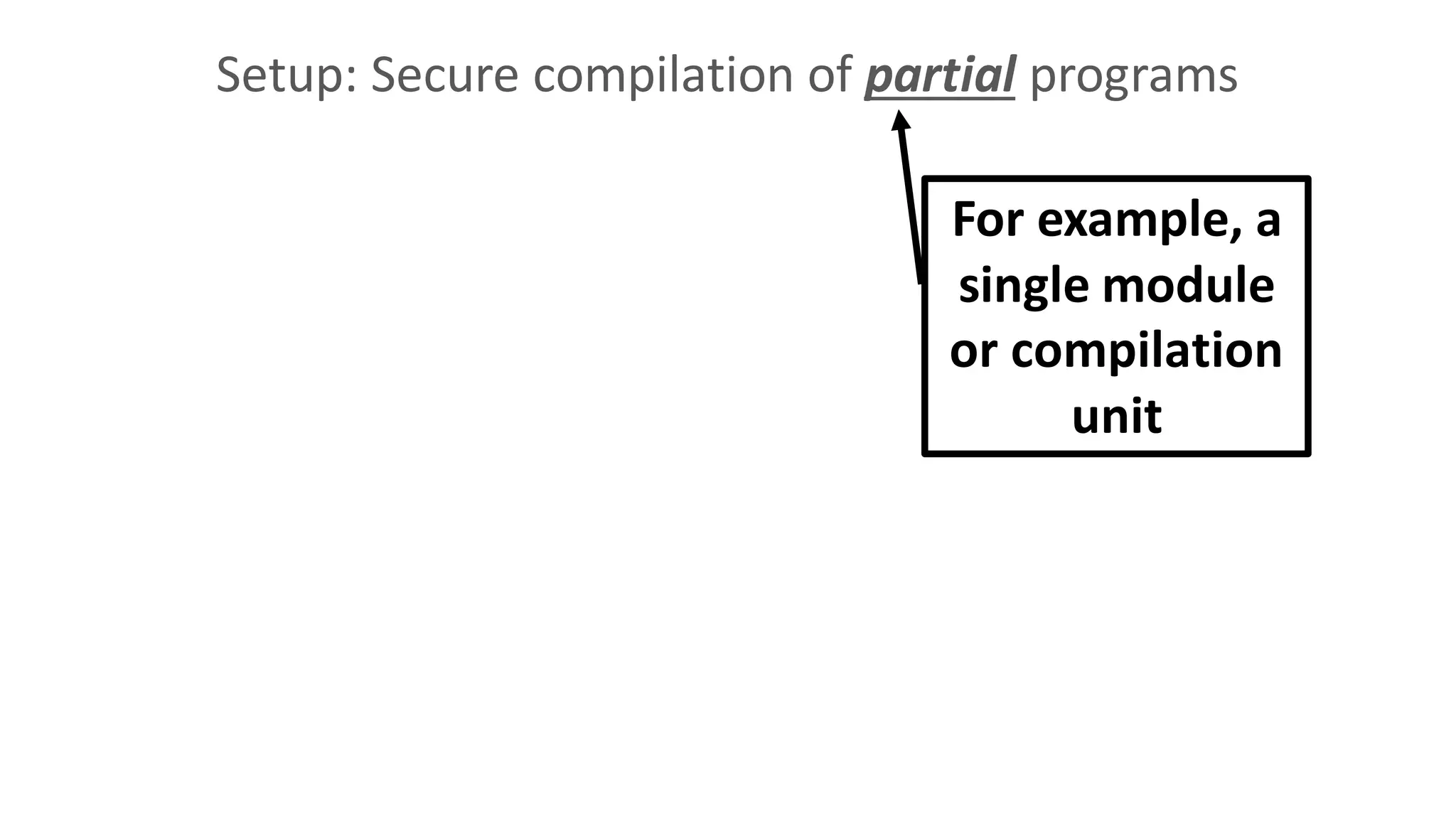
![Setup: Secure compilation of partial programs
import module Net
module Main {
char iobuffer[1024];
static long int user_balance_usd;
int main(void) {
Net.init_network(iobuffer)
Net.receive();
}
}](https://image.slidesharecdn.com/prisc-2022-220122131600/75/SecurePtrs-Proving-Secure-Compilation-with-Data-Flow-Back-Translation-and-Turn-Taking-Simulation-6-2048.jpg)
![Setup: Secure compilation of partial programs
import module Net
module Main {
char iobuffer[1024];
static long int user_balance_usd;
int main(void) {
Net.init_network(iobuffer)
Net.receive();
}
}
The context
implements it
The partial
program calls it](https://image.slidesharecdn.com/prisc-2022-220122131600/75/SecurePtrs-Proving-Secure-Compilation-with-Data-Flow-Back-Translation-and-Turn-Taking-Simulation-7-2048.jpg)
![Setup: Secure compilation of partial programs
import module Net
module Main {
char iobuffer[1024];
static long int user_balance_usd;
int main(void) {
Net.init_network(iobuffer)
Net.receive();
}
}
The partial program
intentionally shares
the array with the
context](https://image.slidesharecdn.com/prisc-2022-220122131600/75/SecurePtrs-Proving-Secure-Compilation-with-Data-Flow-Back-Translation-and-Turn-Taking-Simulation-8-2048.jpg)
![Setup: Secure compilation of partial programs
import module Net
module Main {
char iobuffer[1024];
static long int user_balance_usd;
int main(void) {
Net.init_network(iobuffer)
Net.receive();
}
}
The partial program
NEVER shares the
user balance with
the context](https://image.slidesharecdn.com/prisc-2022-220122131600/75/SecurePtrs-Proving-Secure-Compilation-with-Data-Flow-Back-Translation-and-Turn-Taking-Simulation-9-2048.jpg)
![Setup: Secure compilation of partial programs
import module Net
module Main {
char iobuffer[1024];
static long int user_balance_usd;
int main(void) {
Net.init_network(iobuffer)
Net.receive();
}
}
The partial program
NEVER shares the
user balance with
the context
Intention is that
user balance is
"high integrity"](https://image.slidesharecdn.com/prisc-2022-220122131600/75/SecurePtrs-Proving-Secure-Compilation-with-Data-Flow-Back-Translation-and-Turn-Taking-Simulation-10-2048.jpg)
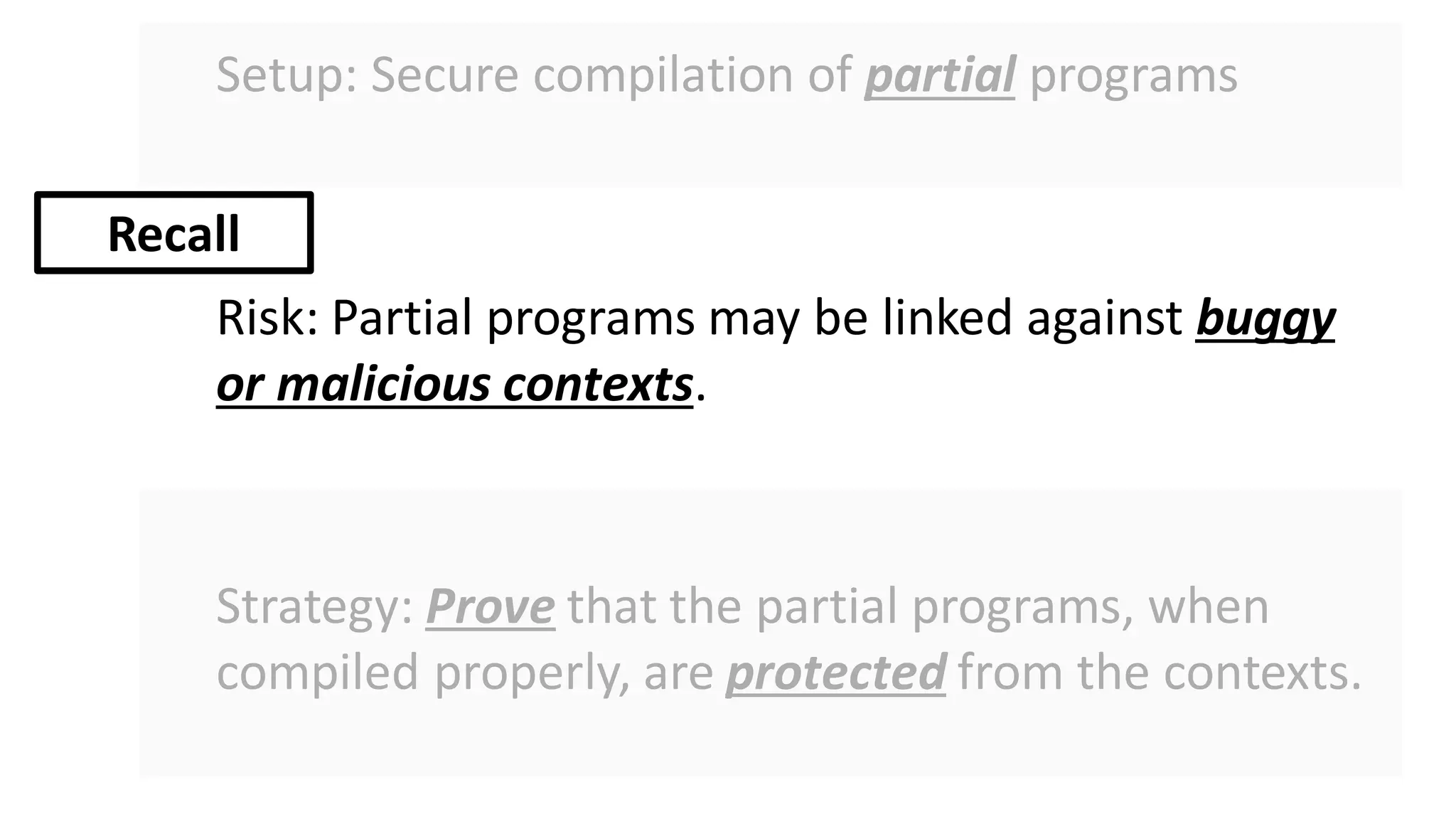
![Intention is that
user balance is
"high integrity"
Setup: Secure compilation of partial programs
import module Net
module Main {
char iobuffer[1024];
static long int user_balance_usd;
int main(void) {
Net.init_network(iobuffer)
Net.receive();
}
}
The partial program
NEVER shares the
user balance with
the context
A buggy/malicious
context
might access the
user balance](https://image.slidesharecdn.com/prisc-2022-220122131600/75/SecurePtrs-Proving-Secure-Compilation-with-Data-Flow-Back-Translation-and-Turn-Taking-Simulation-12-2048.jpg)
![Setup: Secure compilation of partial programs
import module Net
module Main {
char iobuffer[1024];
static long int user_balance_usd;
int main(void) {
Net.init_network(iobuffer)
Net.receive();
}
}
A buggy/malicious
context
might access the
user balance
r1
init_network:
addi $r1 $r_arg 1024
sw $r2 0($r1)
OVERWRITE](https://image.slidesharecdn.com/prisc-2022-220122131600/75/SecurePtrs-Proving-Secure-Compilation-with-Data-Flow-Back-Translation-and-Turn-Taking-Simulation-13-2048.jpg)
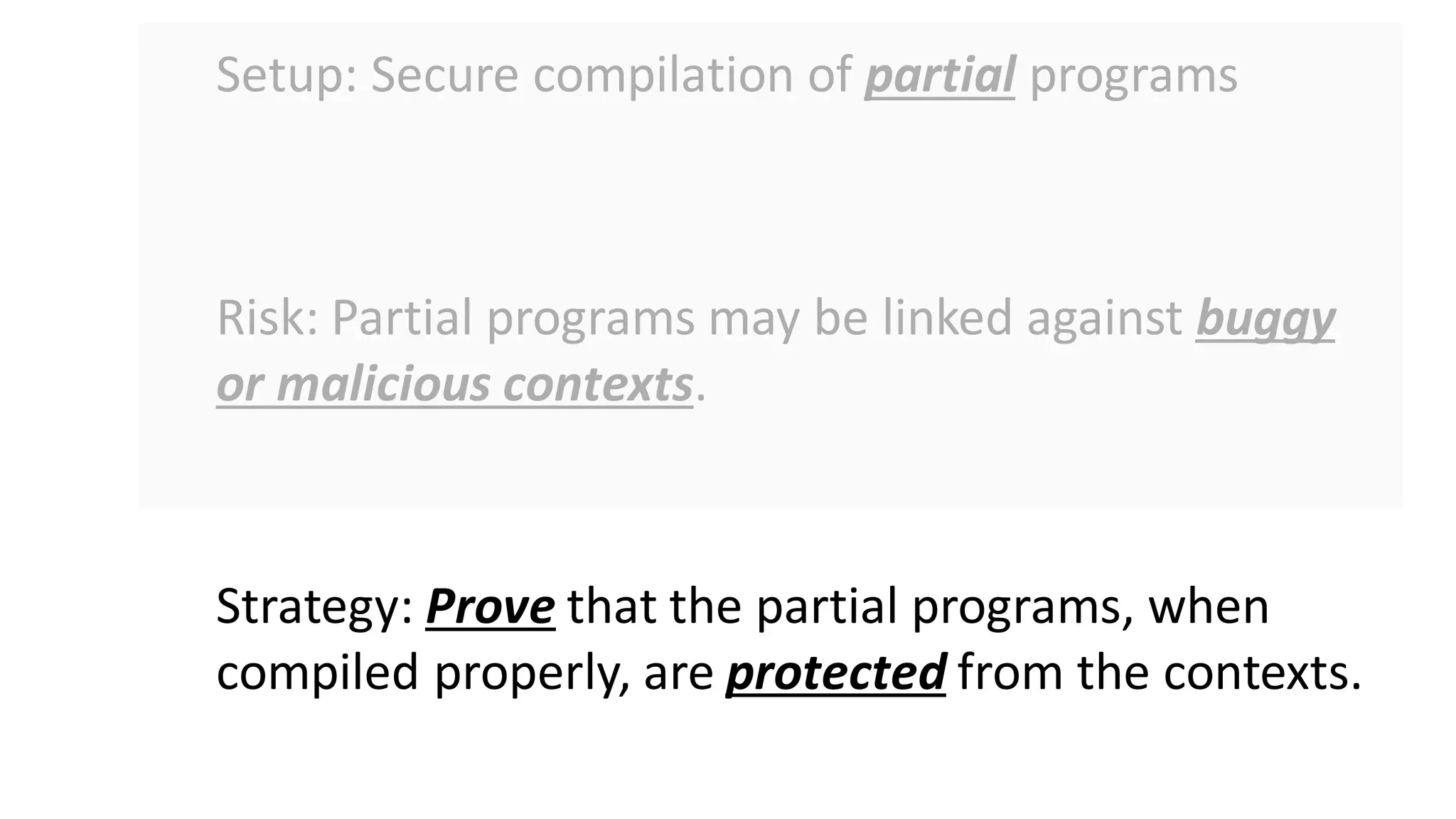
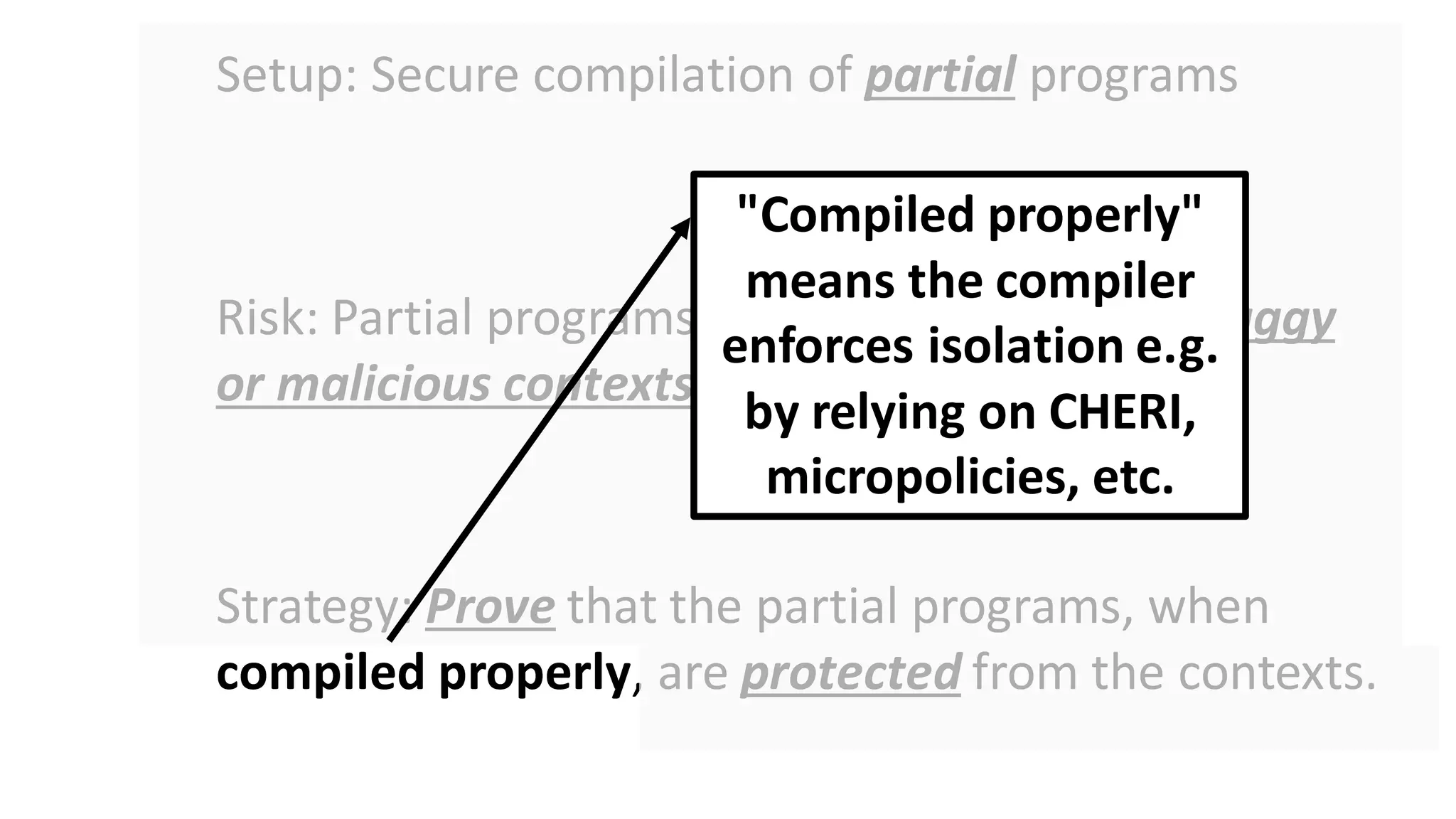

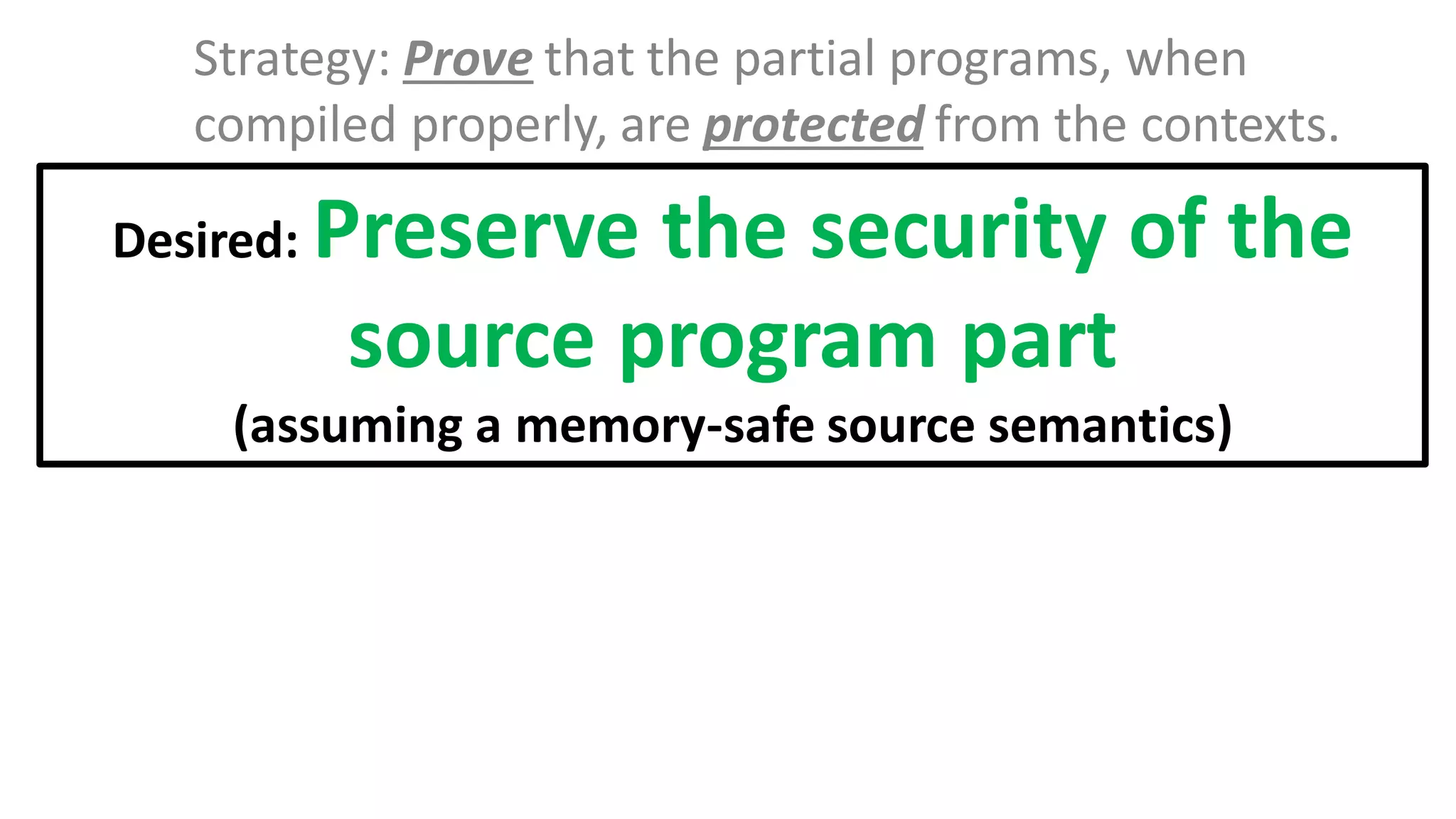
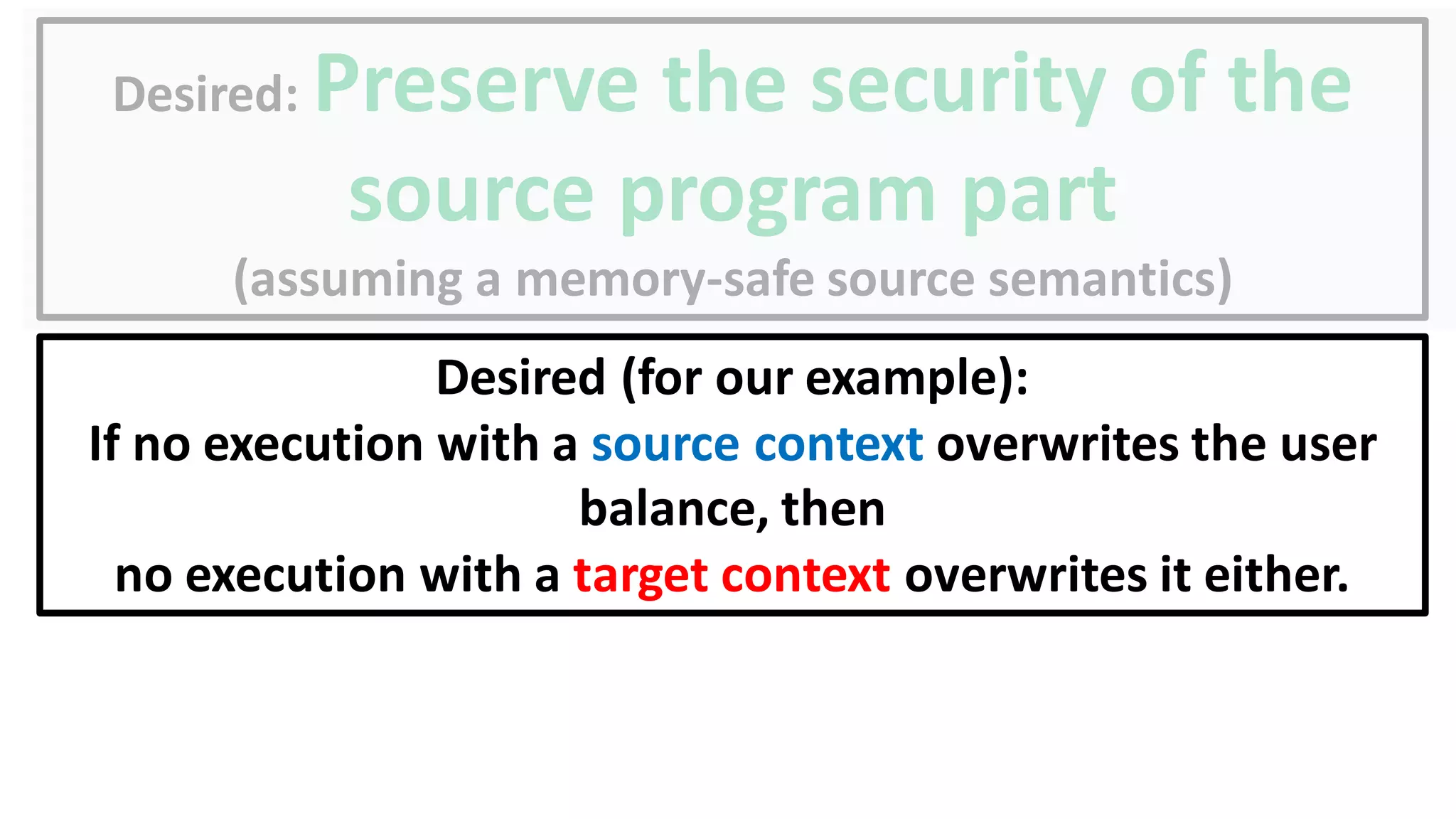
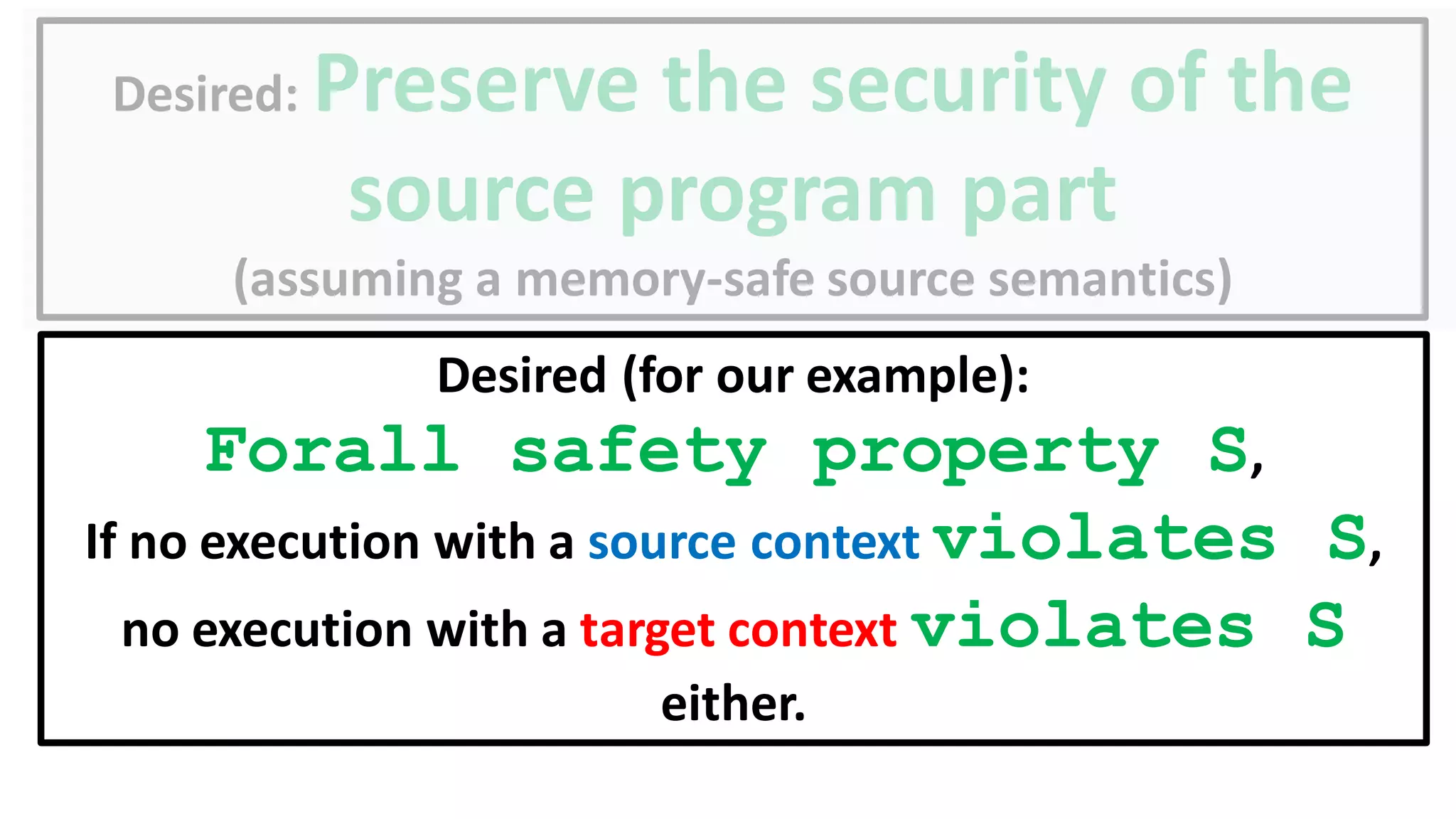
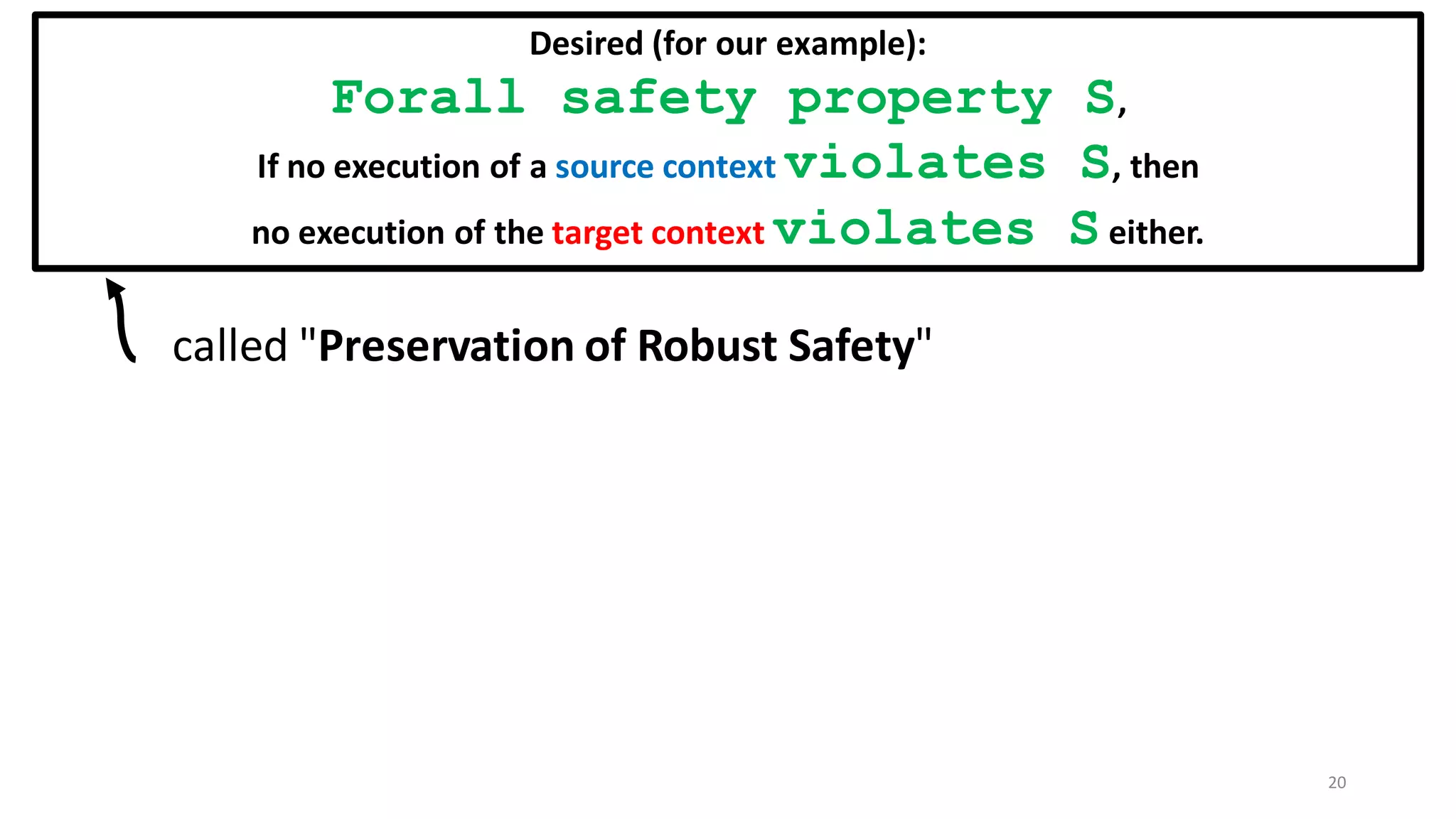
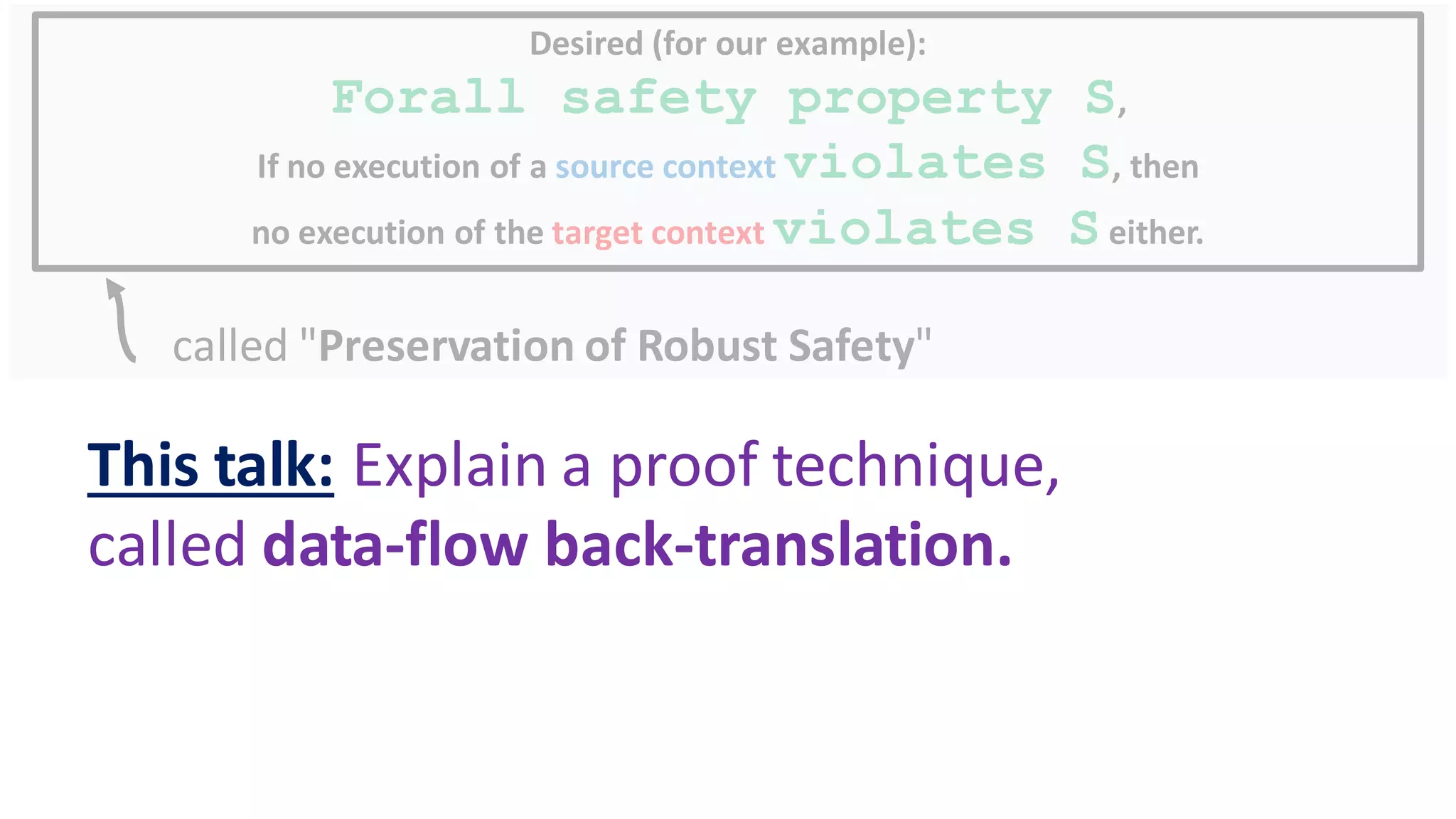
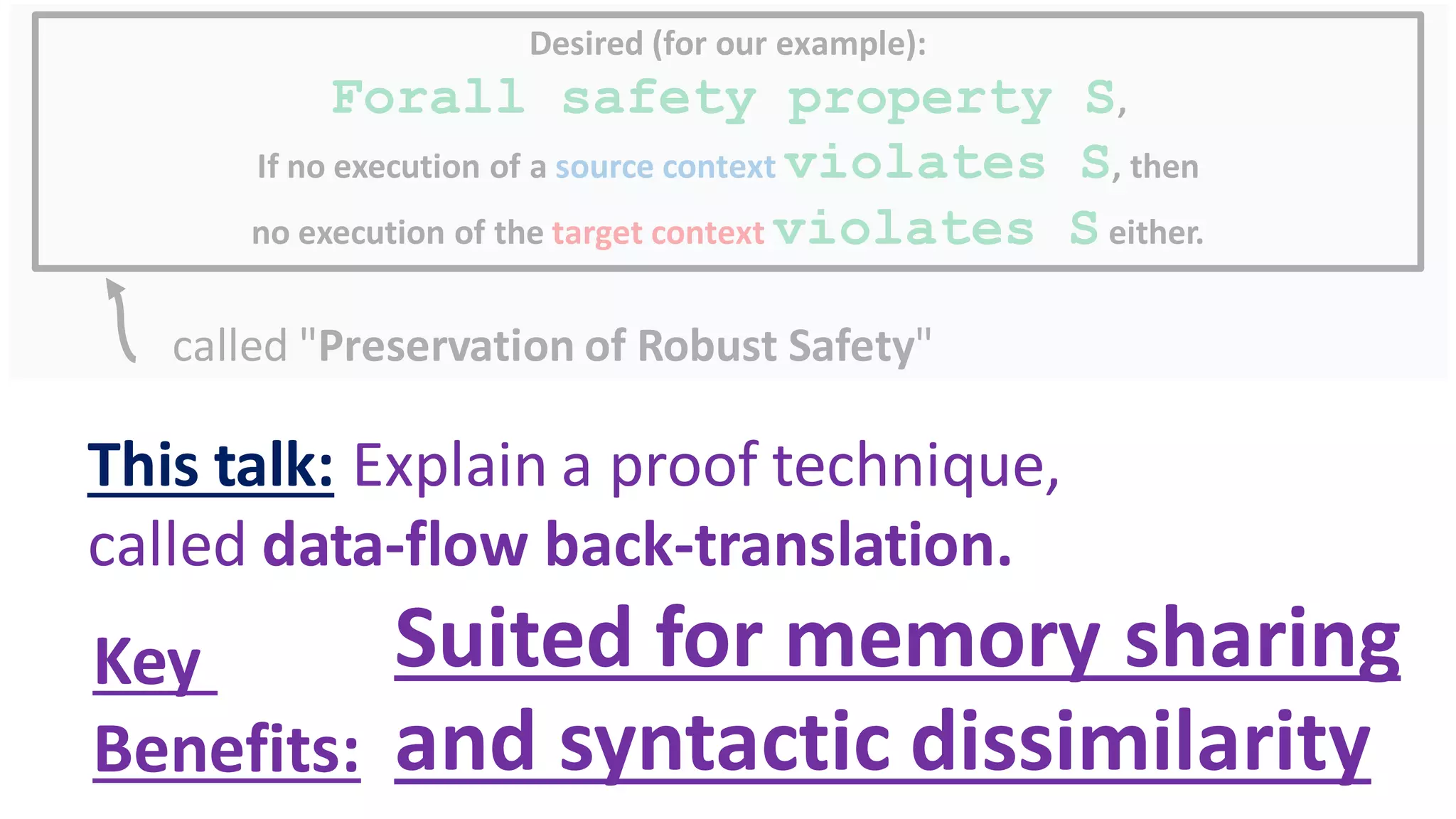
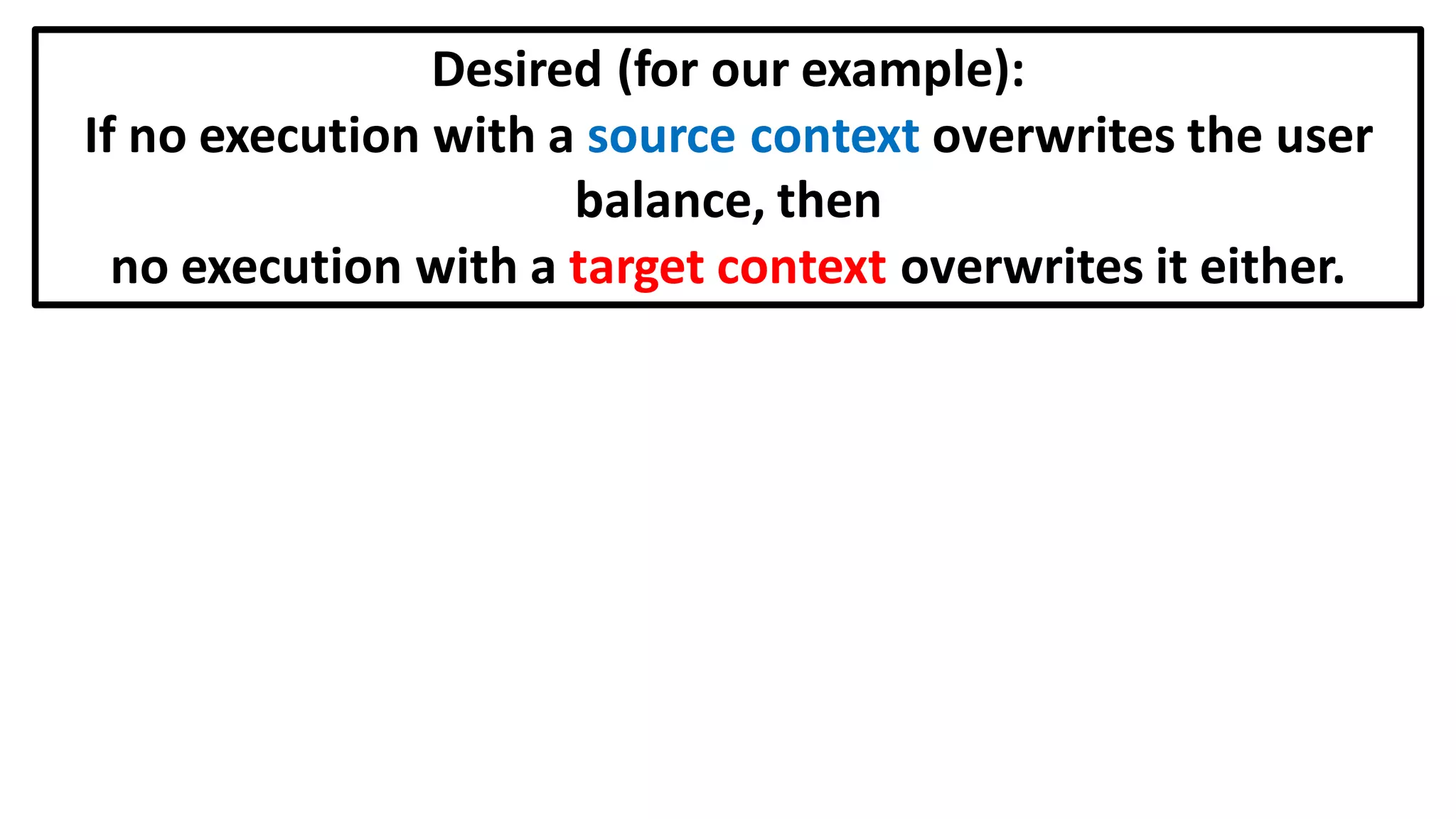
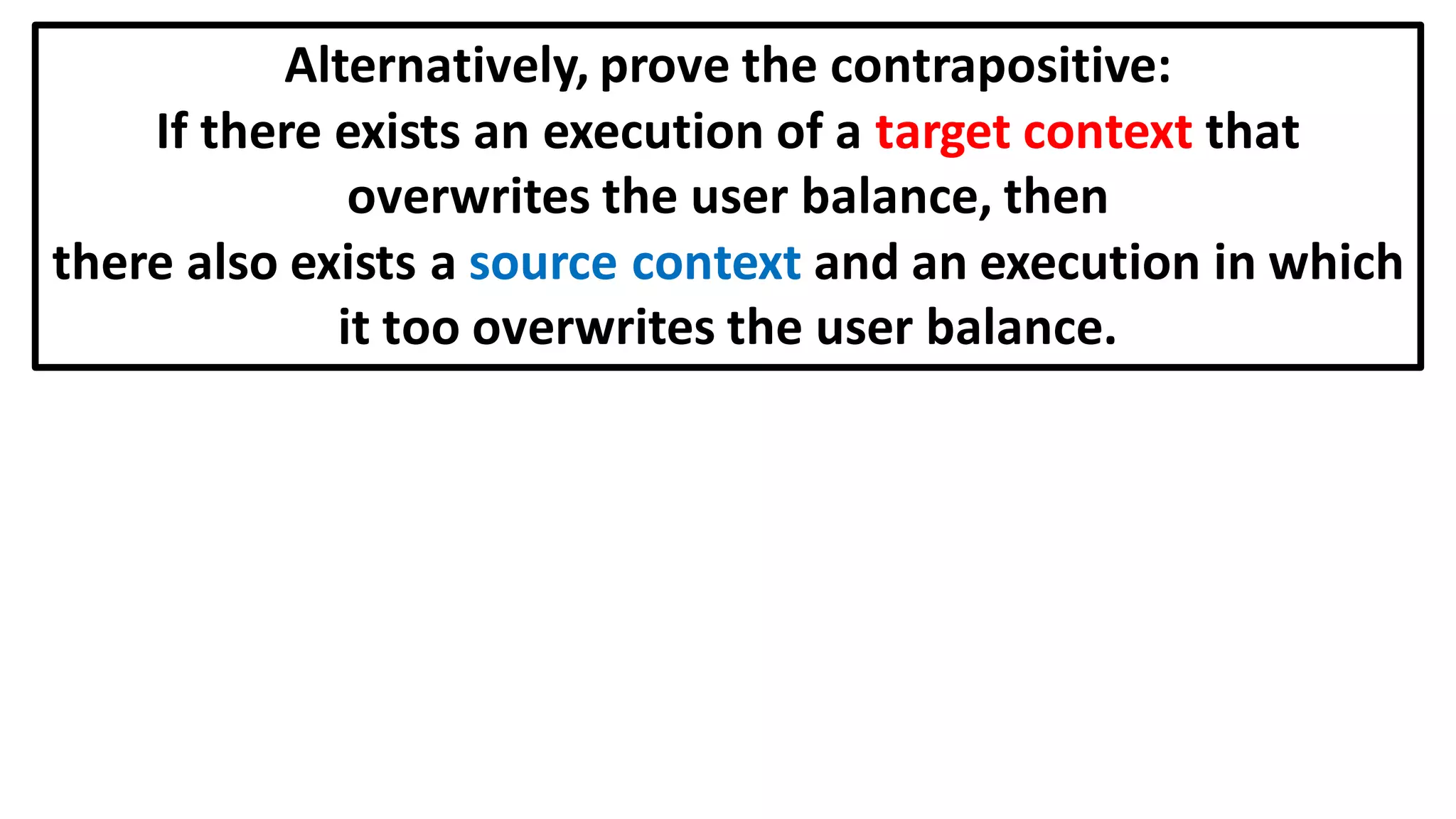
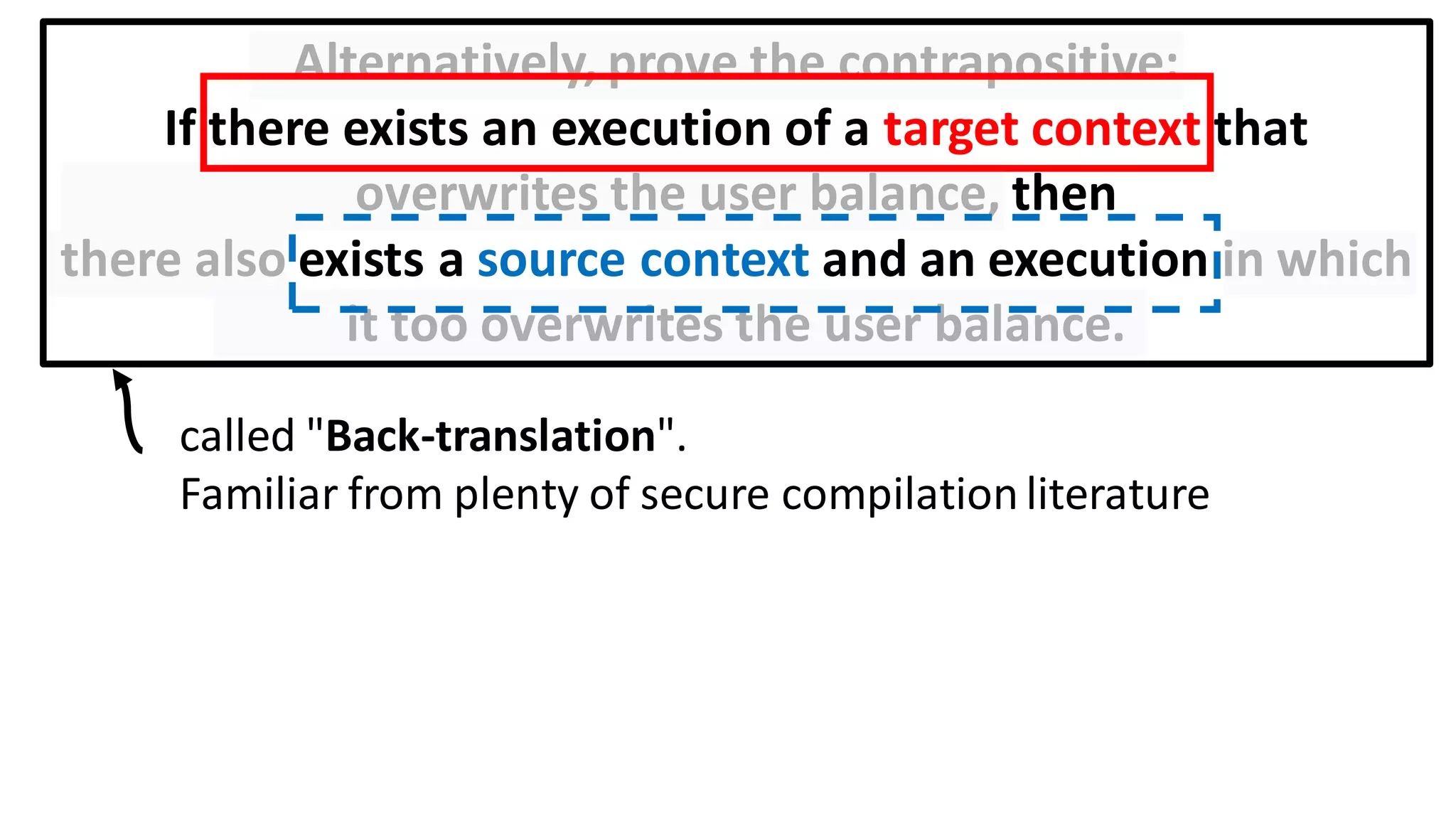
![Alternatively, prove the contrapositive:
If there exists an execution of a target context that
overwrites the user balance, then
there also exists a source context and an execution in which
it too overwrites the user balance.
Can prove a back-translation lemma about just whole programs
[Abate et al. 2018 "When good components go bad"]:
If there exists an execution of a whole target program, then
there exists a whole source program and a related execution.](https://image.slidesharecdn.com/prisc-2022-220122131600/75/SecurePtrs-Proving-Secure-Compilation-with-Data-Flow-Back-Translation-and-Turn-Taking-Simulation-26-2048.jpg)


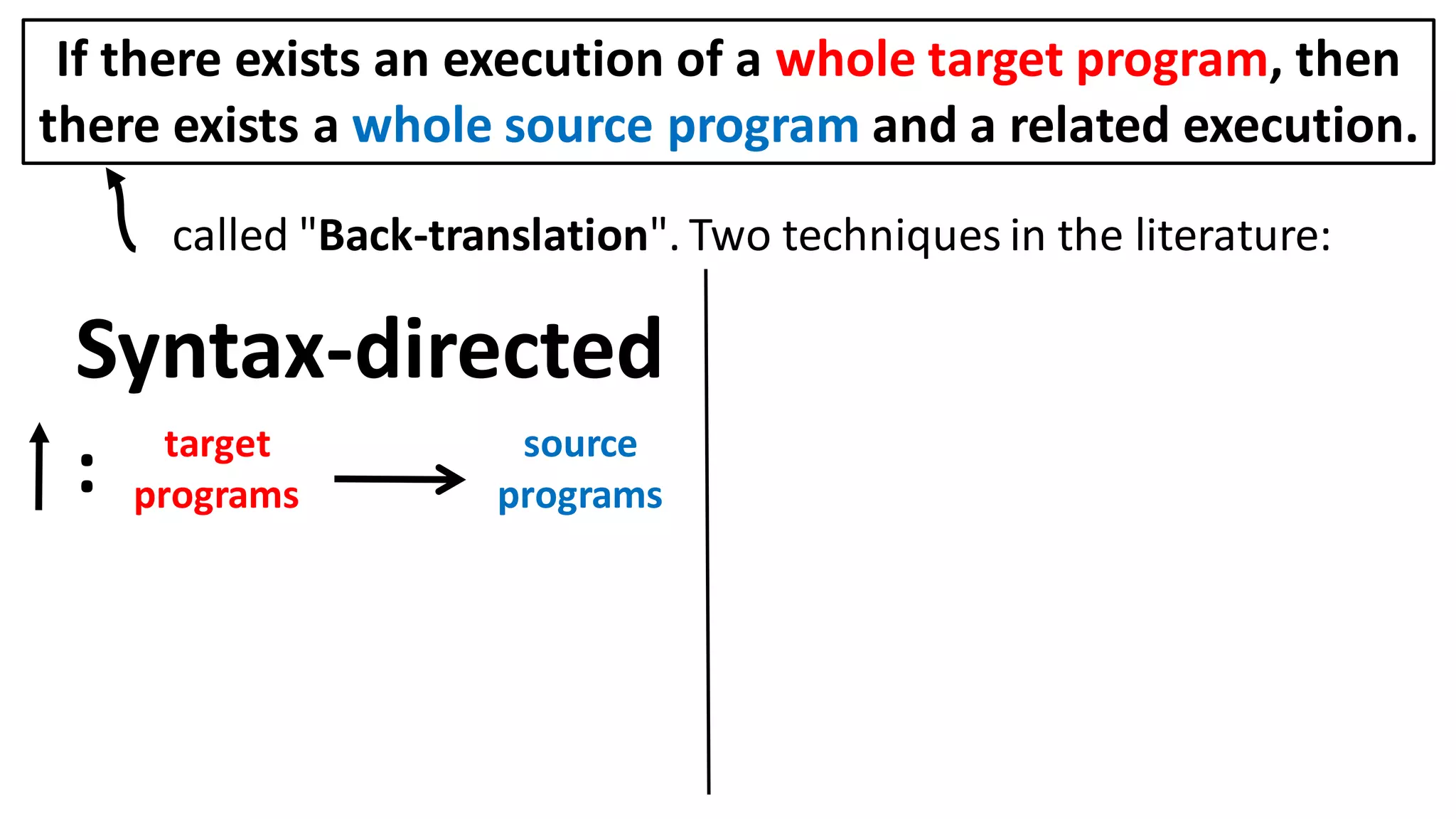
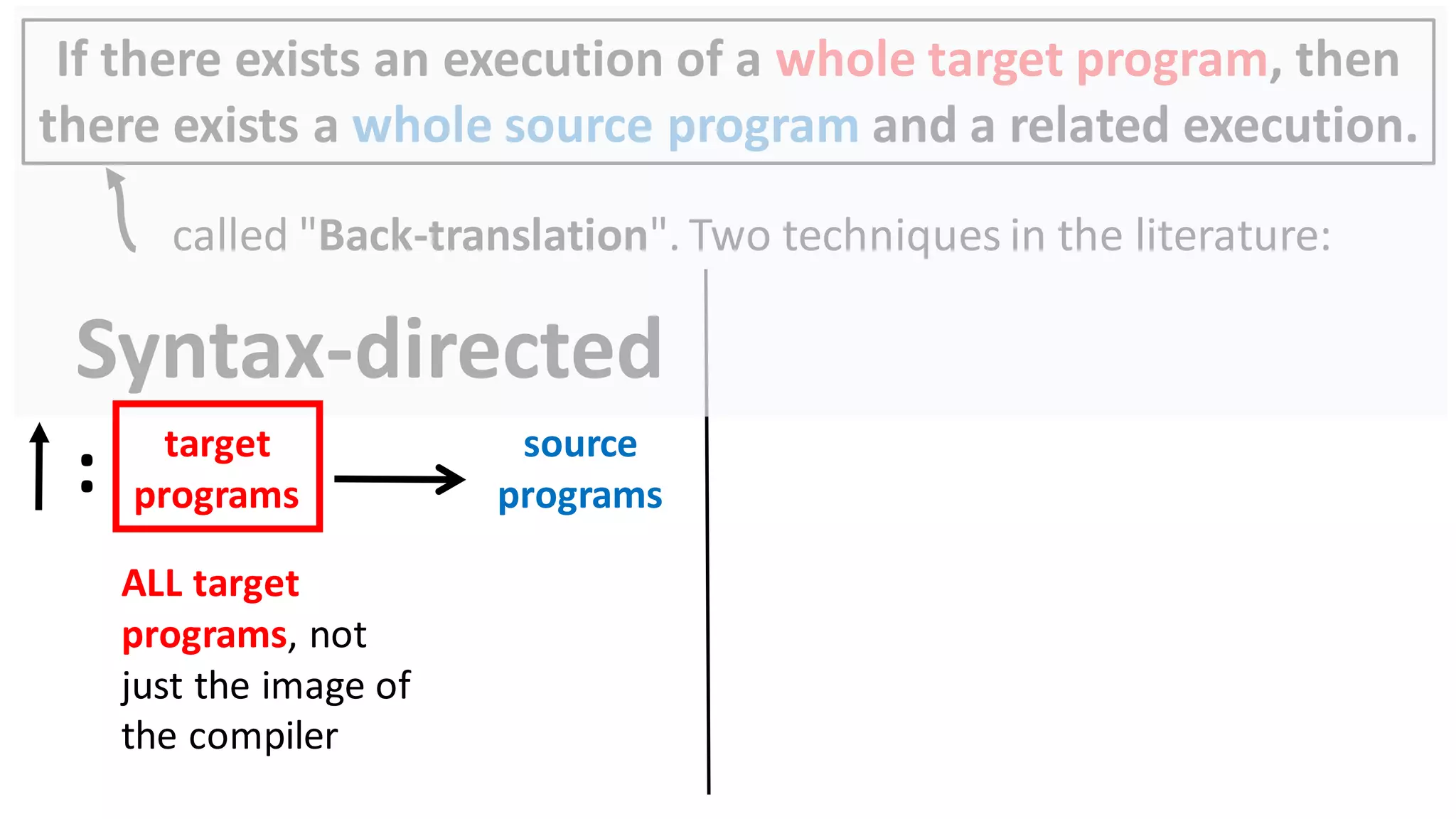
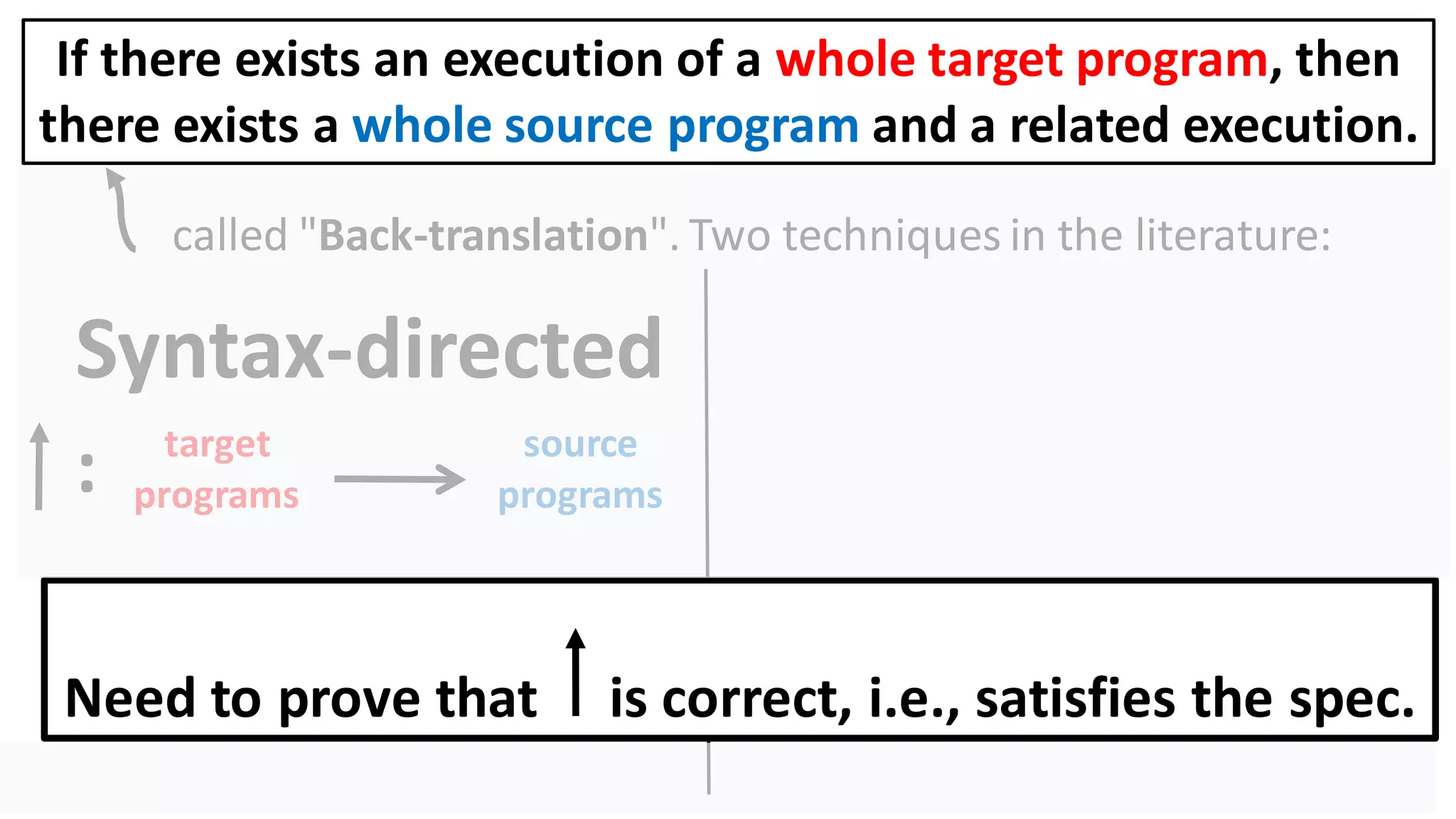
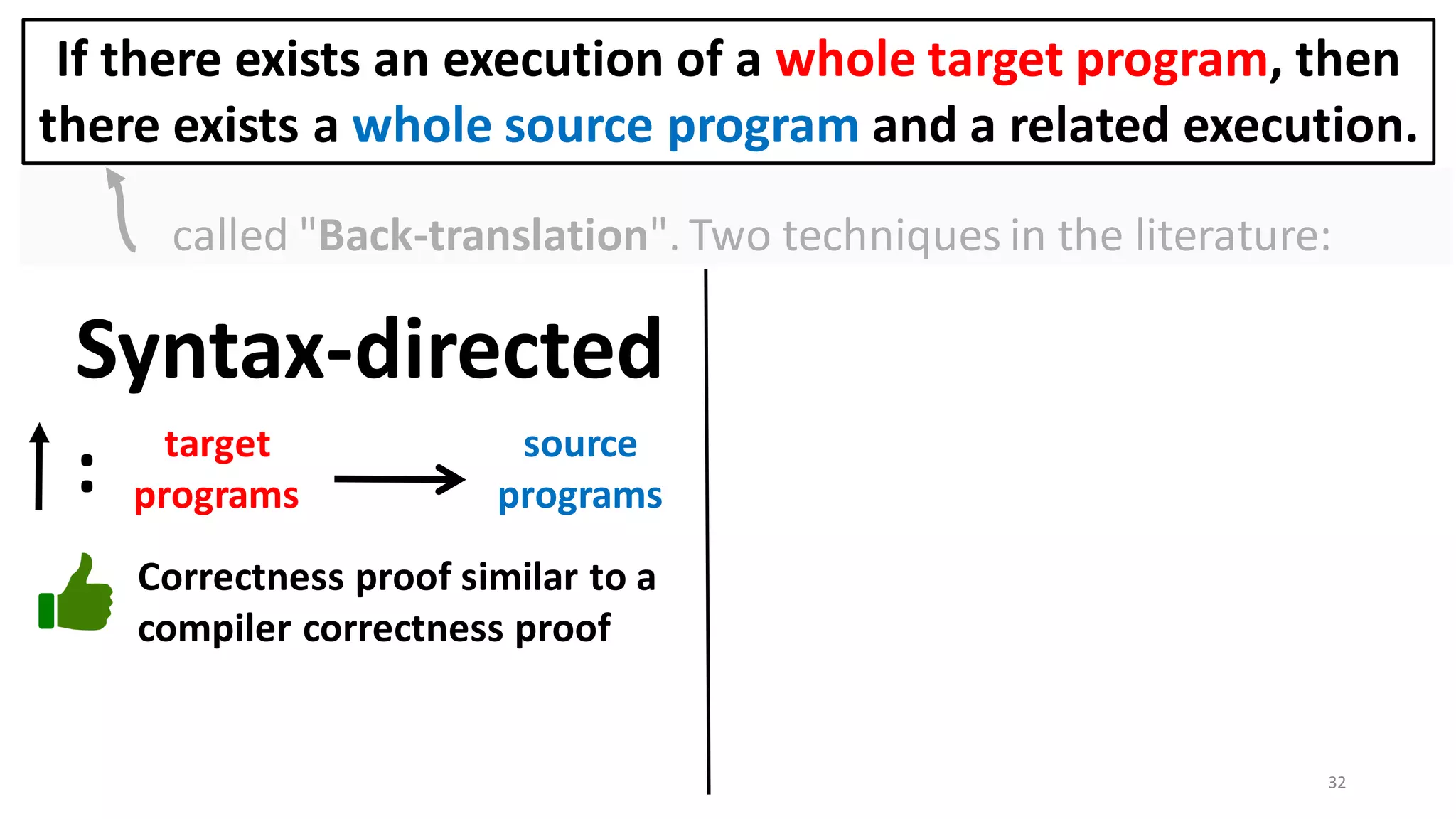
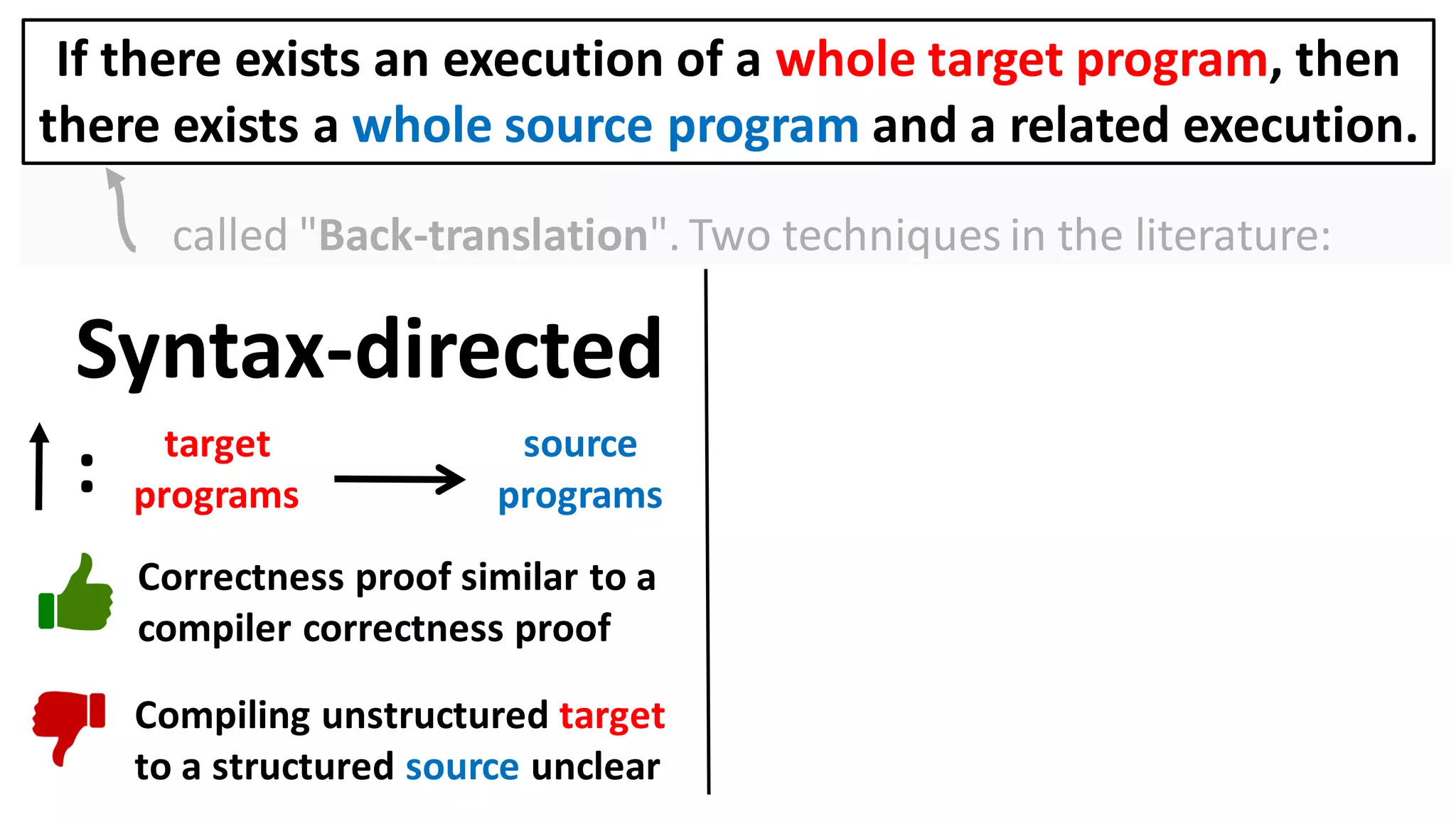
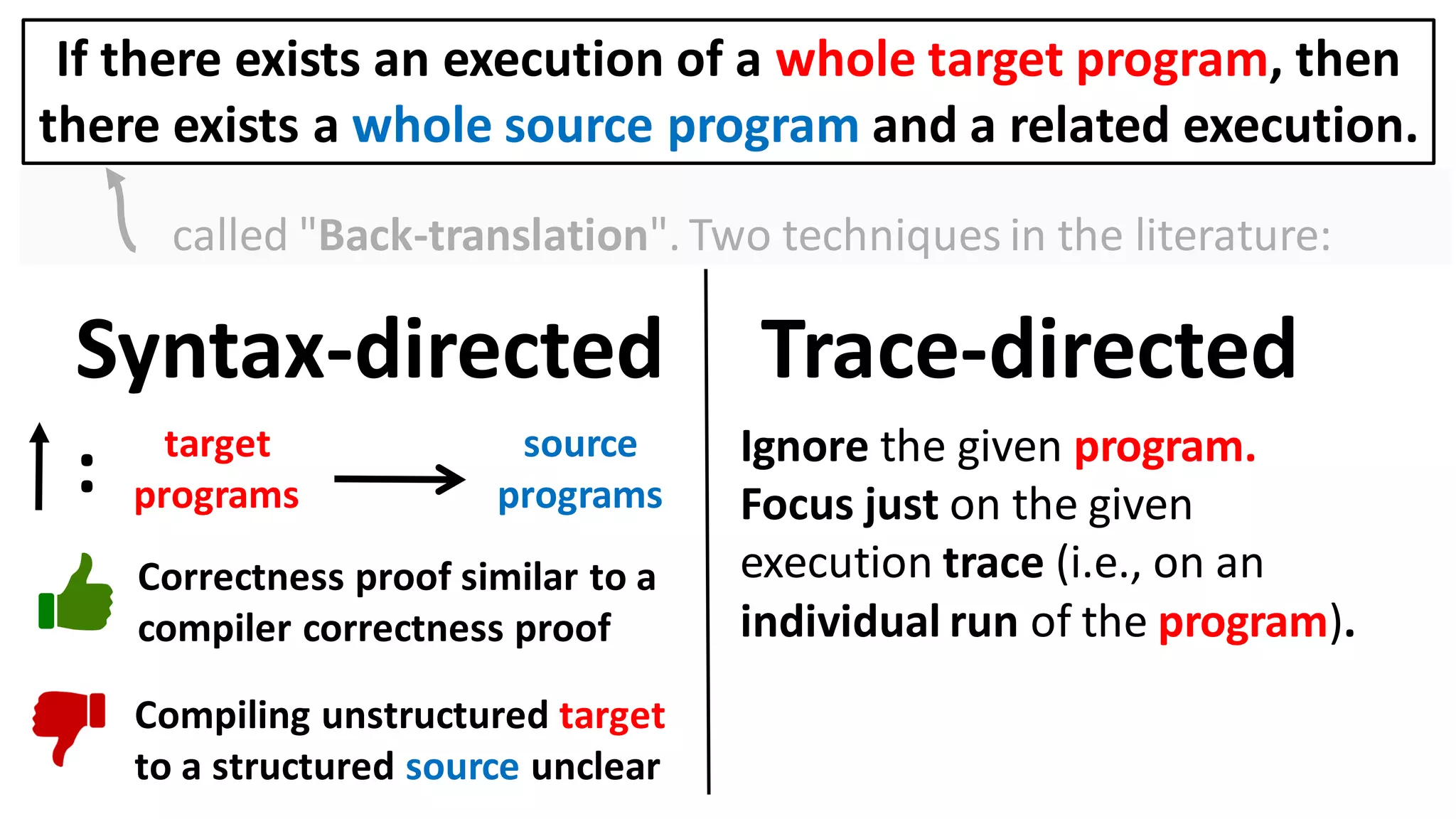
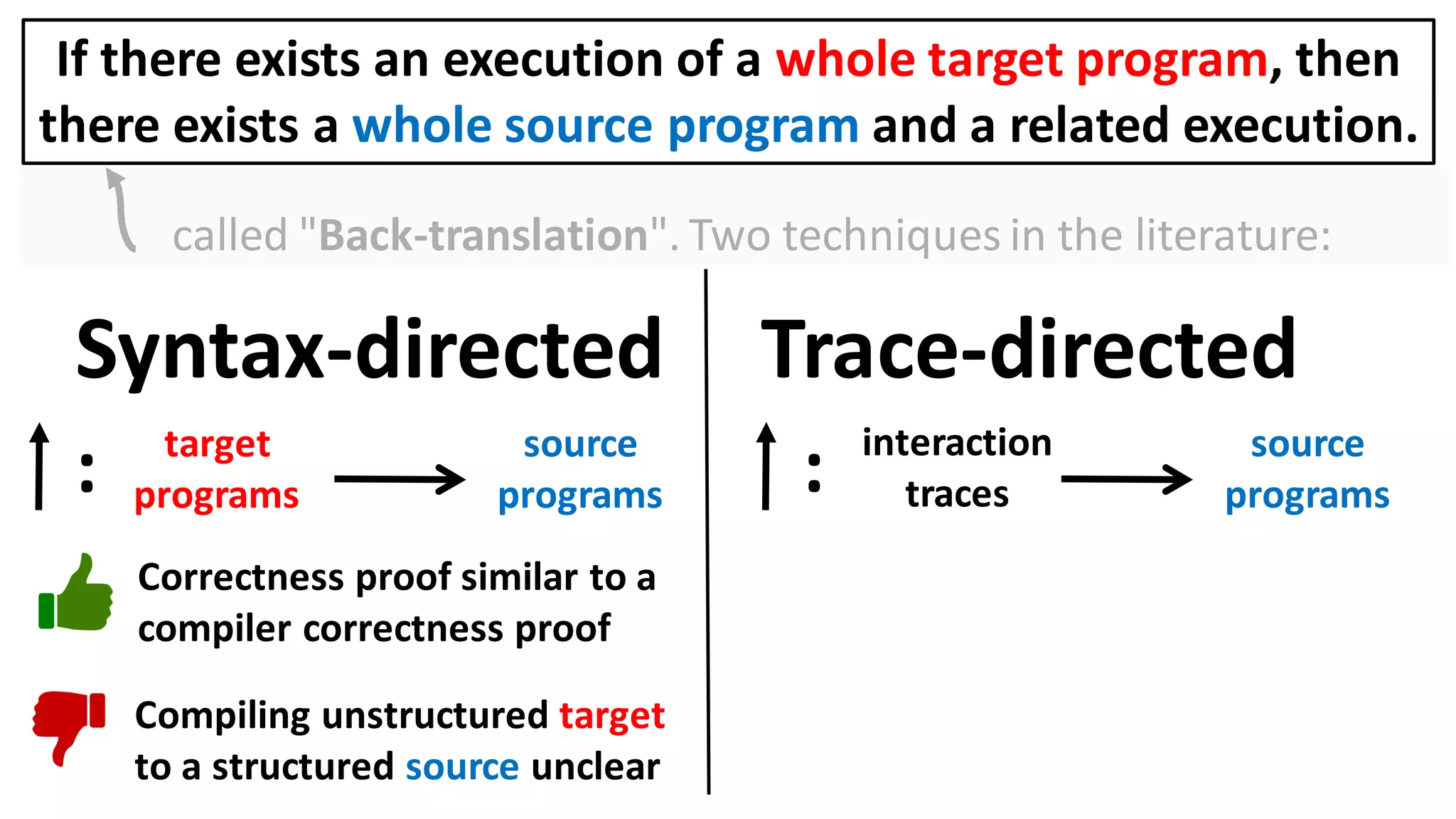
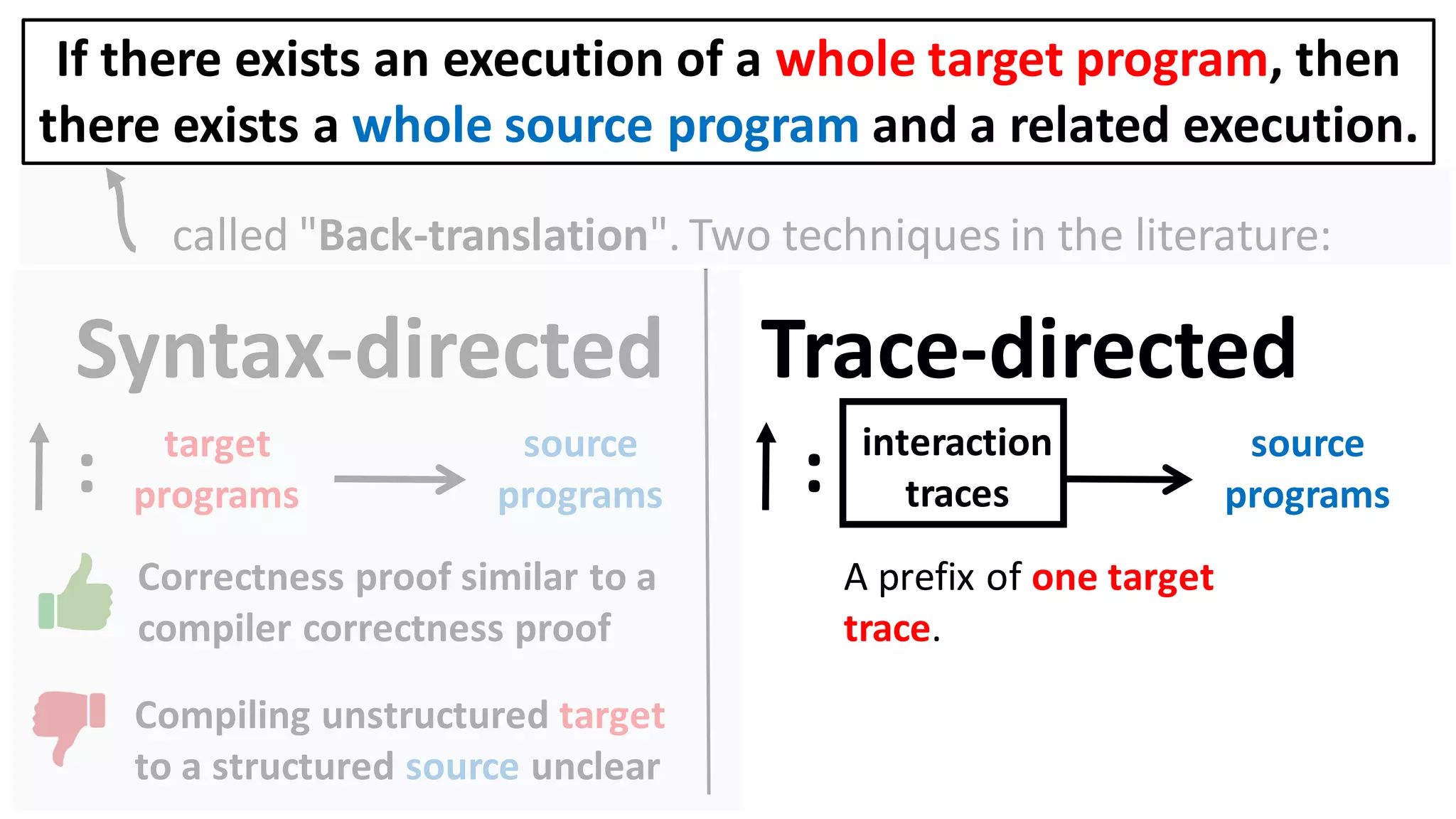
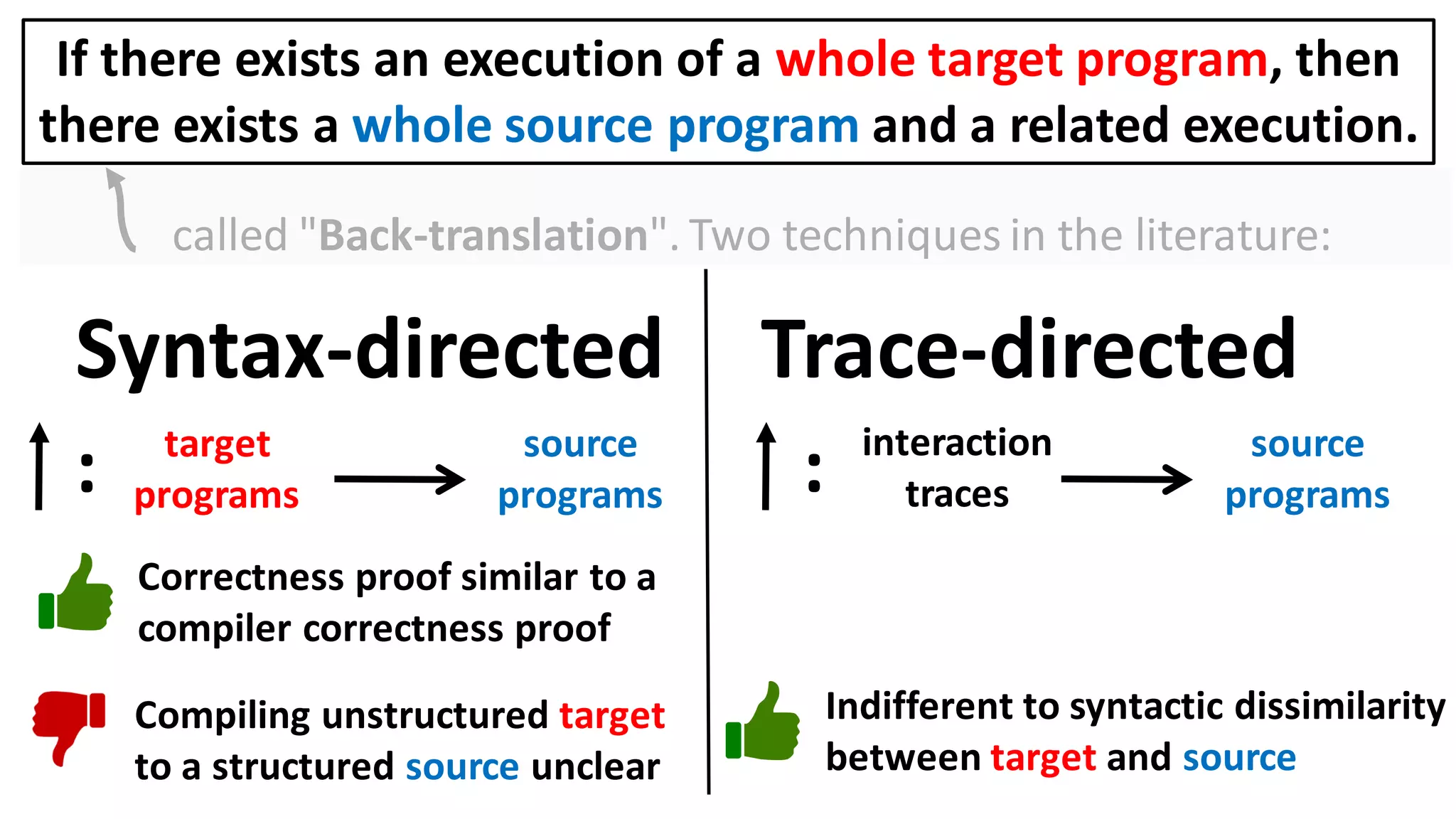
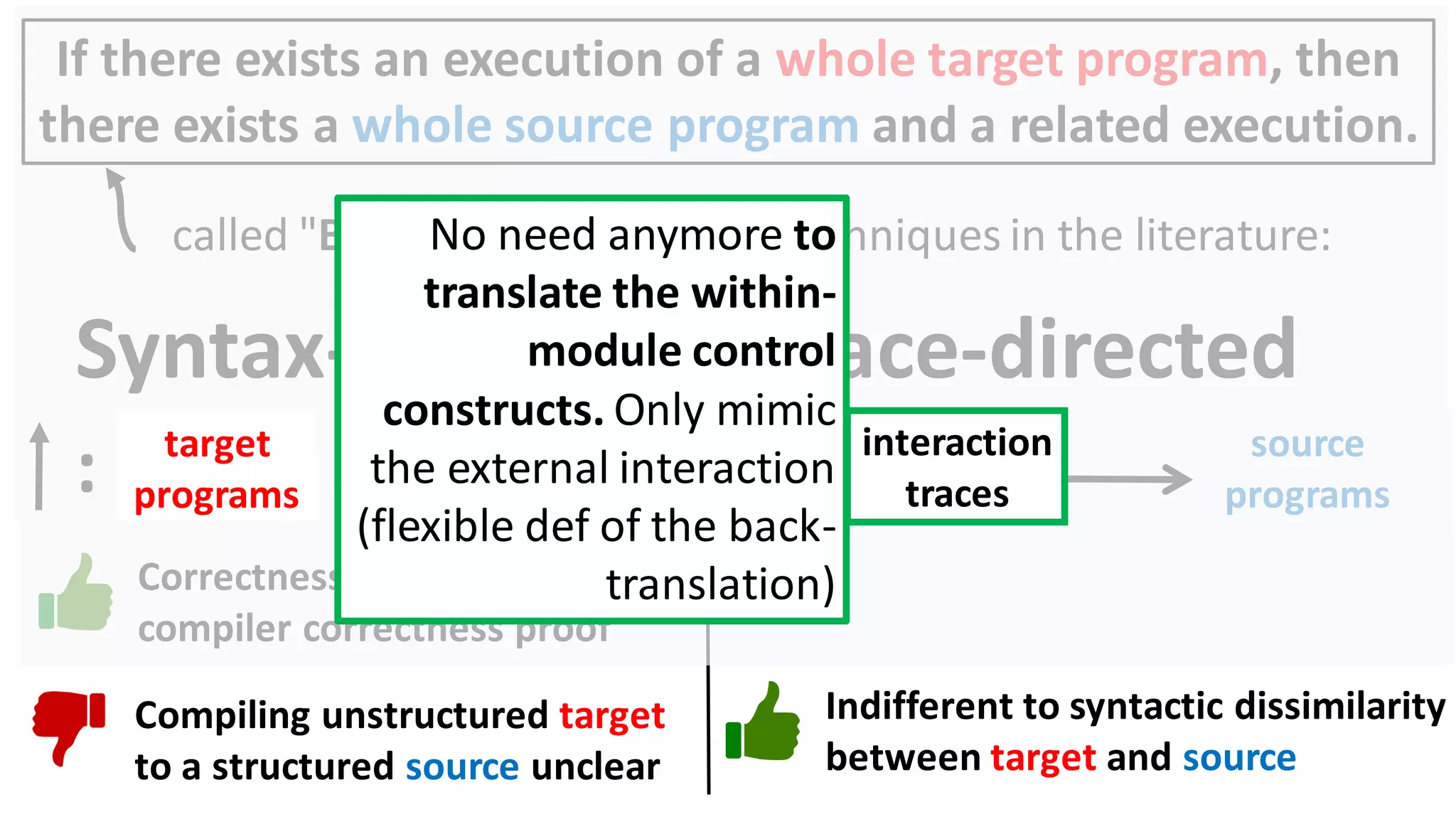
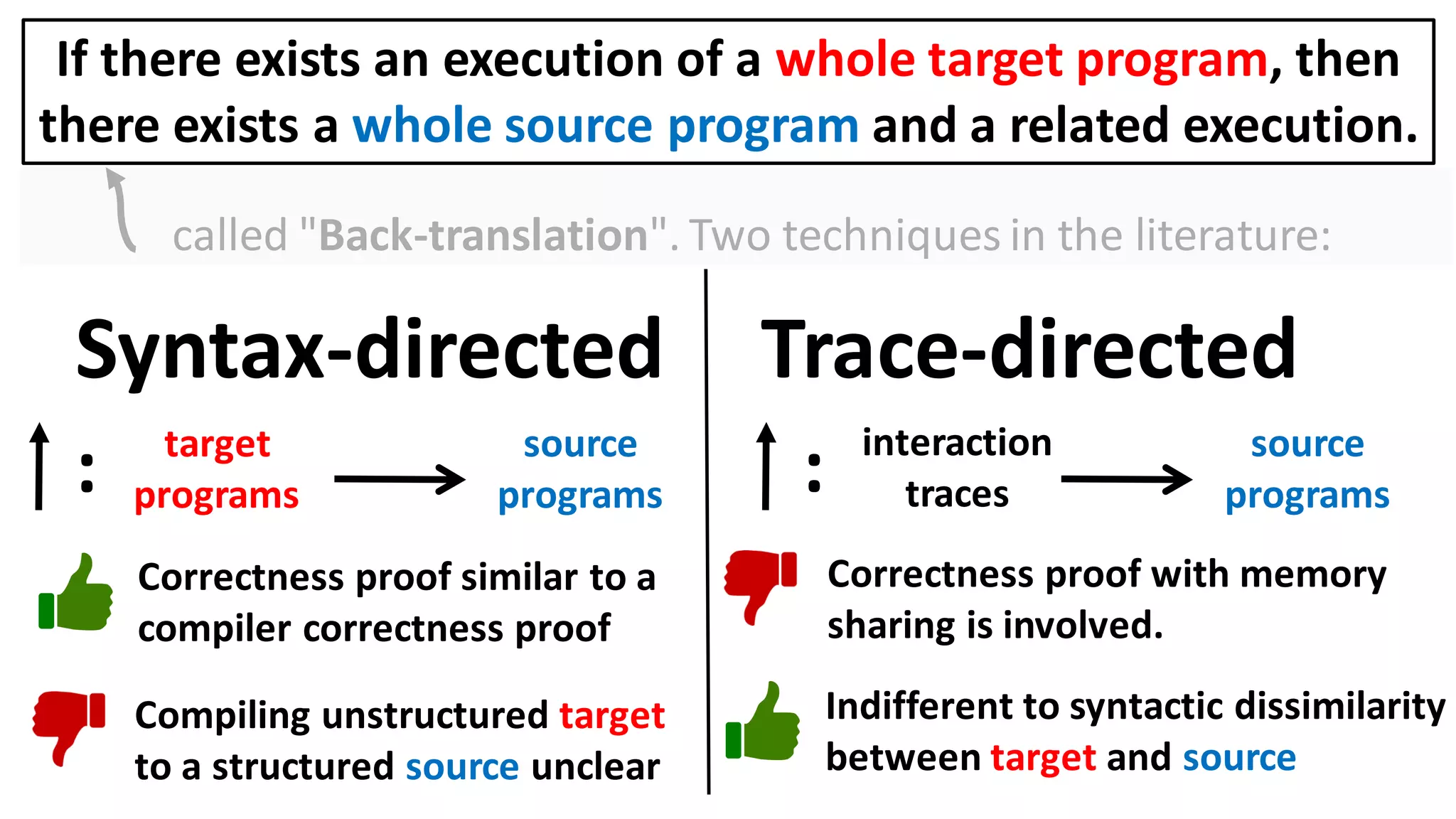

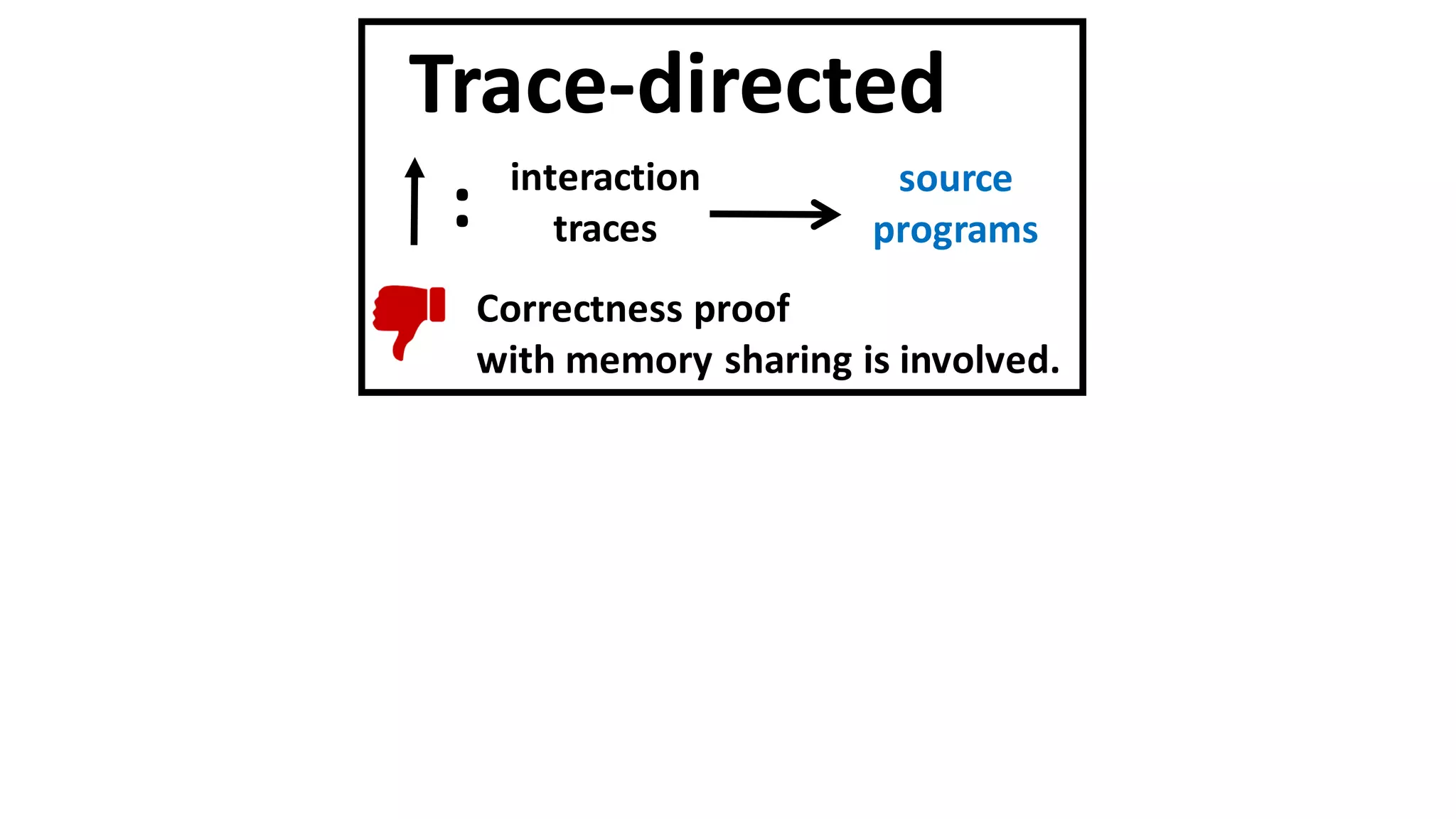
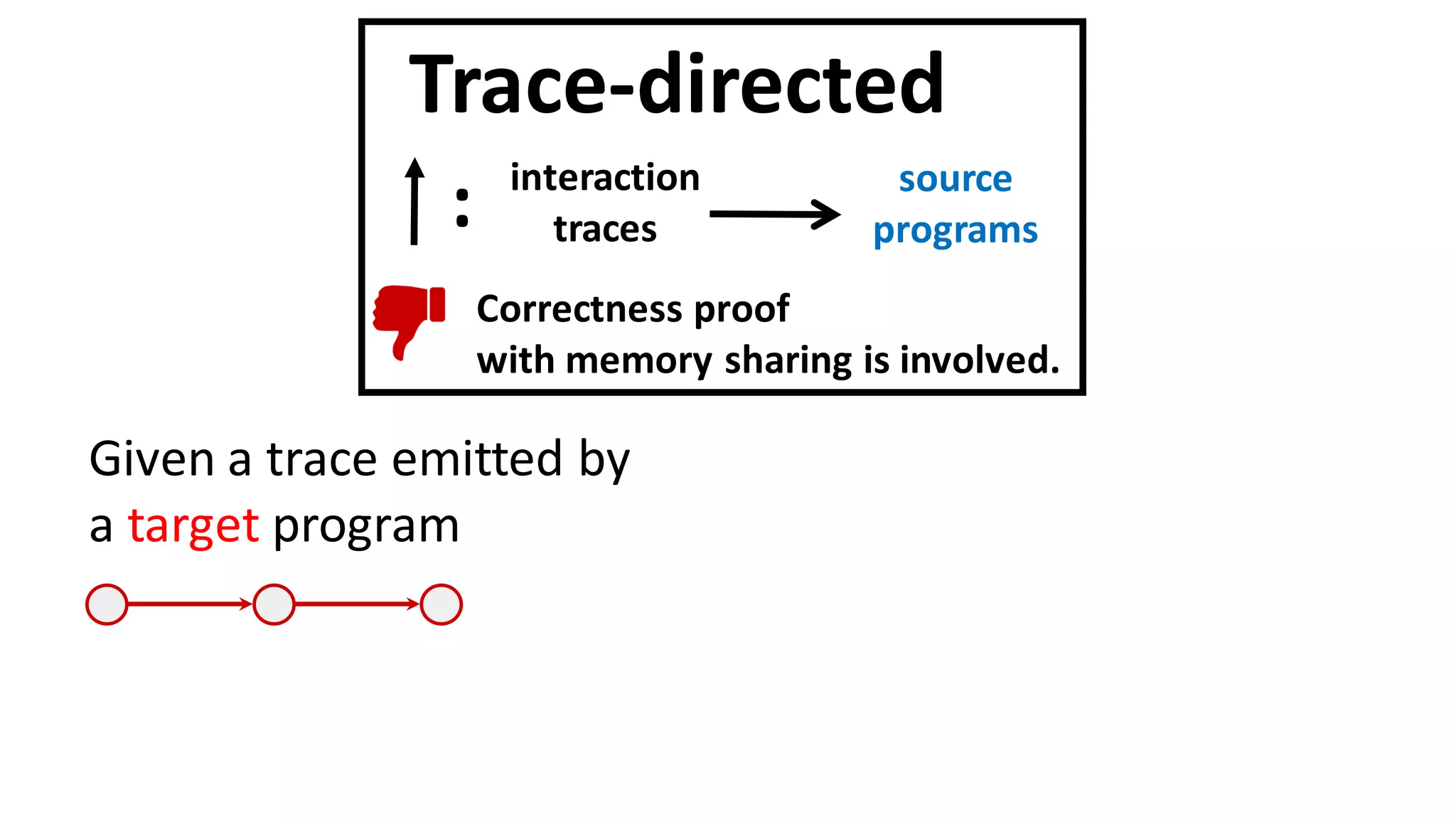
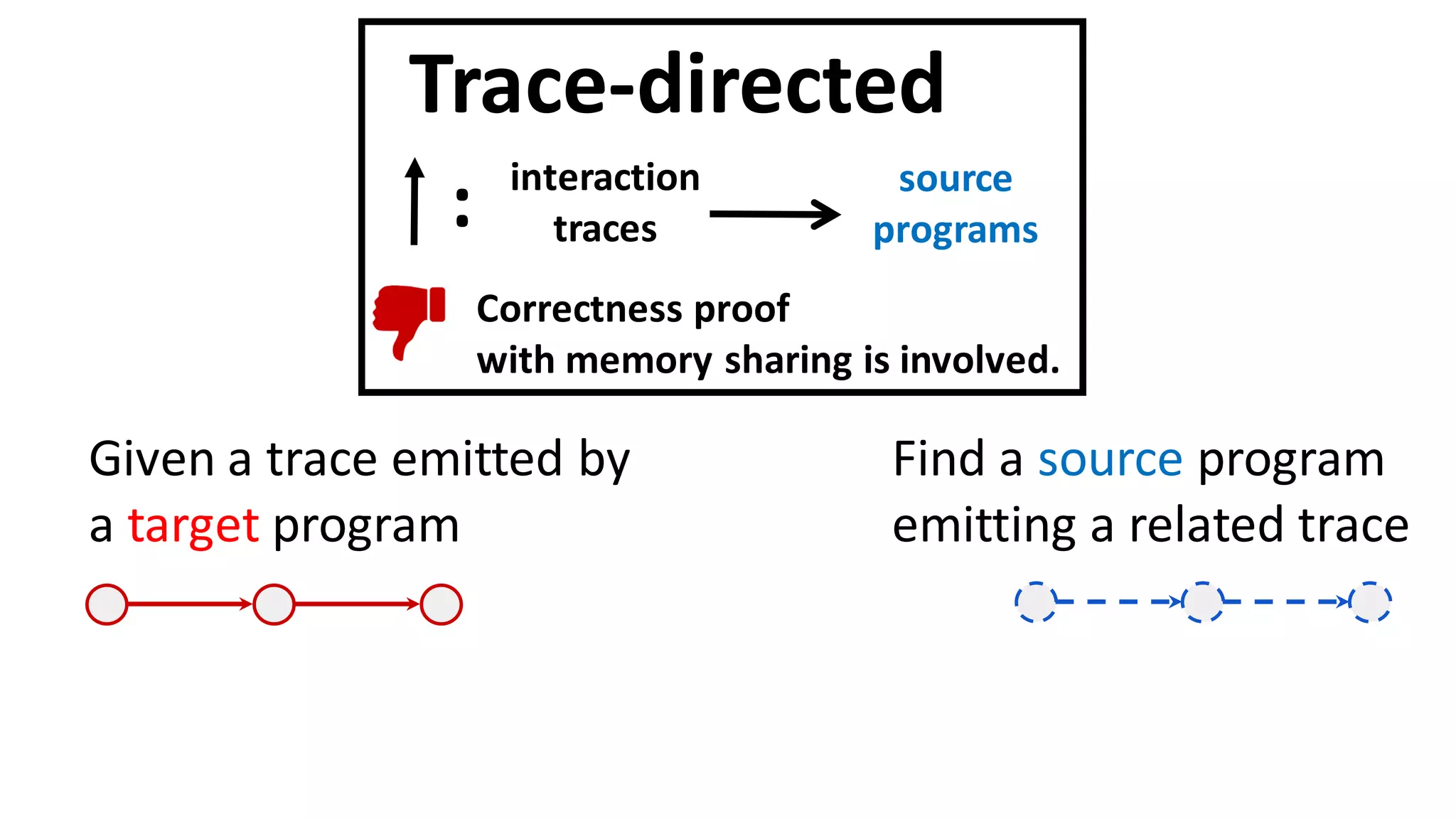
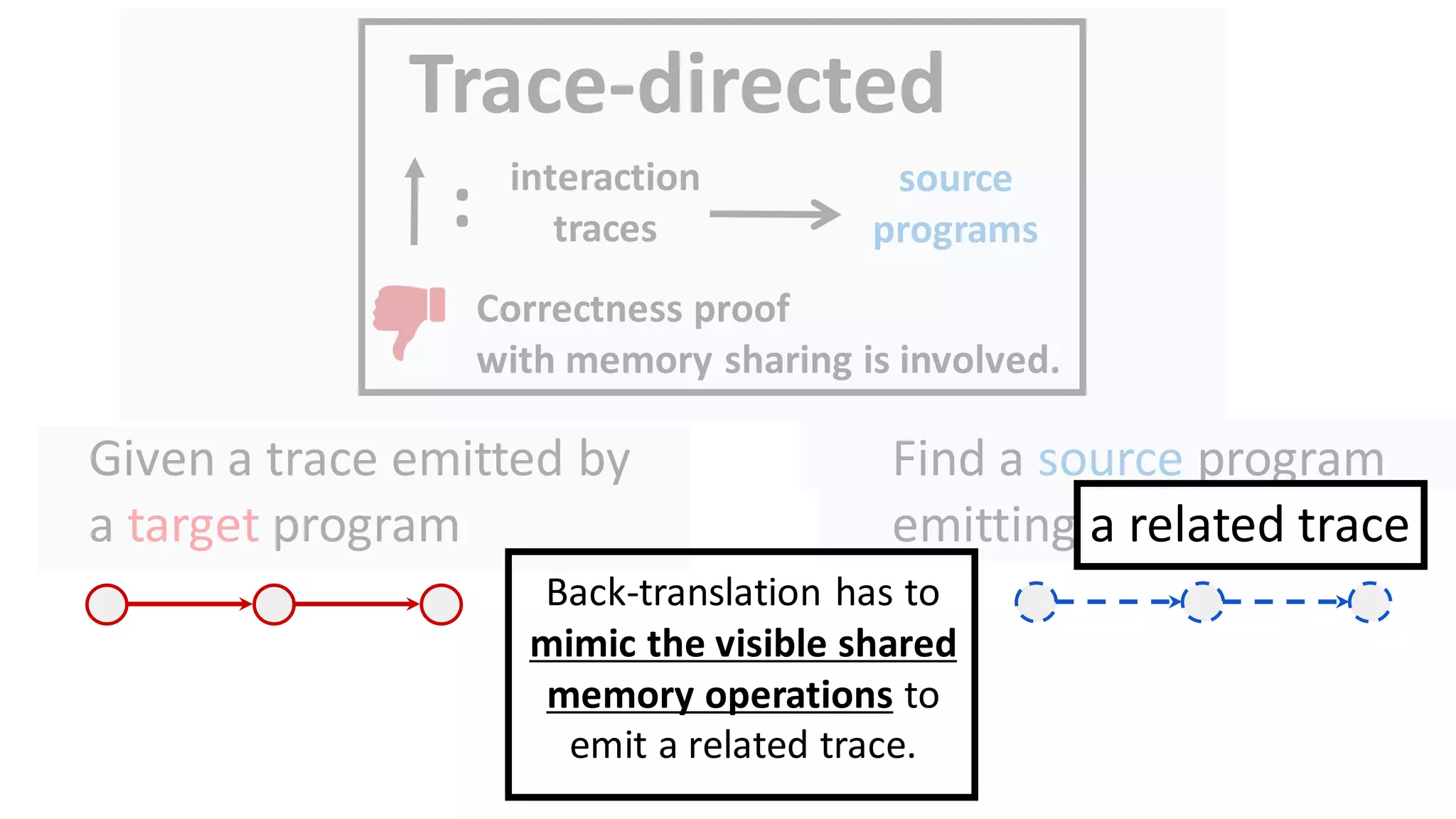
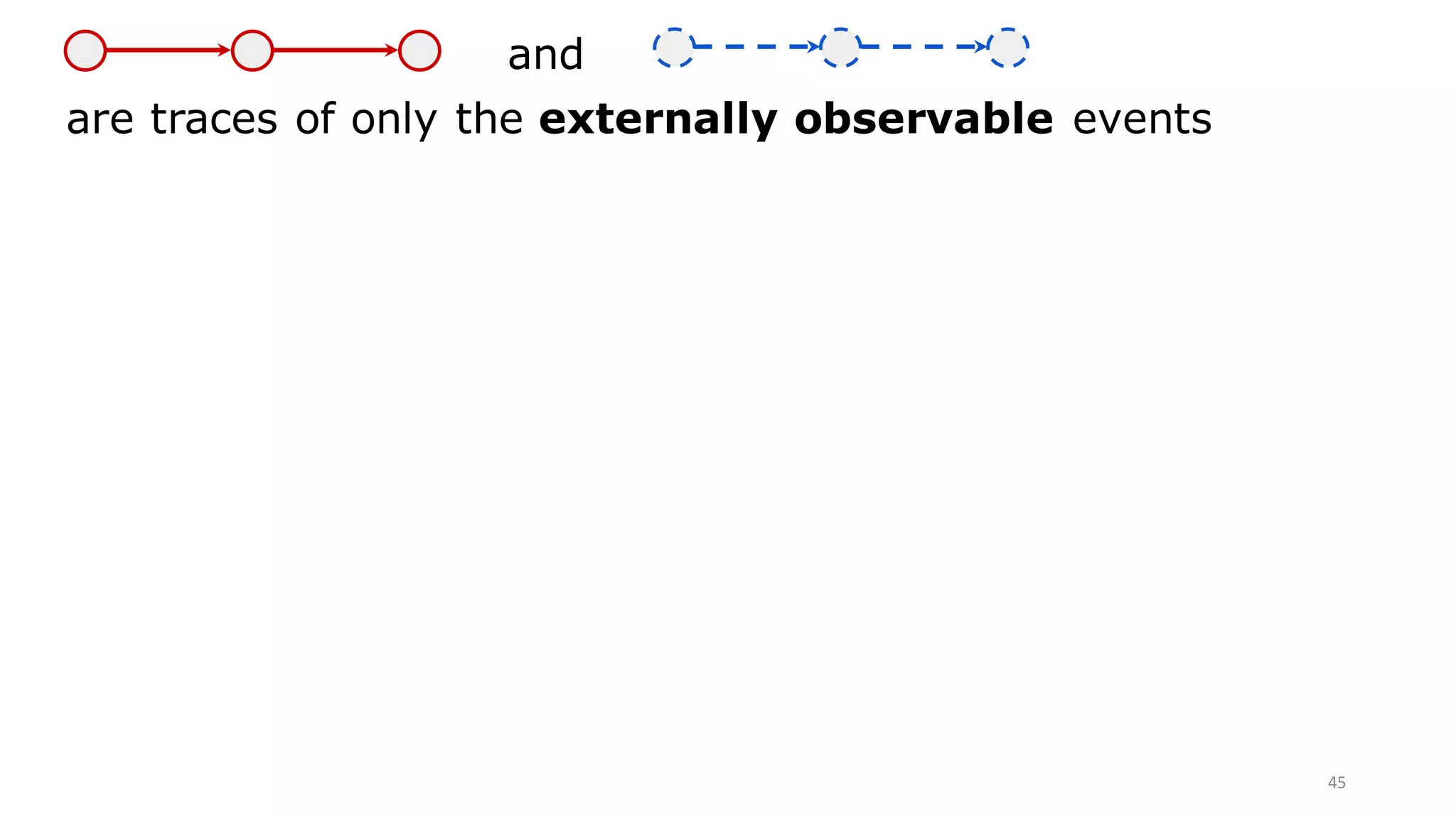
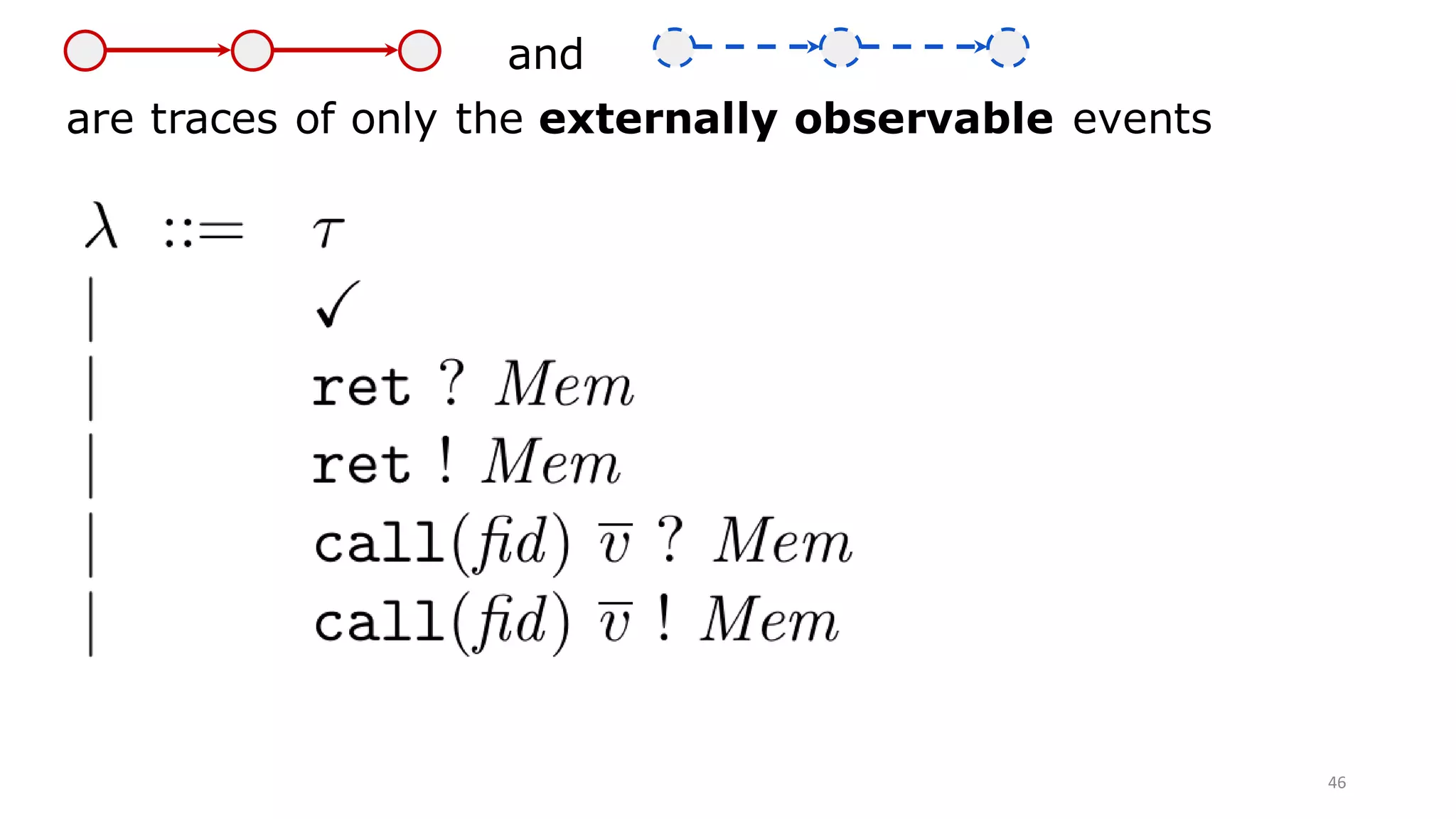
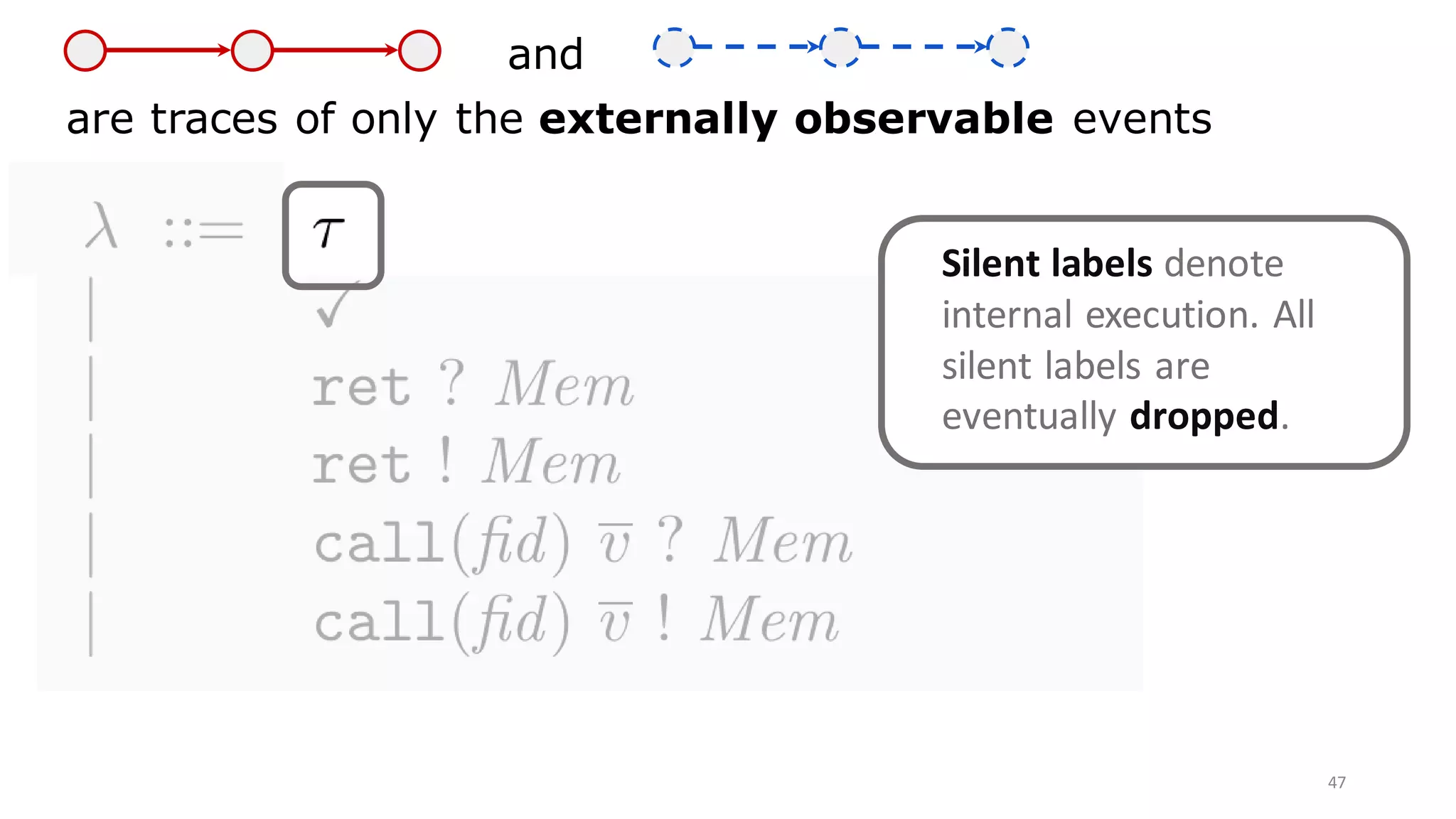
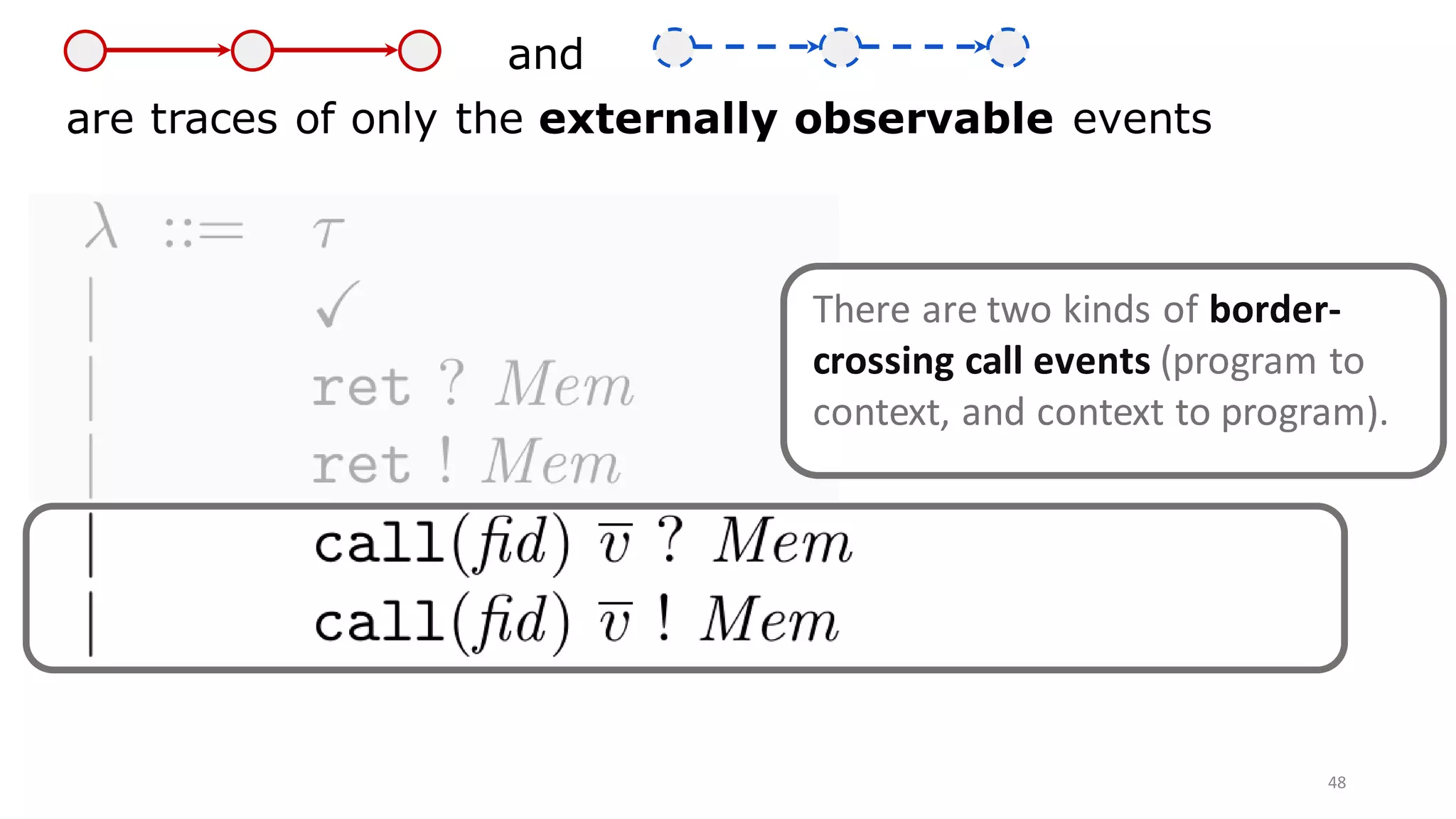
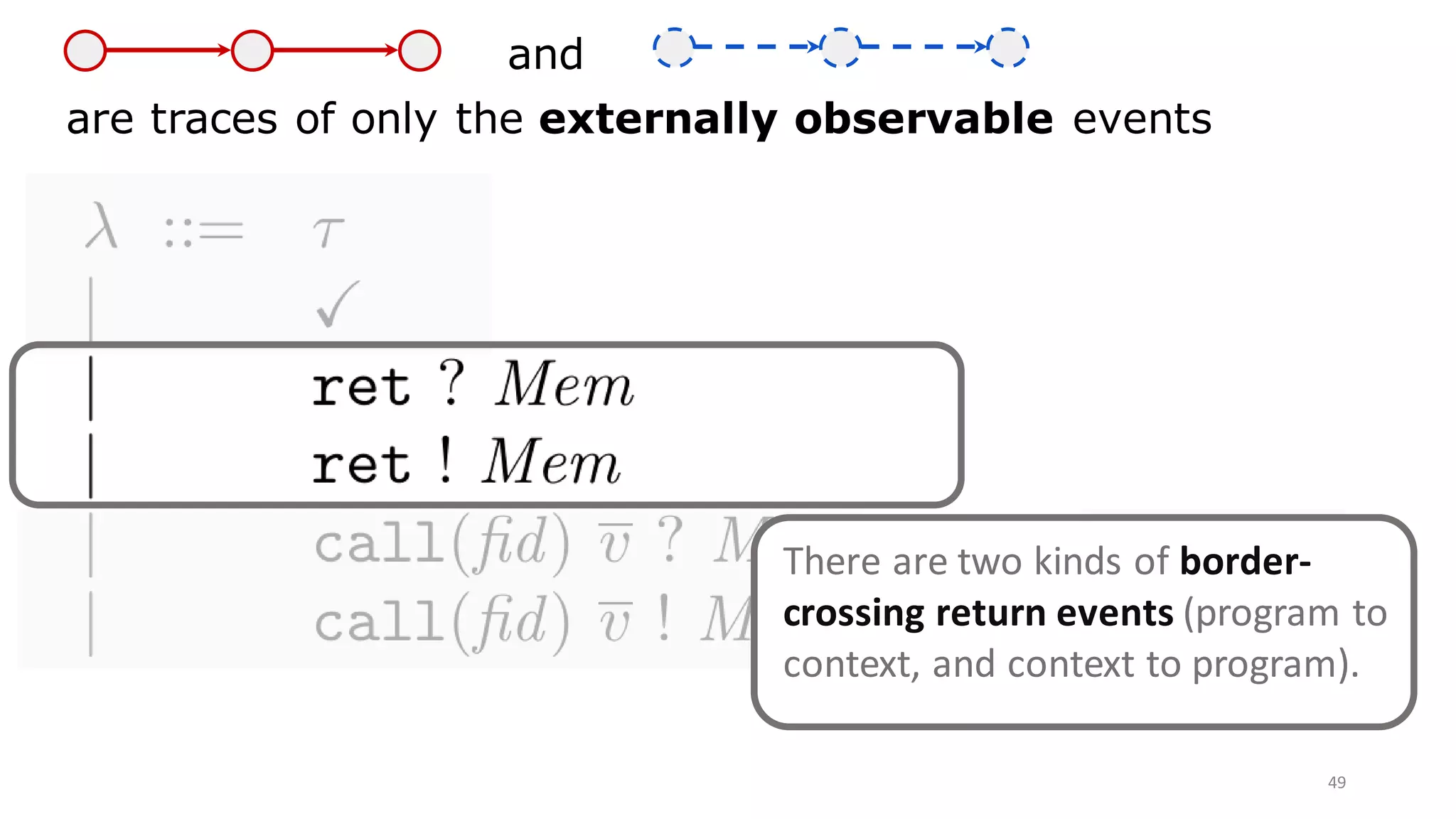
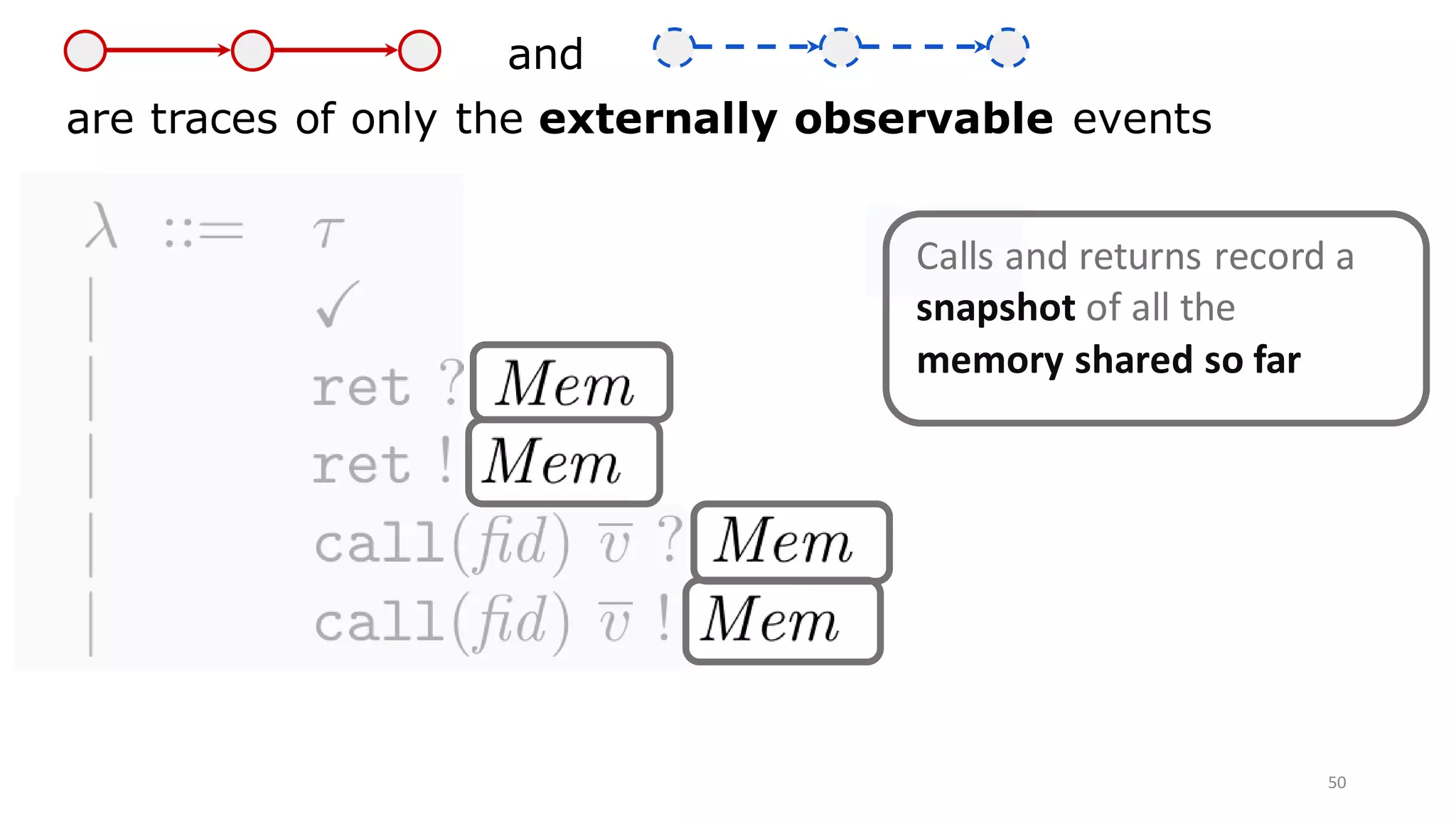
![include module Net
module Main {
char iobuffer[1024];
static long int user_balance_usd;
int main(void) {
Net.init_network(iobuffer)
Net.receive();
}
}
51
Walk through the
example and explain
memory shared so far
and the reason why
Proof of trace-directed back-
translation with memory sharing
is involved.](https://image.slidesharecdn.com/prisc-2022-220122131600/75/SecurePtrs-Proving-Secure-Compilation-with-Data-Flow-Back-Translation-and-Turn-Taking-Simulation-51-2048.jpg)
![include module Net
module Main {
char iobuffer[1024];
static long int user_balance_usd;
int main(void) {
Net.init_network(iobuffer)
Net.receive();
}
}
52
border crossing
border crossing](https://image.slidesharecdn.com/prisc-2022-220122131600/75/SecurePtrs-Proving-Secure-Compilation-with-Data-Flow-Back-Translation-and-Turn-Taking-Simulation-52-2048.jpg)
![include module Net
module Main {
char iobuffer[1024];
static long int user_balance_usd;
int main(void) {
Net.init_network(iobuffer)
Net.receive();
}
}
53
iobuffer[1024]](https://image.slidesharecdn.com/prisc-2022-220122131600/75/SecurePtrs-Proving-Secure-Compilation-with-Data-Flow-Back-Translation-and-Turn-Taking-Simulation-53-2048.jpg)
![include module Net
module Main {
char iobuffer[1024];
static long int user_balance_usd;
int main(void) {
Net.init_network(iobuffer)
Net.receive();
}
}
54
iobuffer[1024]
The call
to init_network shares
the iobuffer; a snapshot
of its contents appears now
and in all future border-
crossing events.](https://image.slidesharecdn.com/prisc-2022-220122131600/75/SecurePtrs-Proving-Secure-Compilation-with-Data-Flow-Back-Translation-and-Turn-Taking-Simulation-54-2048.jpg)
![include module Net
module Main {
char iobuffer[1024];
static long int user_balance_usd;
int main(void) {
Net.init_network(iobuffer)
Net.receive();
}
}
55
iobuffer[1024]
The return
from init_network still
shows the iobuffer with
the same contents.](https://image.slidesharecdn.com/prisc-2022-220122131600/75/SecurePtrs-Proving-Secure-Compilation-with-Data-Flow-Back-Translation-and-Turn-Taking-Simulation-55-2048.jpg)
![include module Net
module Main {
char iobuffer[1024];
static long int user_balance_usd;
int main(void) {
Net.init_network(iobuffer)
Net.receive();
}
}
56
iobuffer[1024]
The call to receive does
not (directly) share anything
new, but still](https://image.slidesharecdn.com/prisc-2022-220122131600/75/SecurePtrs-Proving-Secure-Compilation-with-Data-Flow-Back-Translation-and-Turn-Taking-Simulation-56-2048.jpg)
![include module Net
module Main {
char iobuffer[1024];
static long int user_balance_usd;
int main(void) {
Net.init_network(iobuffer)
Net.receive();
}
}
57
iobuffer[1024]
The return
event from receive also
shows a snapshot
of iobuffer, now with
the received data!](https://image.slidesharecdn.com/prisc-2022-220122131600/75/SecurePtrs-Proving-Secure-Compilation-with-Data-Flow-Back-Translation-and-Turn-Taking-Simulation-57-2048.jpg)
![include module Net
module Main {
char iobuffer[1024];
static long int user_balance_usd;
int main(void) {
Net.init_network(iobuffer);
Net.receive();
}
}
58
iobuffer[1024]
The init_network function
must have
stashed the pointer
to iobuffer somewhere in order
to enable other functions of
Net to access it.](https://image.slidesharecdn.com/prisc-2022-220122131600/75/SecurePtrs-Proving-Secure-Compilation-with-Data-Flow-Back-Translation-and-Turn-Taking-Simulation-58-2048.jpg)

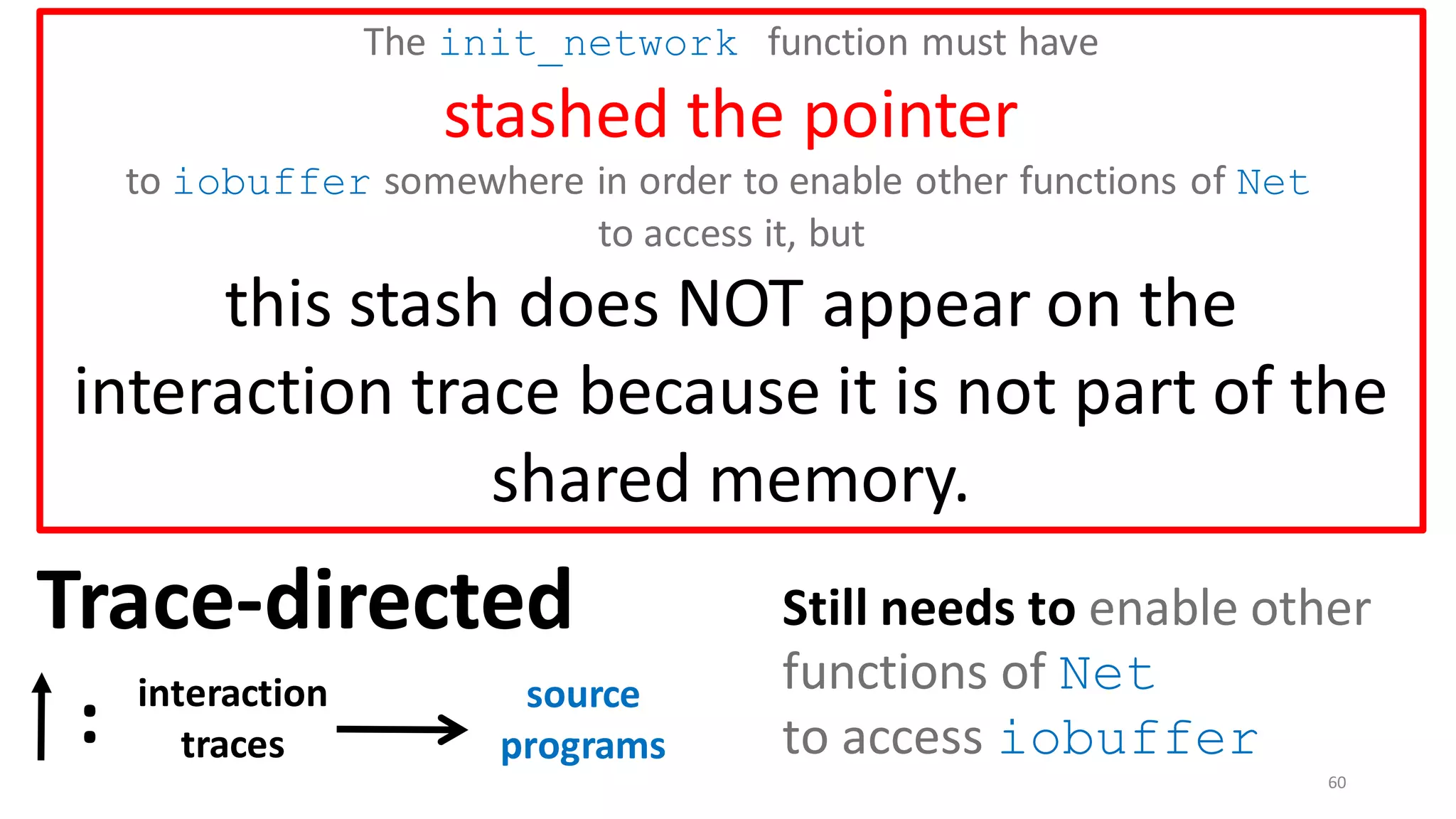
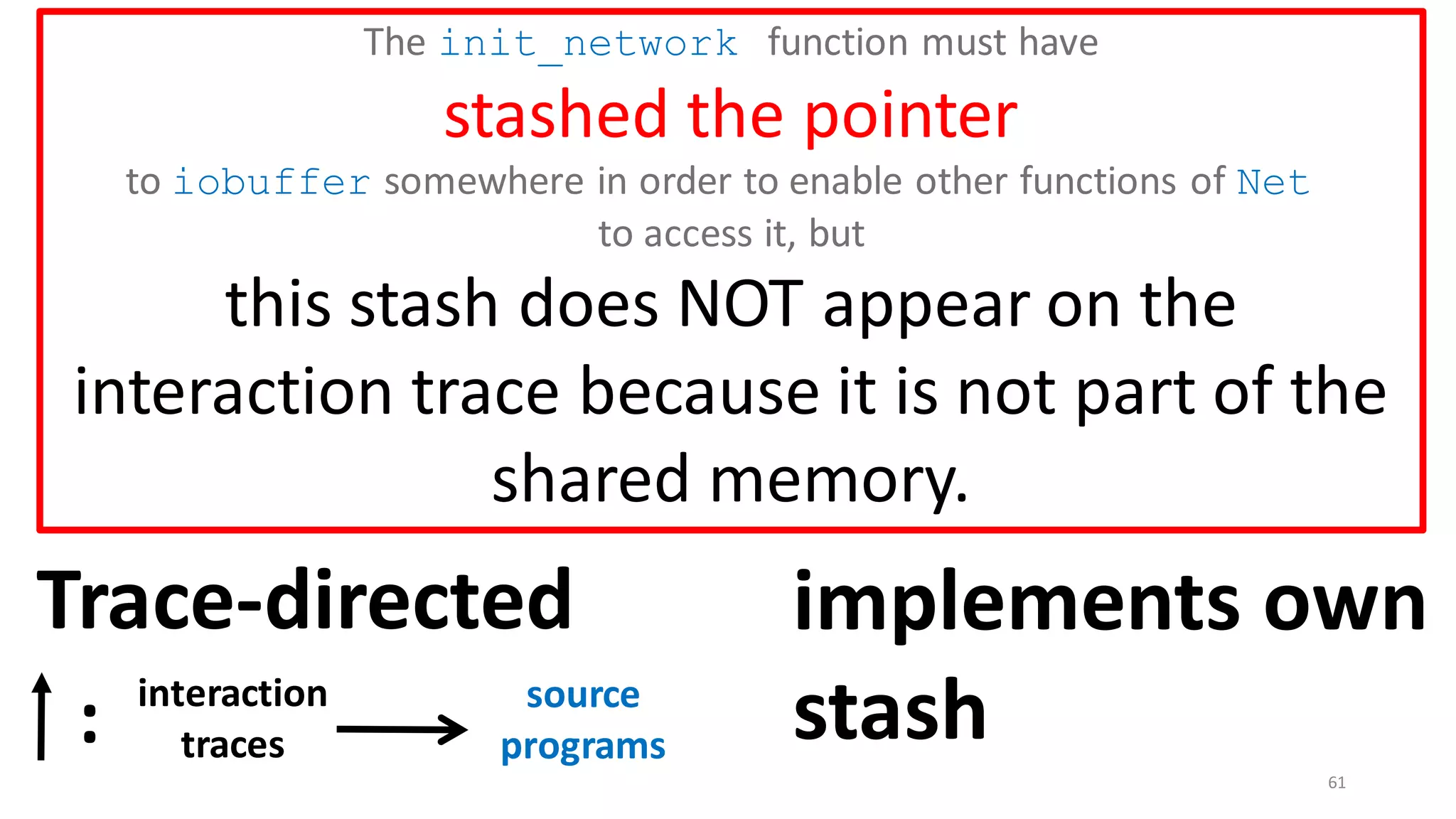
![62
Drawback of trace-directed back-translation:
must traverse and stash the whole shared memory
CapablePtrs [El-Korashy et al. 2021]
Reason: Pointers may
be shared indirectly.](https://image.slidesharecdn.com/prisc-2022-220122131600/75/SecurePtrs-Proving-Secure-Compilation-with-Data-Flow-Back-Translation-and-Turn-Taking-Simulation-62-2048.jpg)
![63
Fatten the whole graph
reachable from the shared
memory and stash it:
init_network_arg_1,
init_network_arg_2,
.. .
init_network_arg_n
and maintain invariants
between the flattening and
the original.
Drawback of trace-directed back-translation:
must traverse and stash the whole shared memory
CapablePtrs [El-Korashy et al. 2021]
Reason: Pointers may
be shared indirectly.](https://image.slidesharecdn.com/prisc-2022-220122131600/75/SecurePtrs-Proving-Secure-Compilation-with-Data-Flow-Back-Translation-and-Turn-Taking-Simulation-63-2048.jpg)
![The stashing mechanism of CapablePtrs [El-Korashy et al.
2021] is not mechanized-proof friendly.
Proving that this stashing mechanism is
sufficient to mimic every possible
memory snapshot is not trivial in Coq.](https://image.slidesharecdn.com/prisc-2022-220122131600/75/SecurePtrs-Proving-Secure-Compilation-with-Data-Flow-Back-Translation-and-Turn-Taking-Simulation-64-2048.jpg)
![Proving that this stashing mechanism is
sufficient to mimic every possible
memory snapshot is not trivial in Coq.
e.g., Termination lemmas for custom graph traversal algorithms have to be
proved.
The stashing mechanism of CapablePtrs [El-Korashy et al.
2021] is not mechanized-proof friendly.](https://image.slidesharecdn.com/prisc-2022-220122131600/75/SecurePtrs-Proving-Secure-Compilation-with-Data-Flow-Back-Translation-and-Turn-Taking-Simulation-65-2048.jpg)
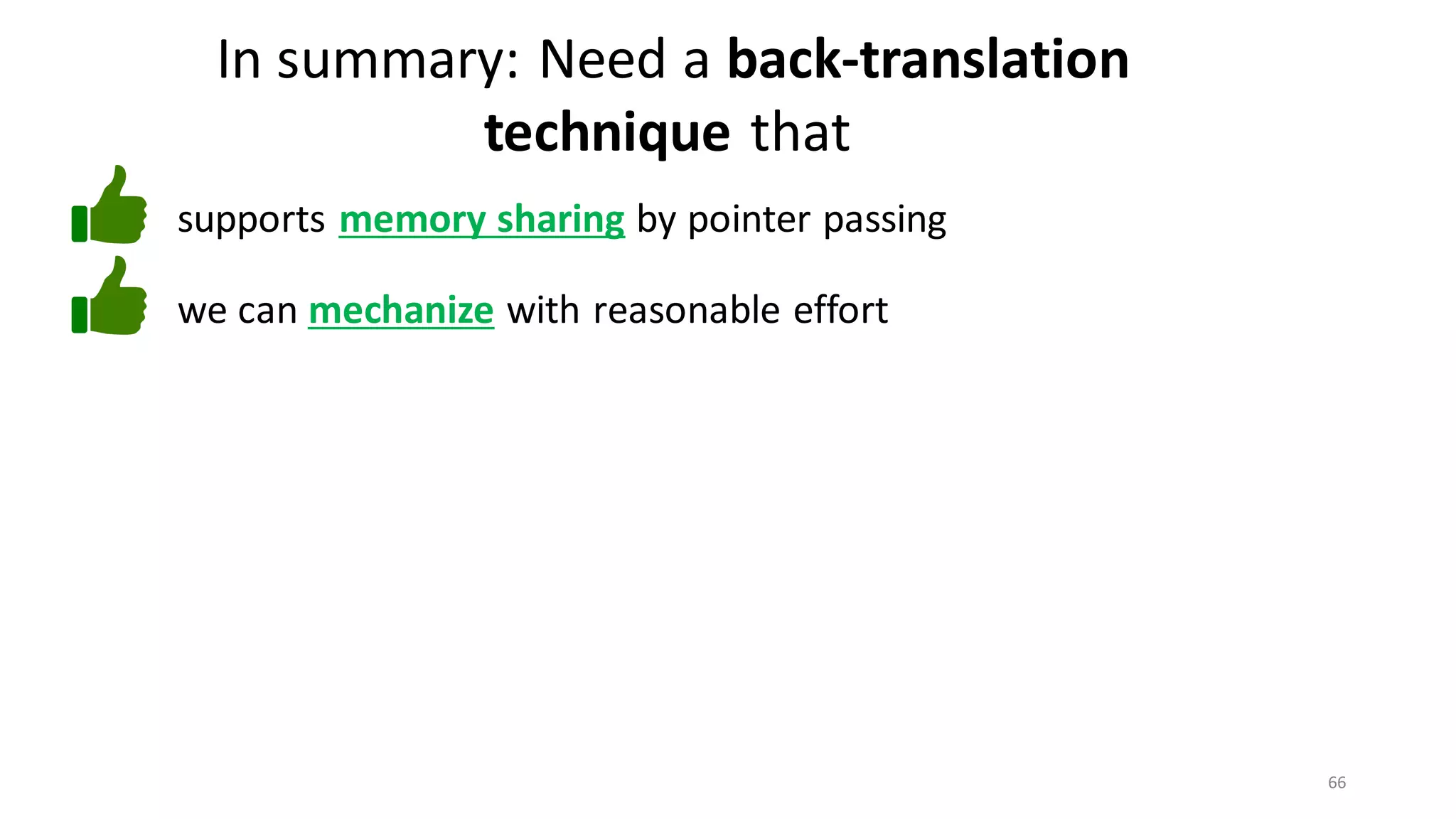
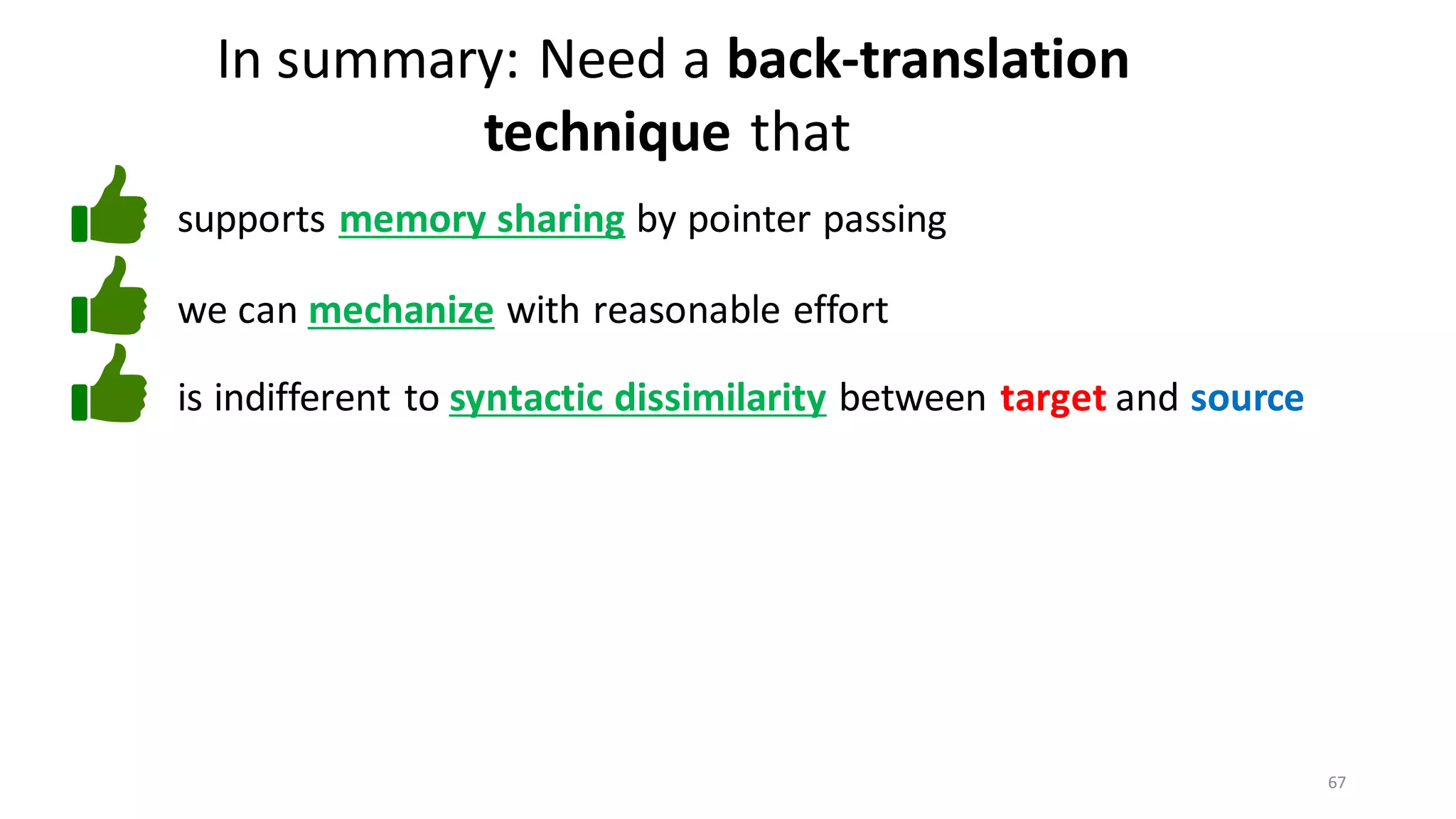
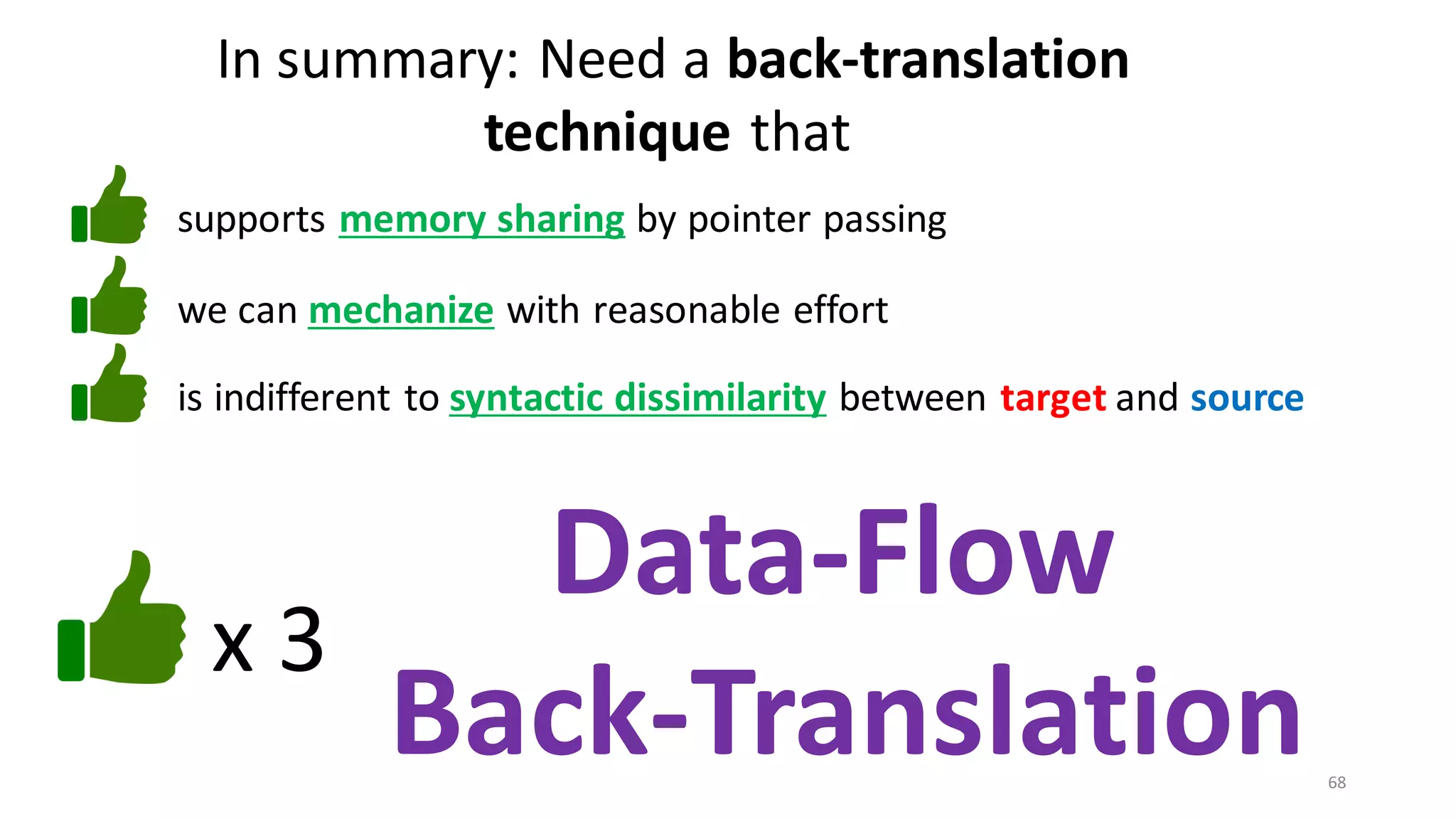
![69
Data-Flow Back-Translation
[Under submission]
High level idea: Make the traces more informative
so that trace-directed back-translation is easier.](https://image.slidesharecdn.com/prisc-2022-220122131600/75/SecurePtrs-Proving-Secure-Compilation-with-Data-Flow-Back-Translation-and-Turn-Taking-Simulation-69-2048.jpg)
![70
Data-Flow Back-Translation
[Under submission]
Need to be careful: The validity of the top-leveltheorem
depends on the interaction traces capturing just the externally
observable behavior of a module.
High level idea: Make the traces more informative
so that trace-directed back-translation is easier.](https://image.slidesharecdn.com/prisc-2022-220122131600/75/SecurePtrs-Proving-Secure-Compilation-with-Data-Flow-Back-Translation-and-Turn-Taking-Simulation-70-2048.jpg)
![71
Data-Flow Back-Translation
[Under submission]
(Turns out: easy to decouple the trace alphabet of the main theorem from the trace alphabet of the
back-translation. See the enrichmentlemma and the projectionfunction in the manuscript.)
Need to be careful: The validity of the top-leveltheorem
depends on the interaction traces capturing just the externally
observable behavior of a module.
High level idea: Make the traces more informative
so that trace-directed back-translation is easier.](https://image.slidesharecdn.com/prisc-2022-220122131600/75/SecurePtrs-Proving-Secure-Compilation-with-Data-Flow-Back-Translation-and-Turn-Taking-Simulation-71-2048.jpg)
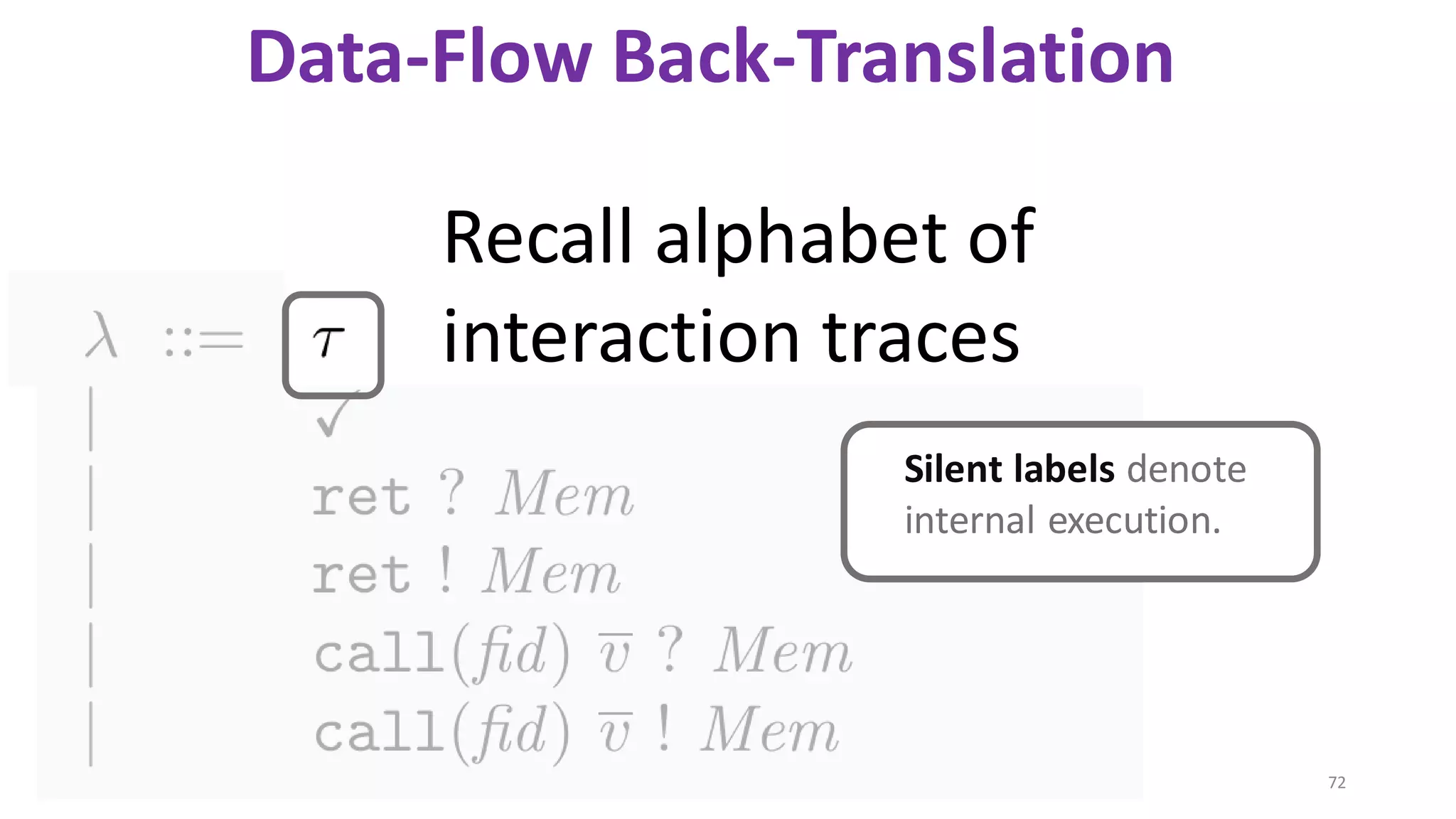

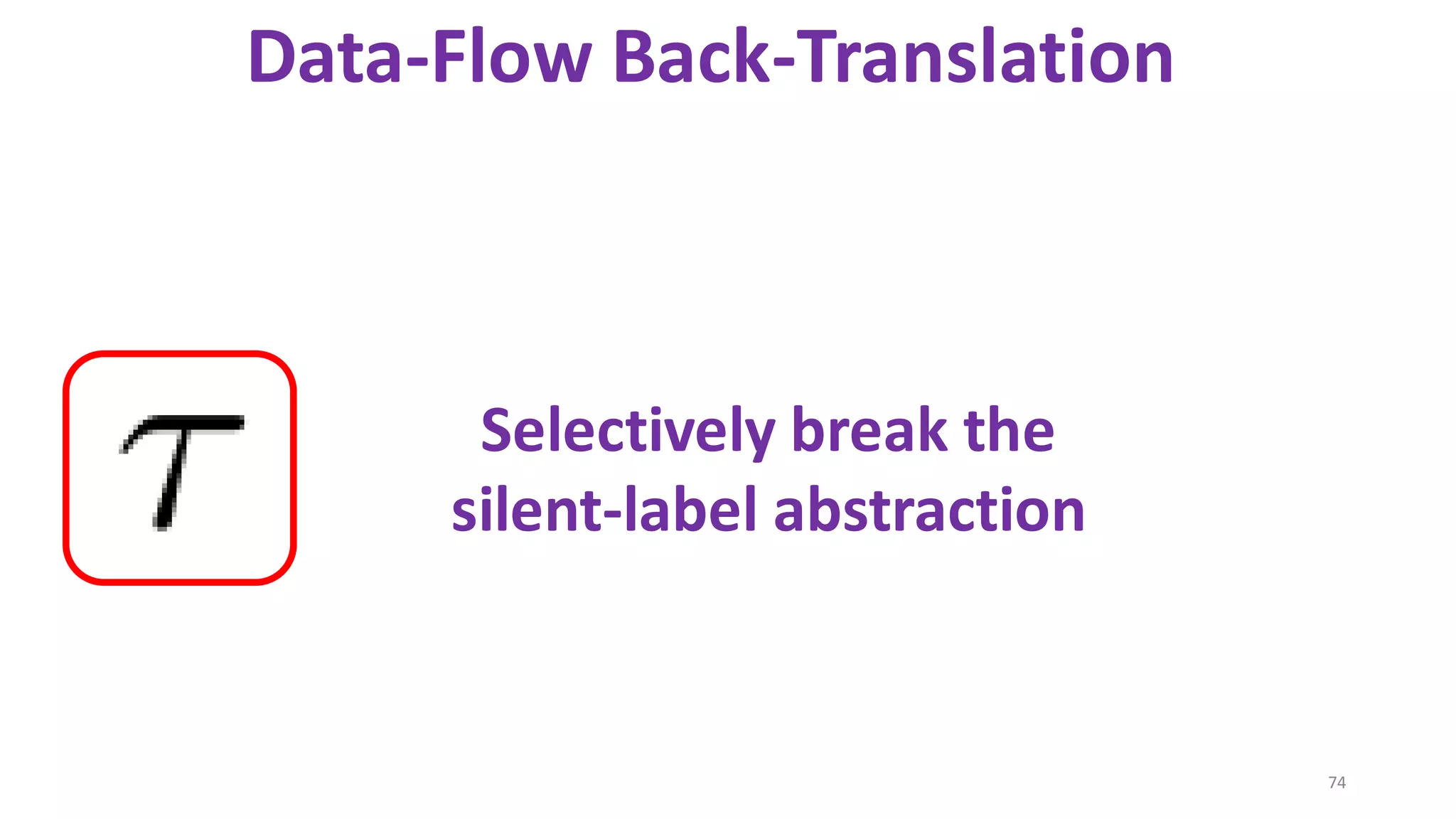
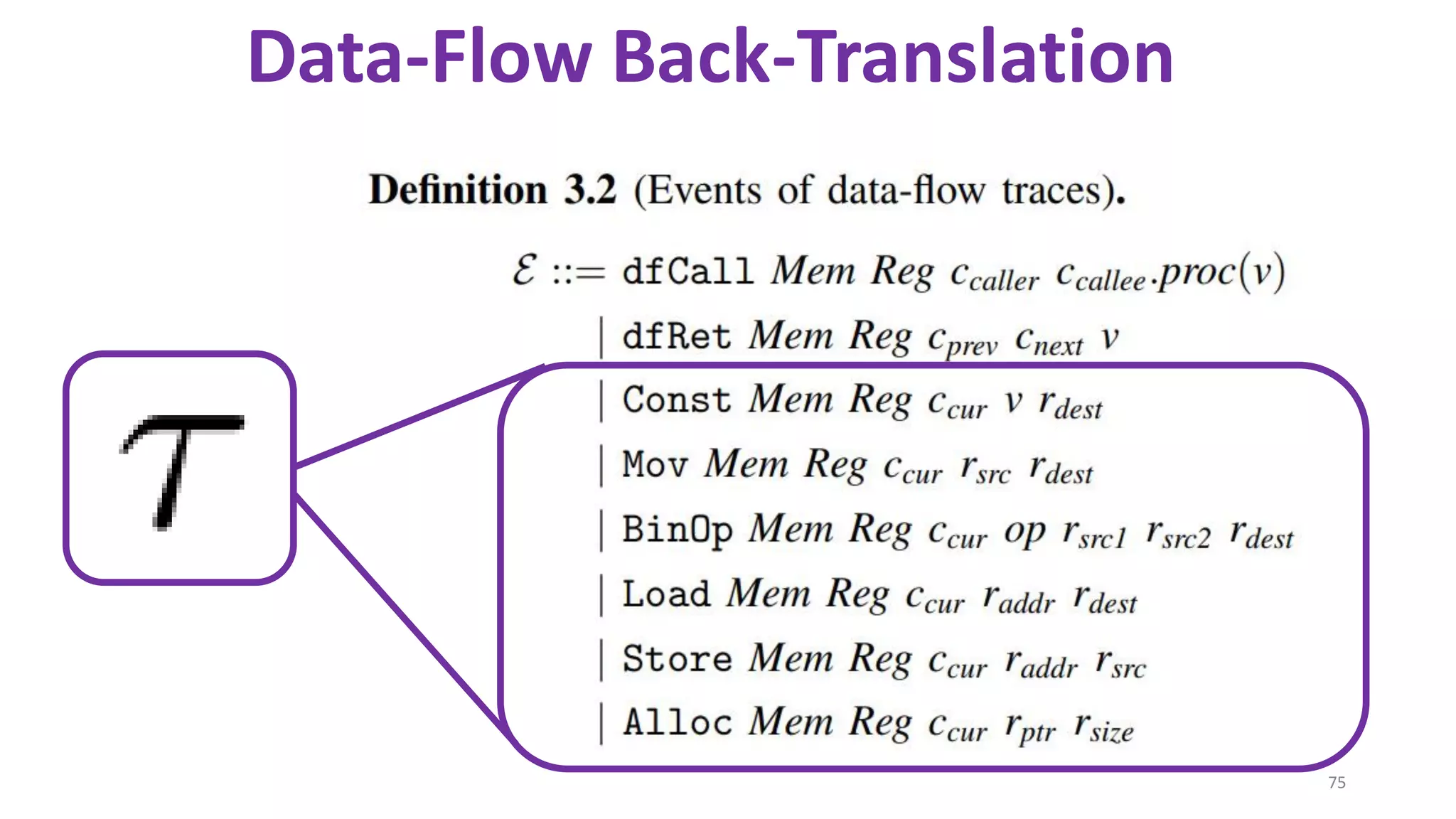
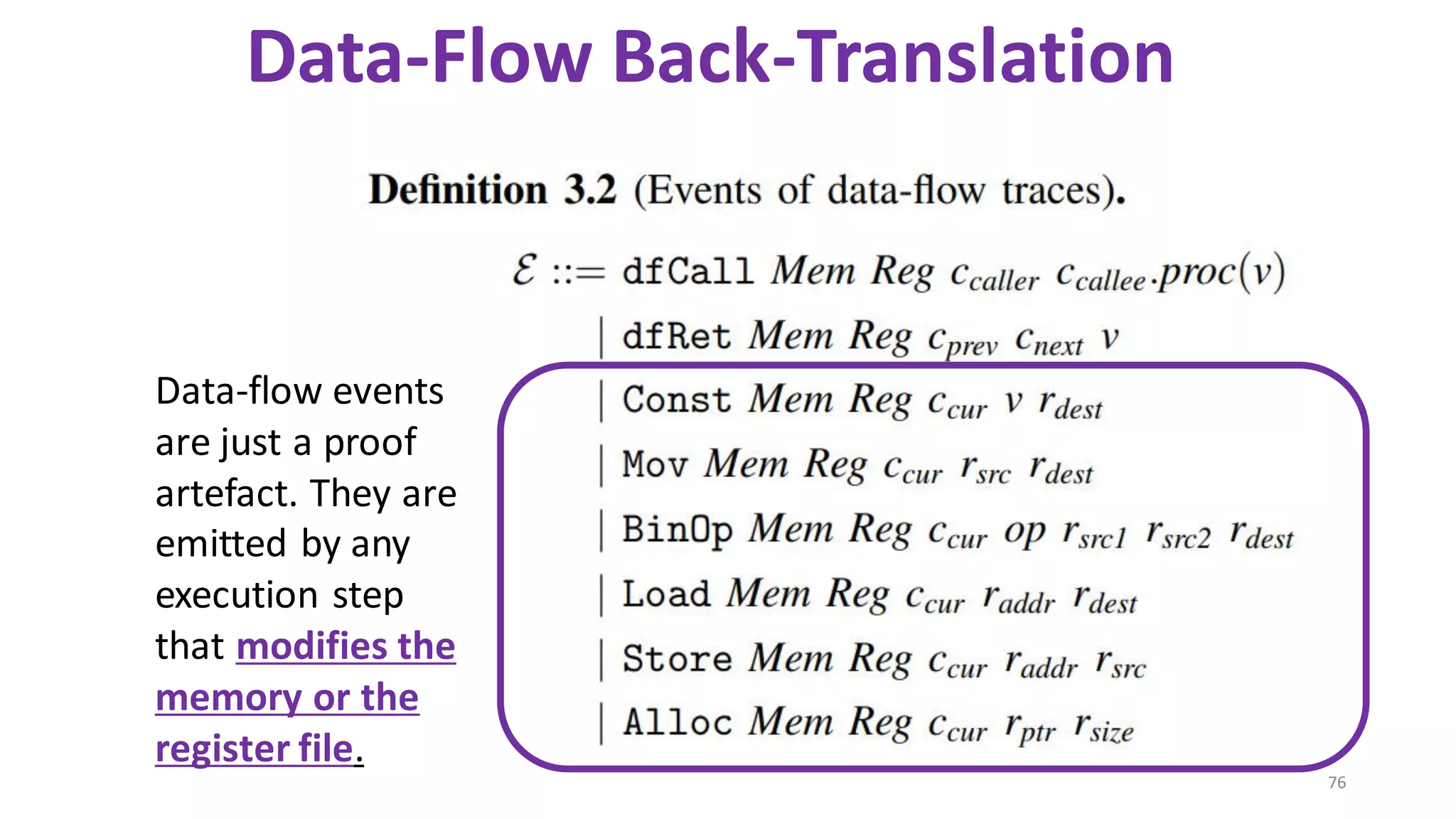
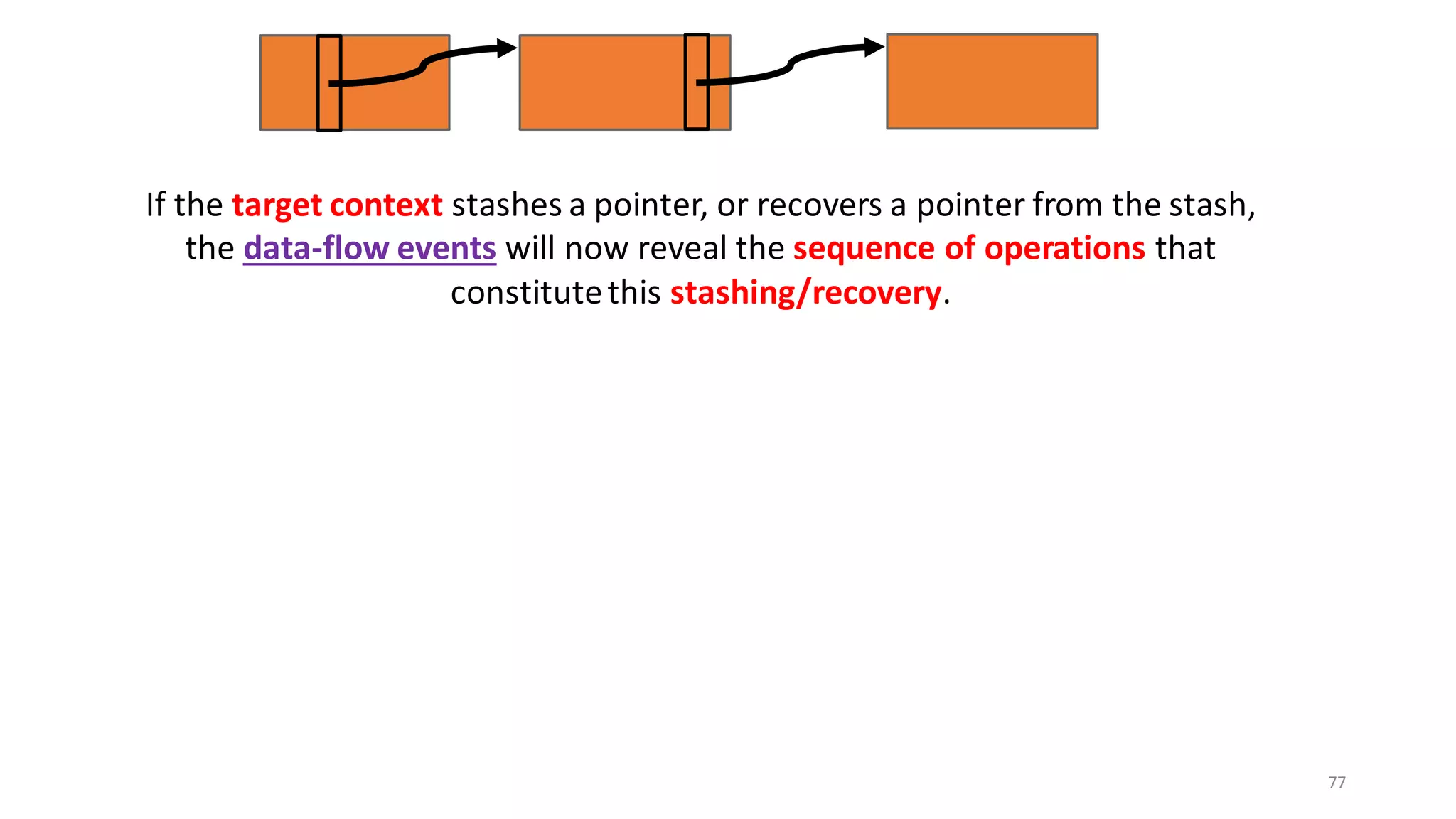
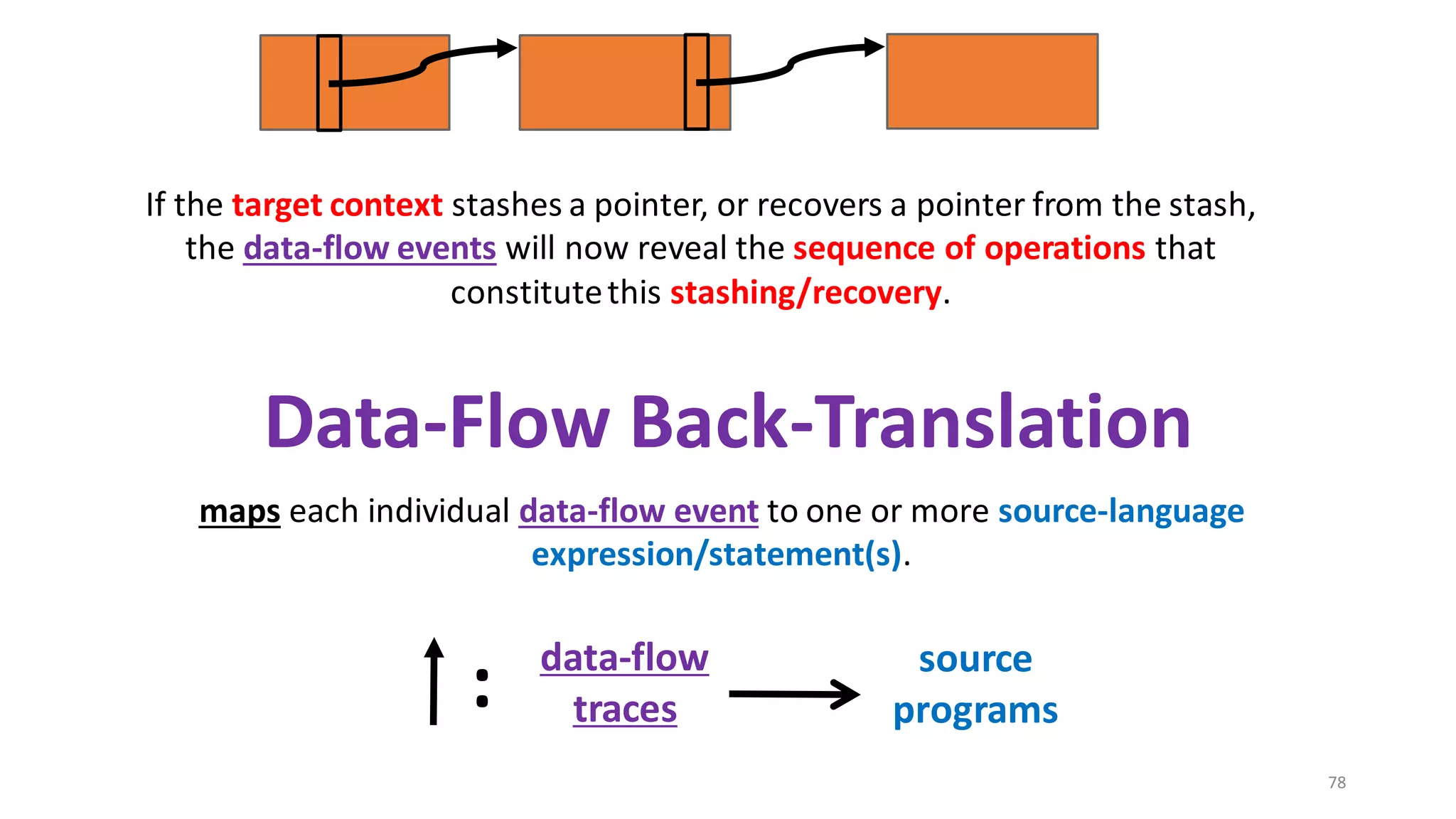
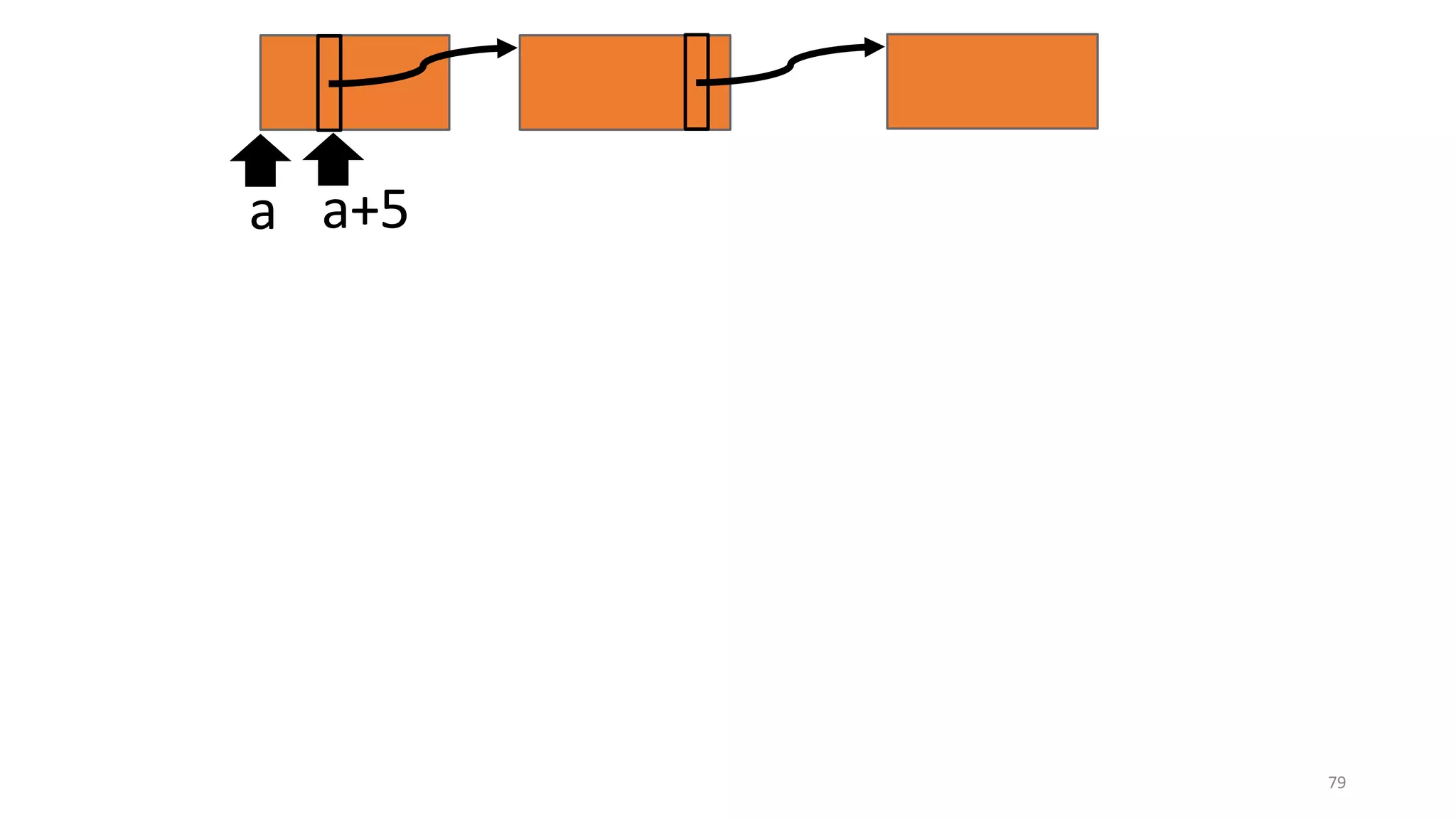
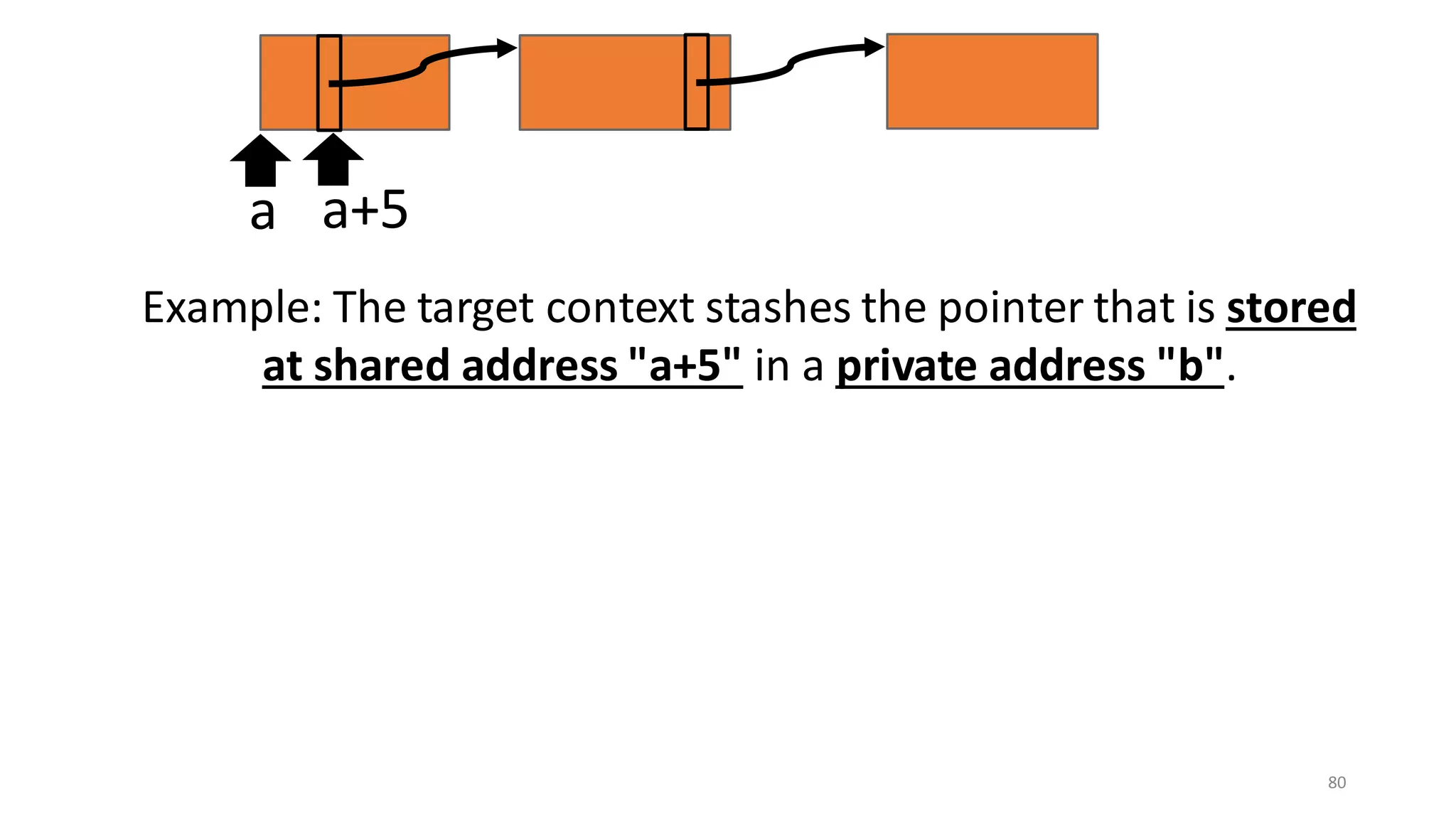
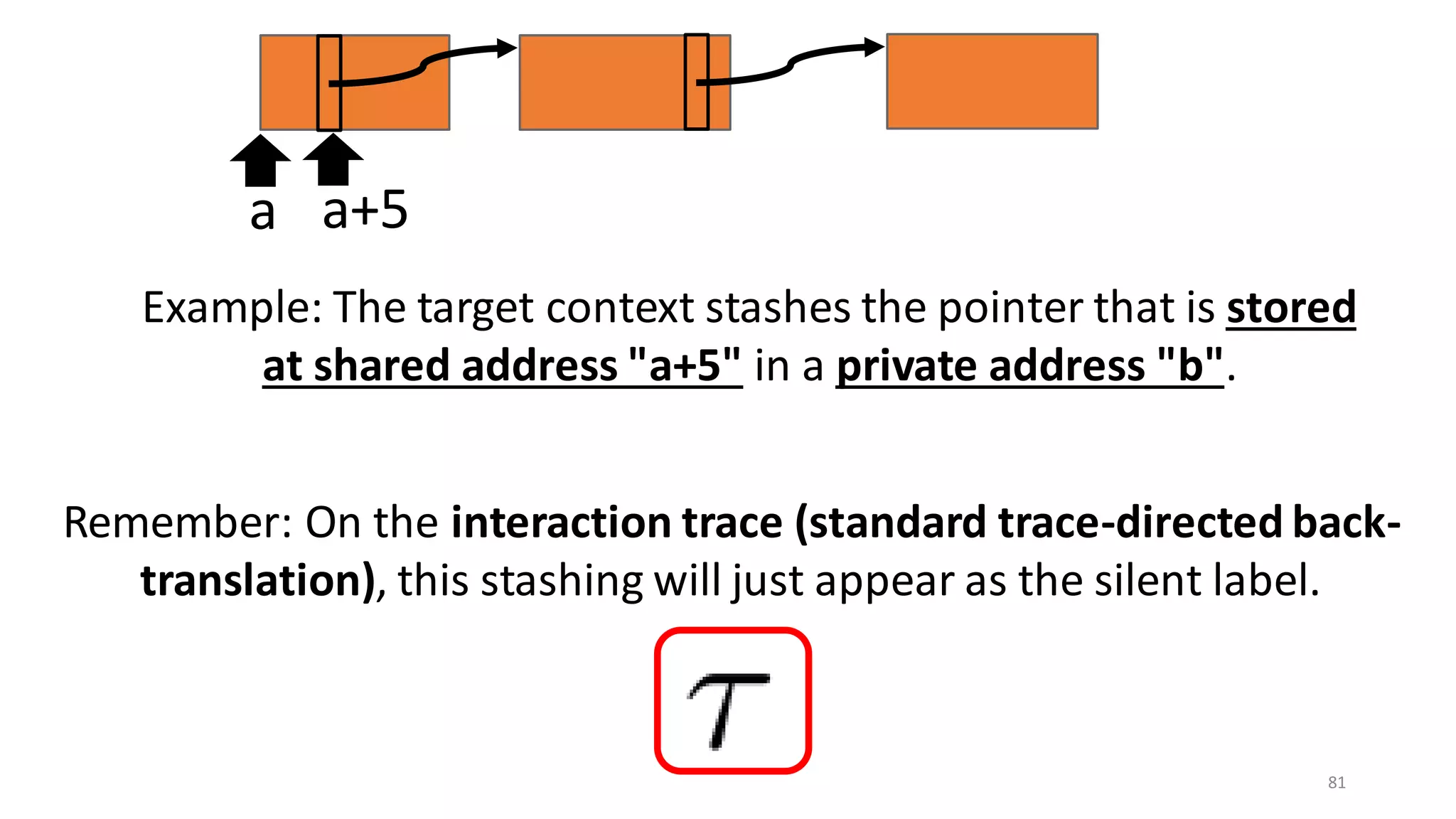
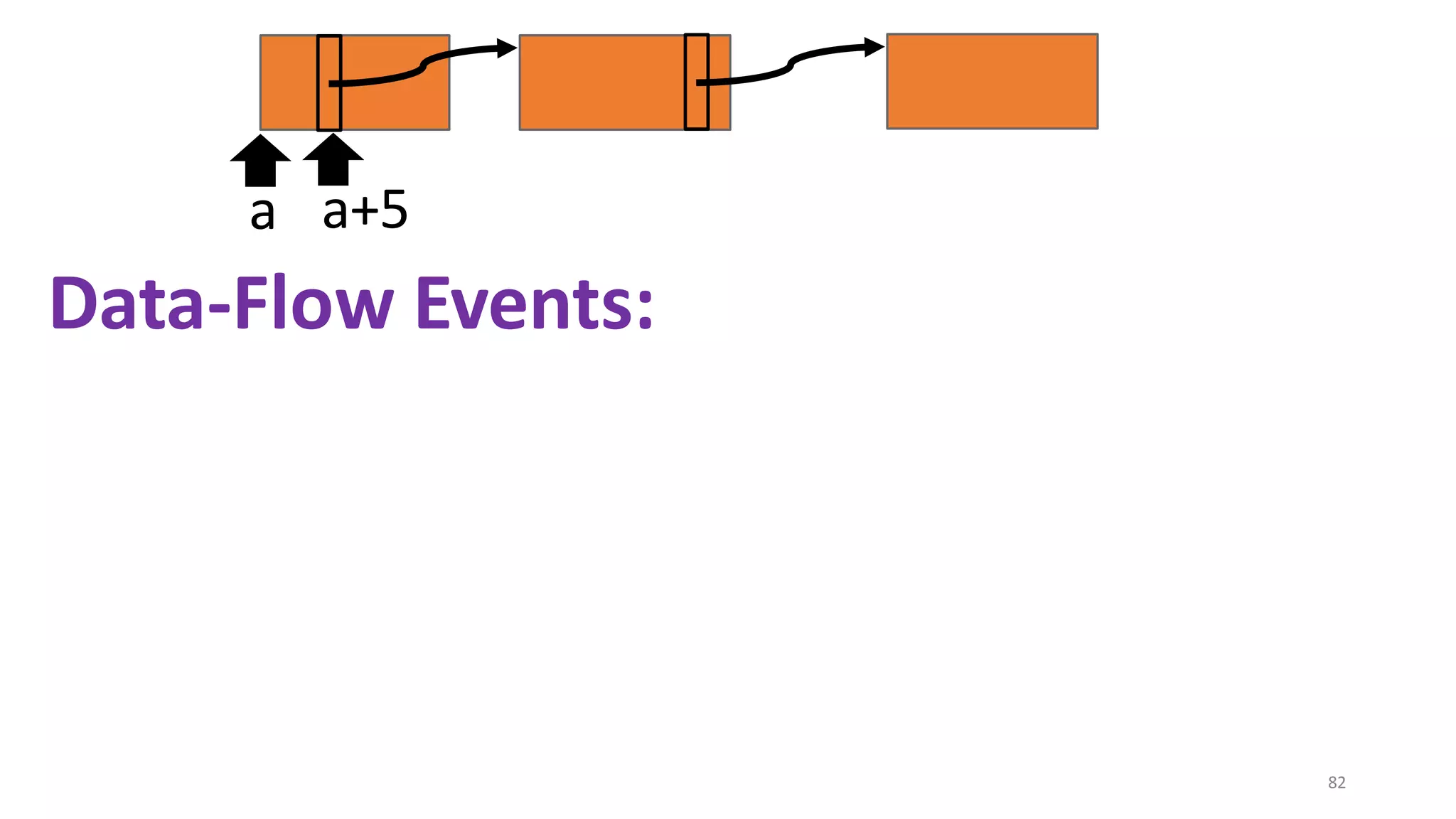
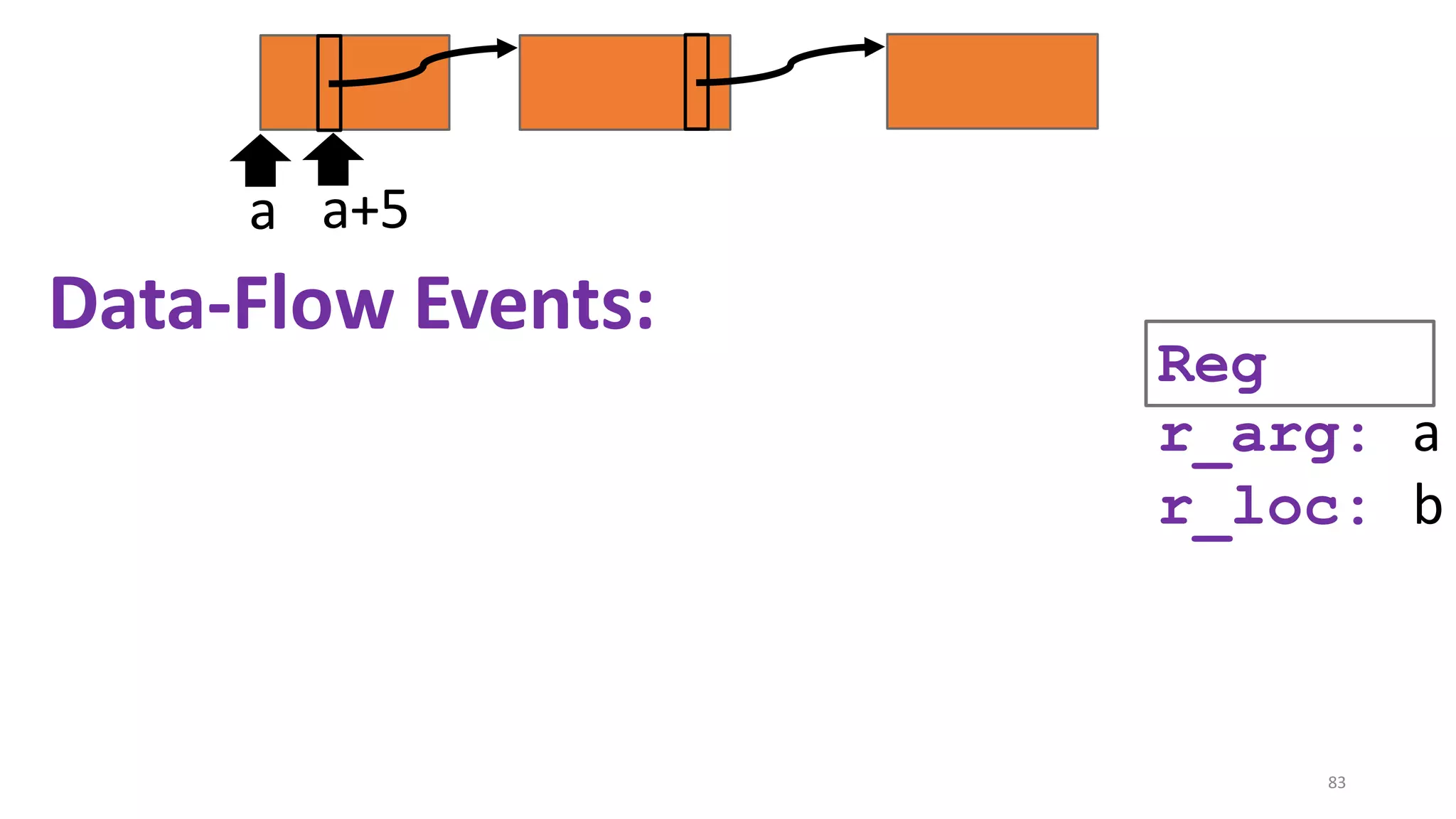
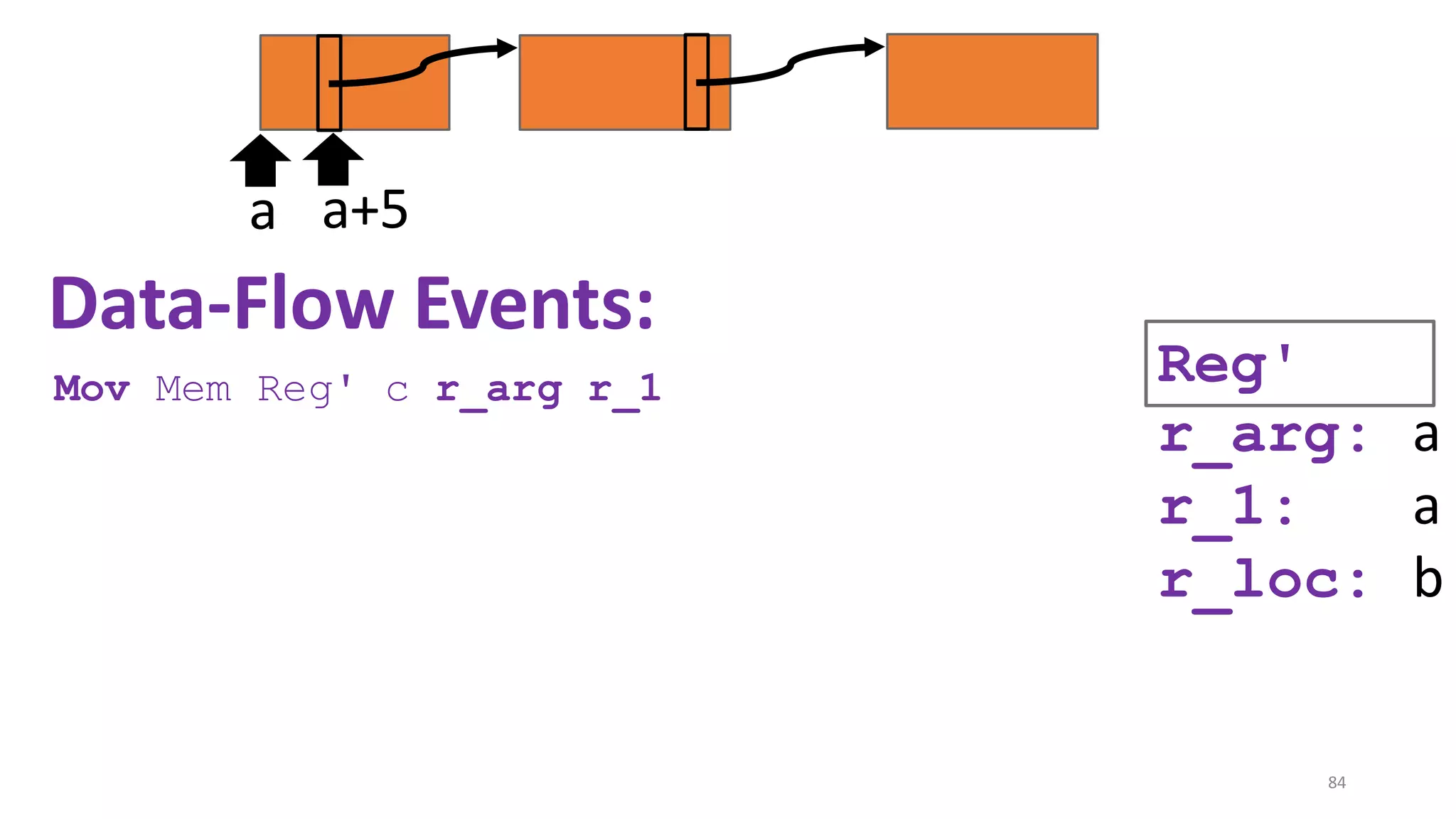
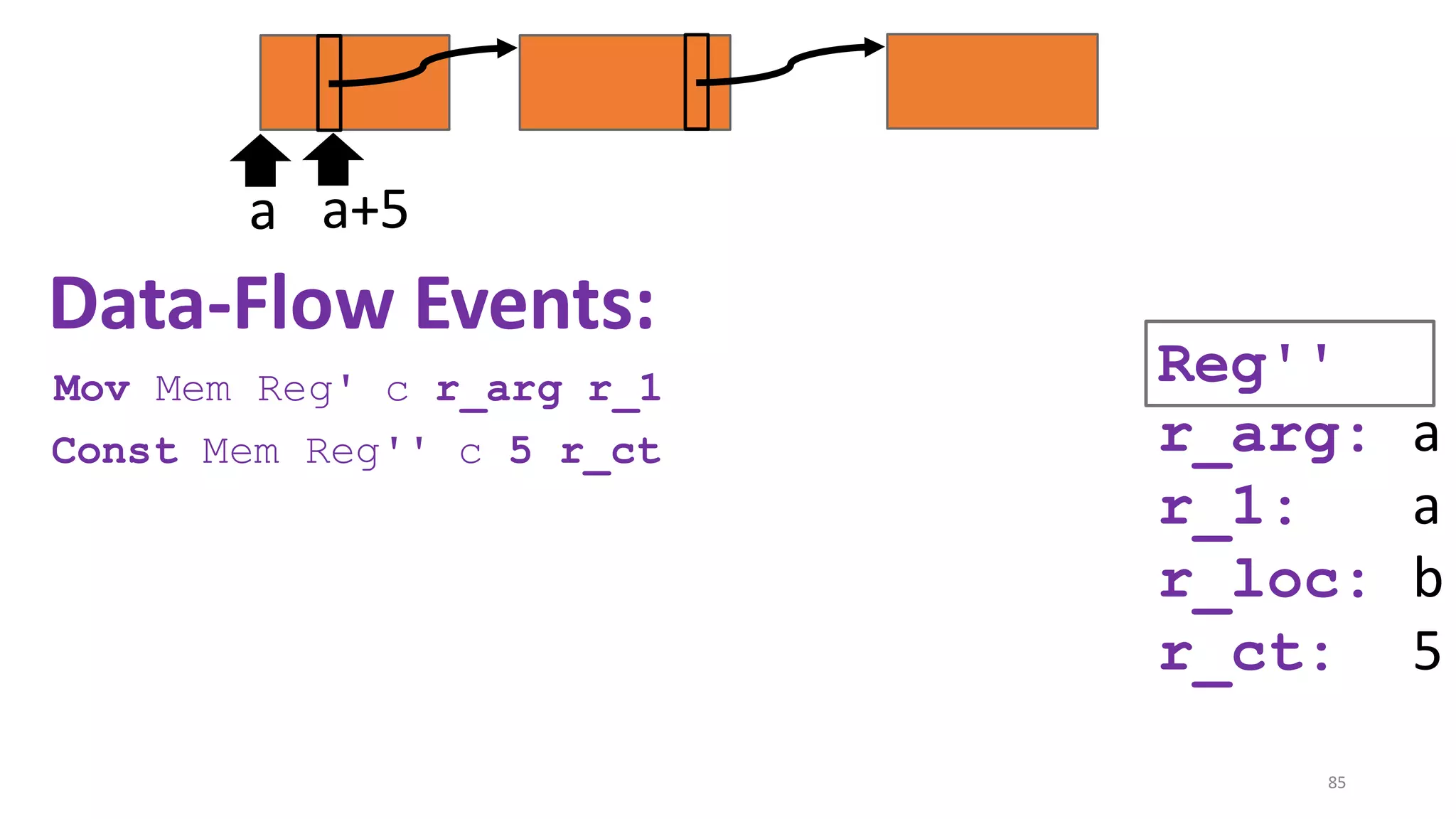
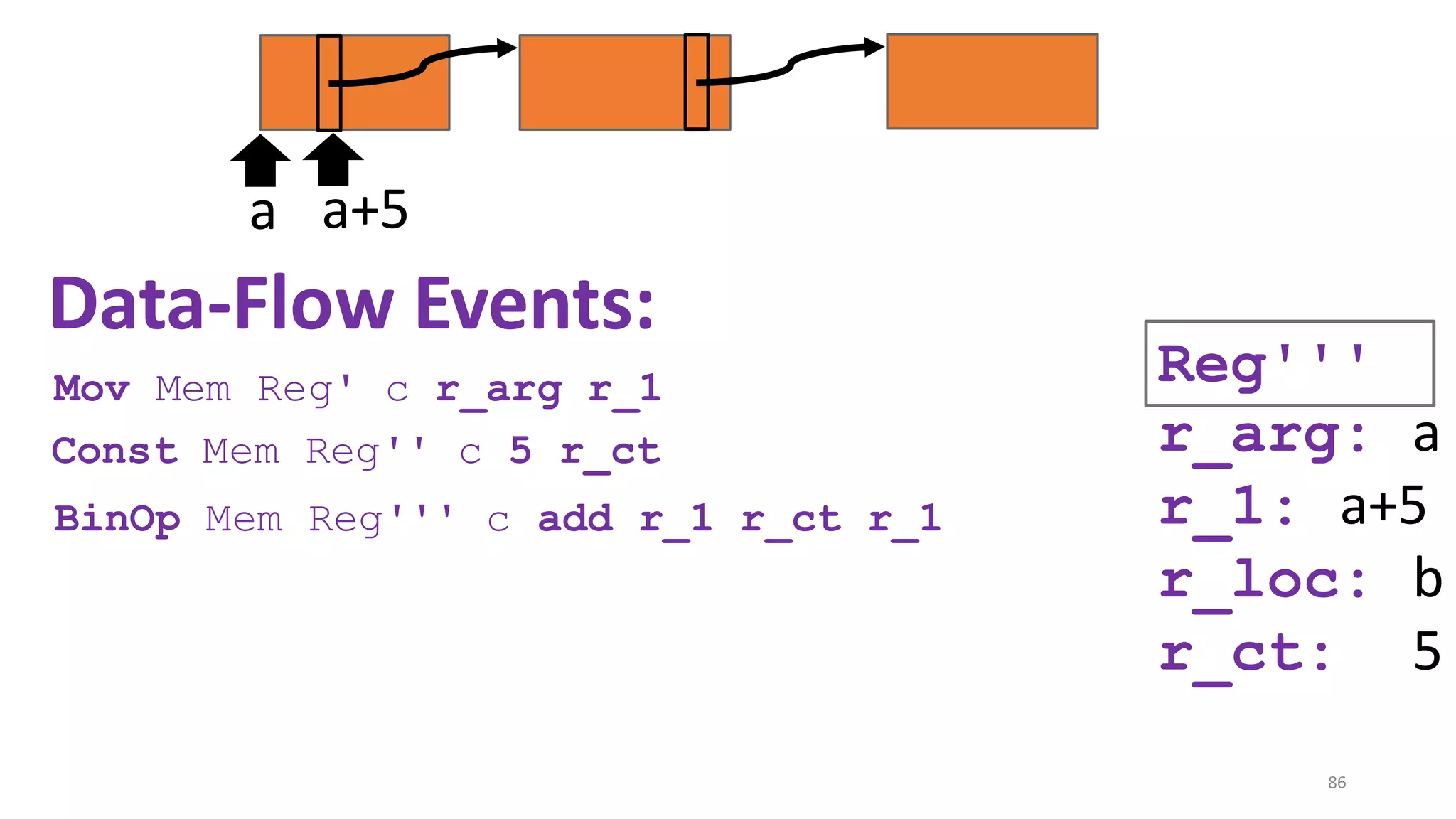
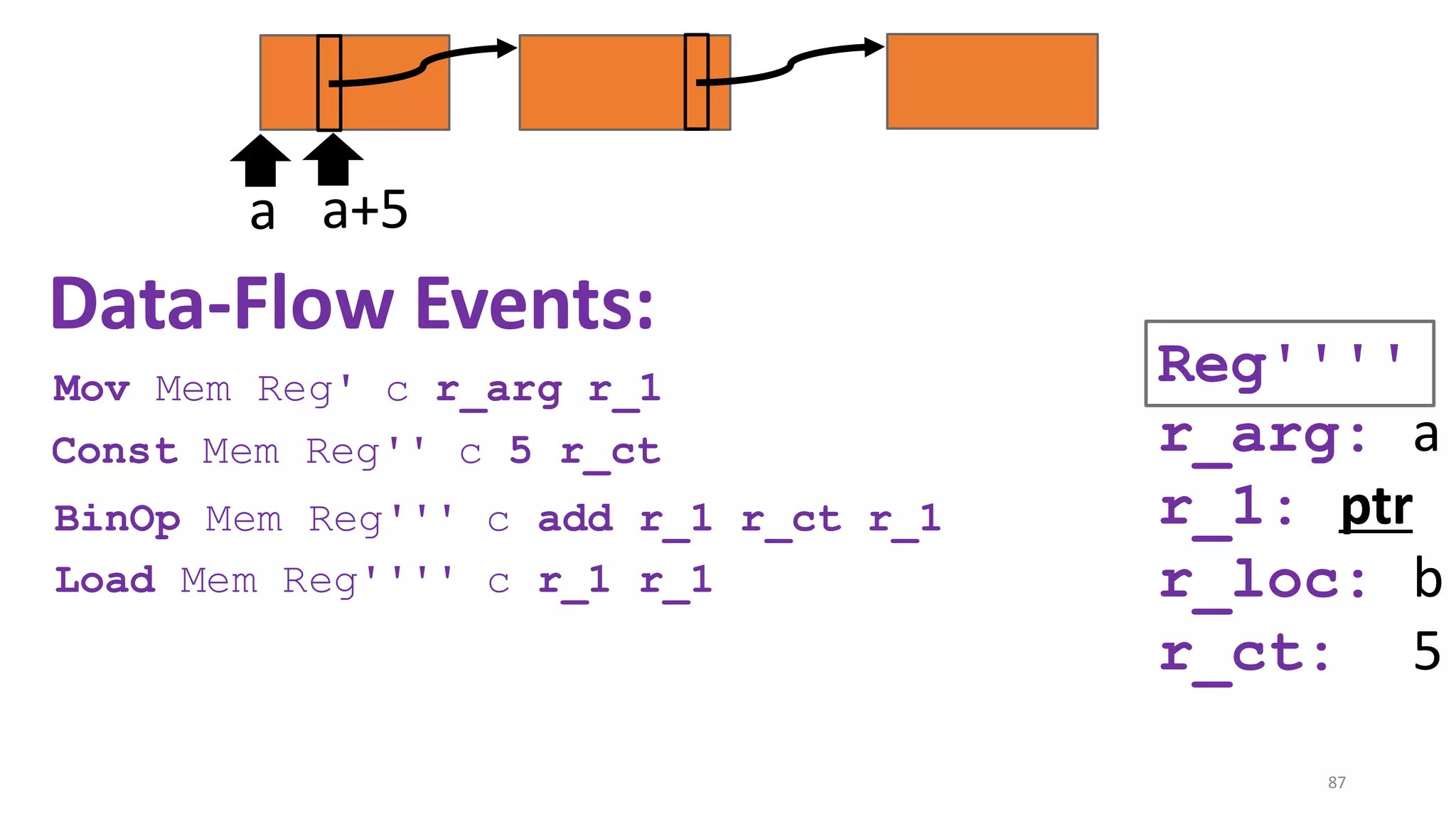
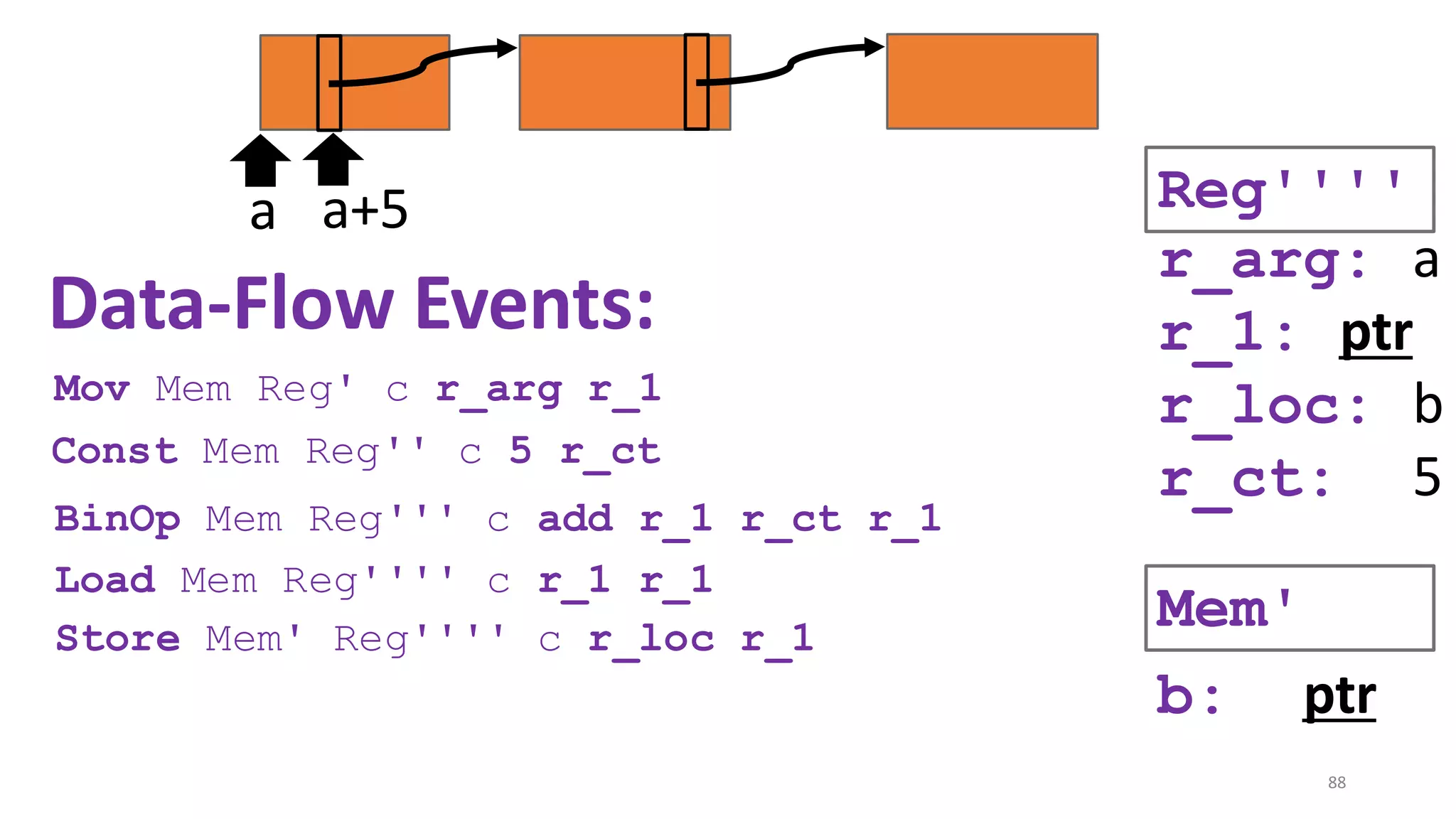
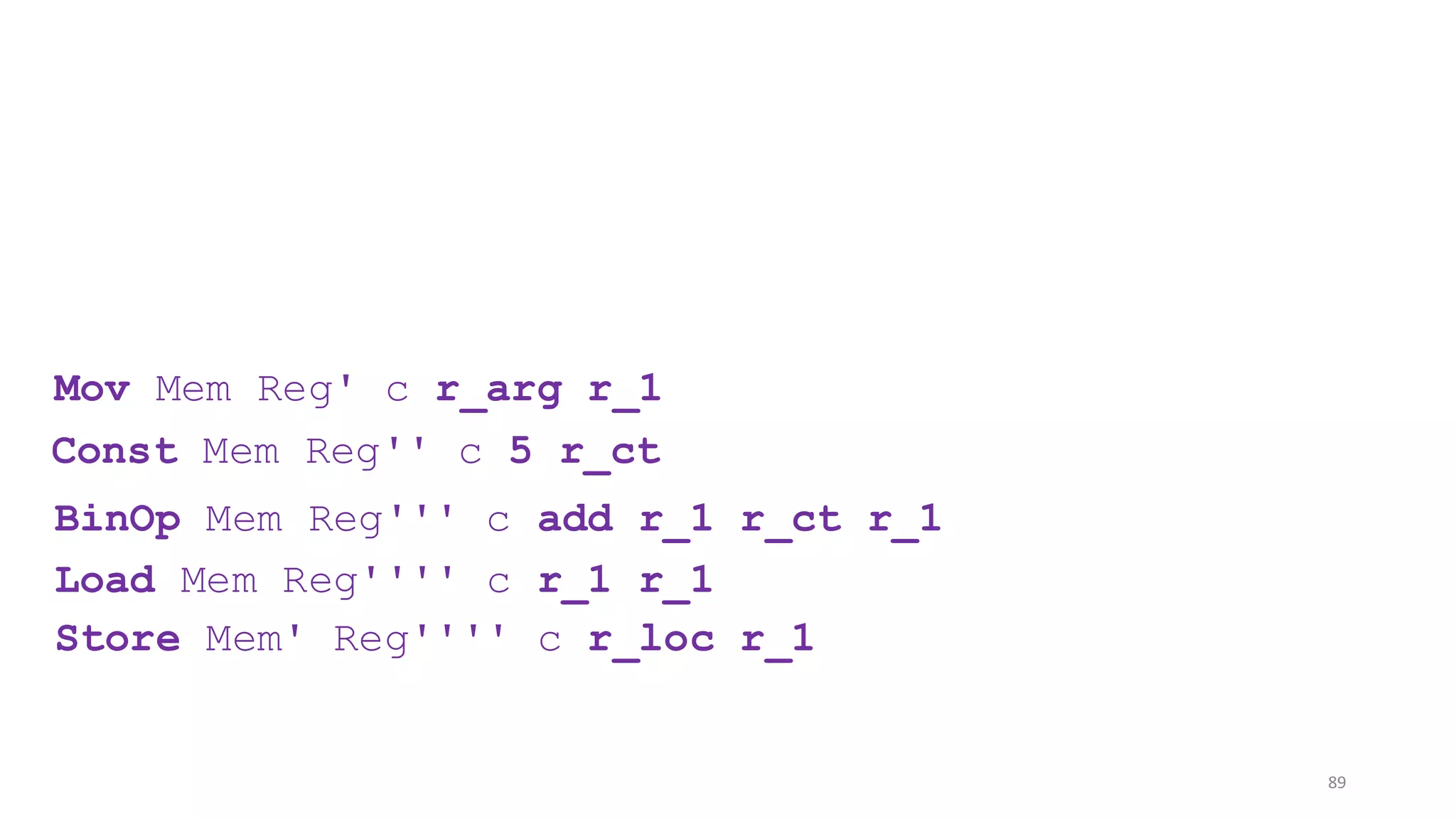
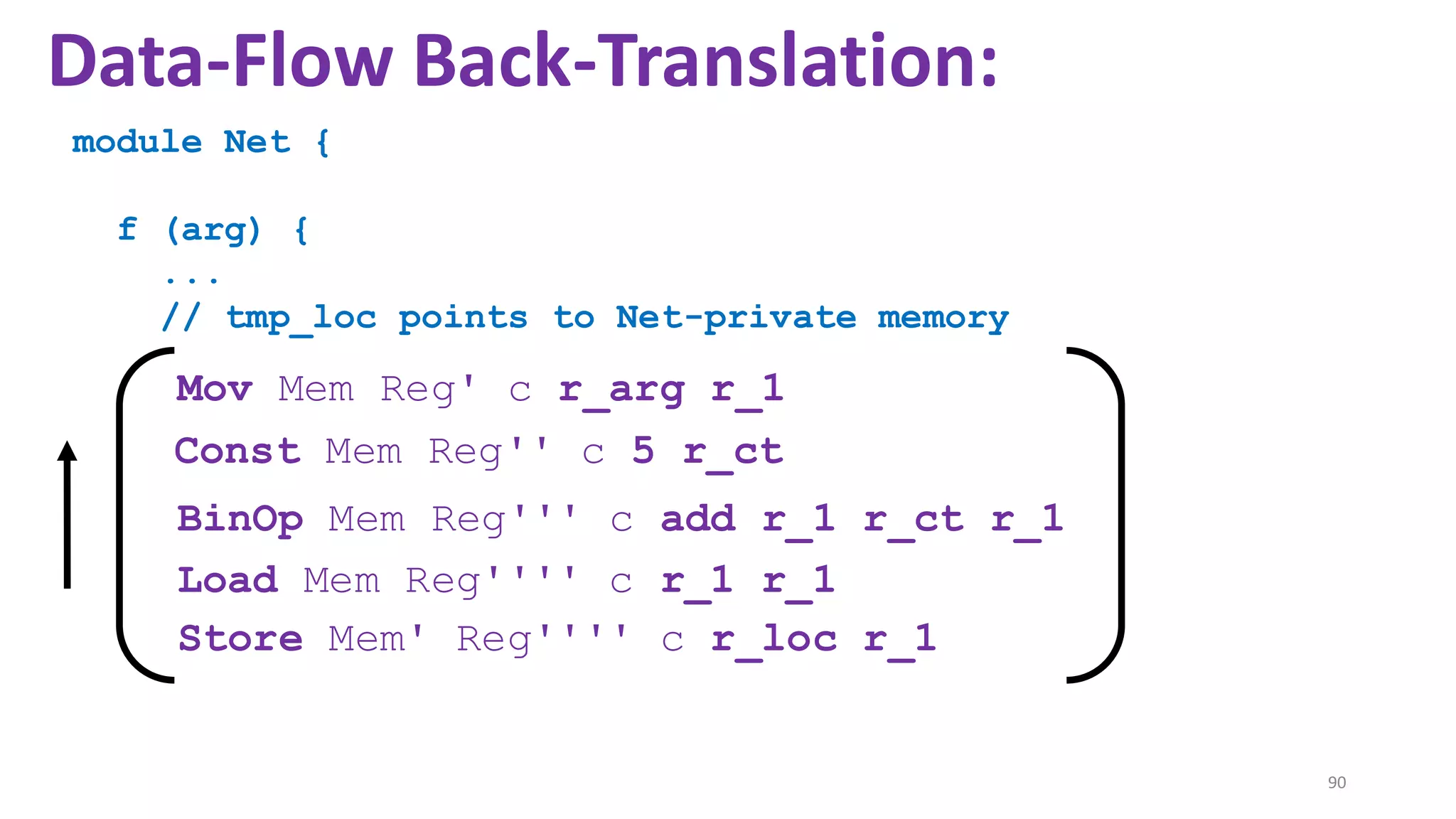

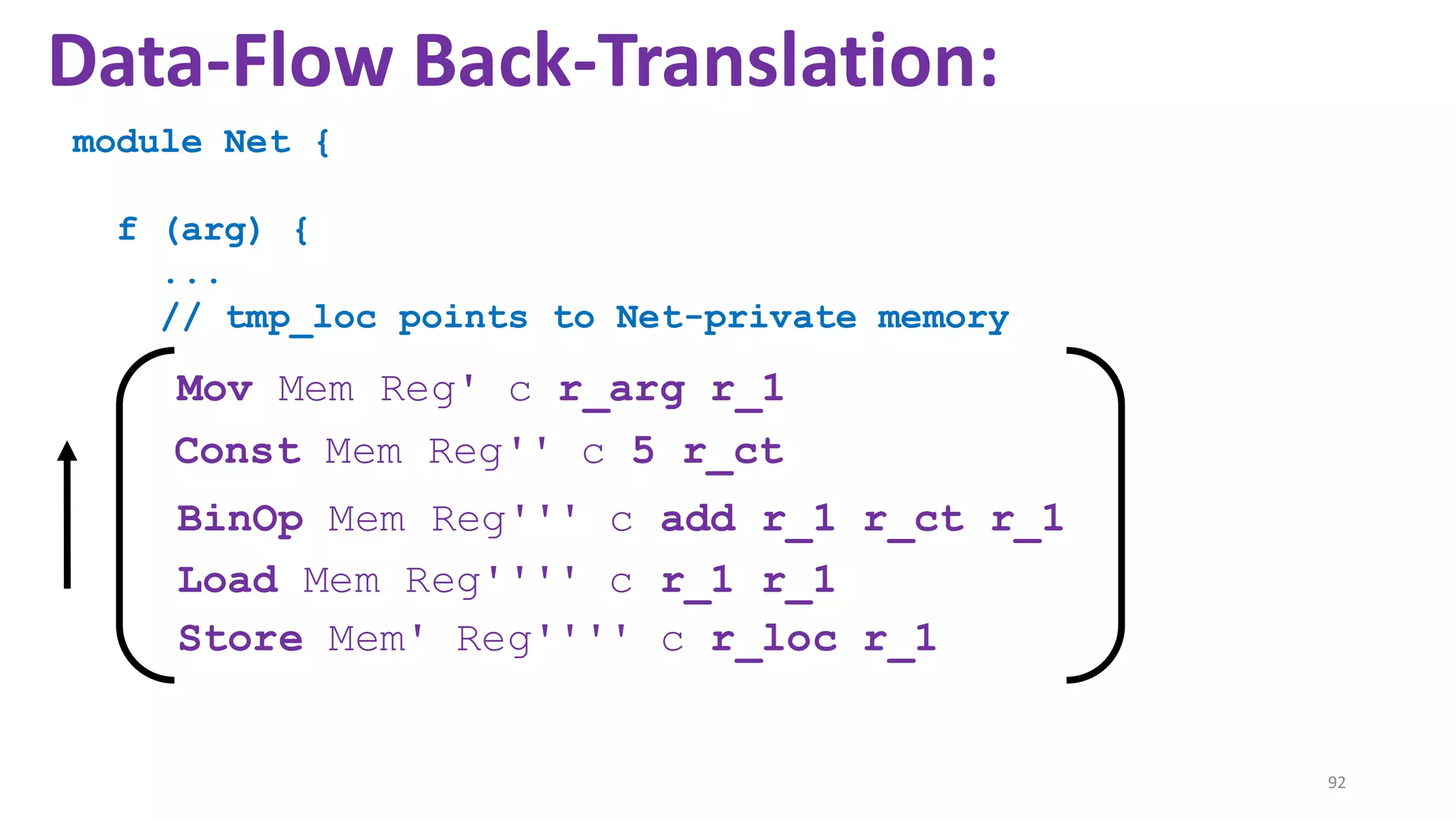
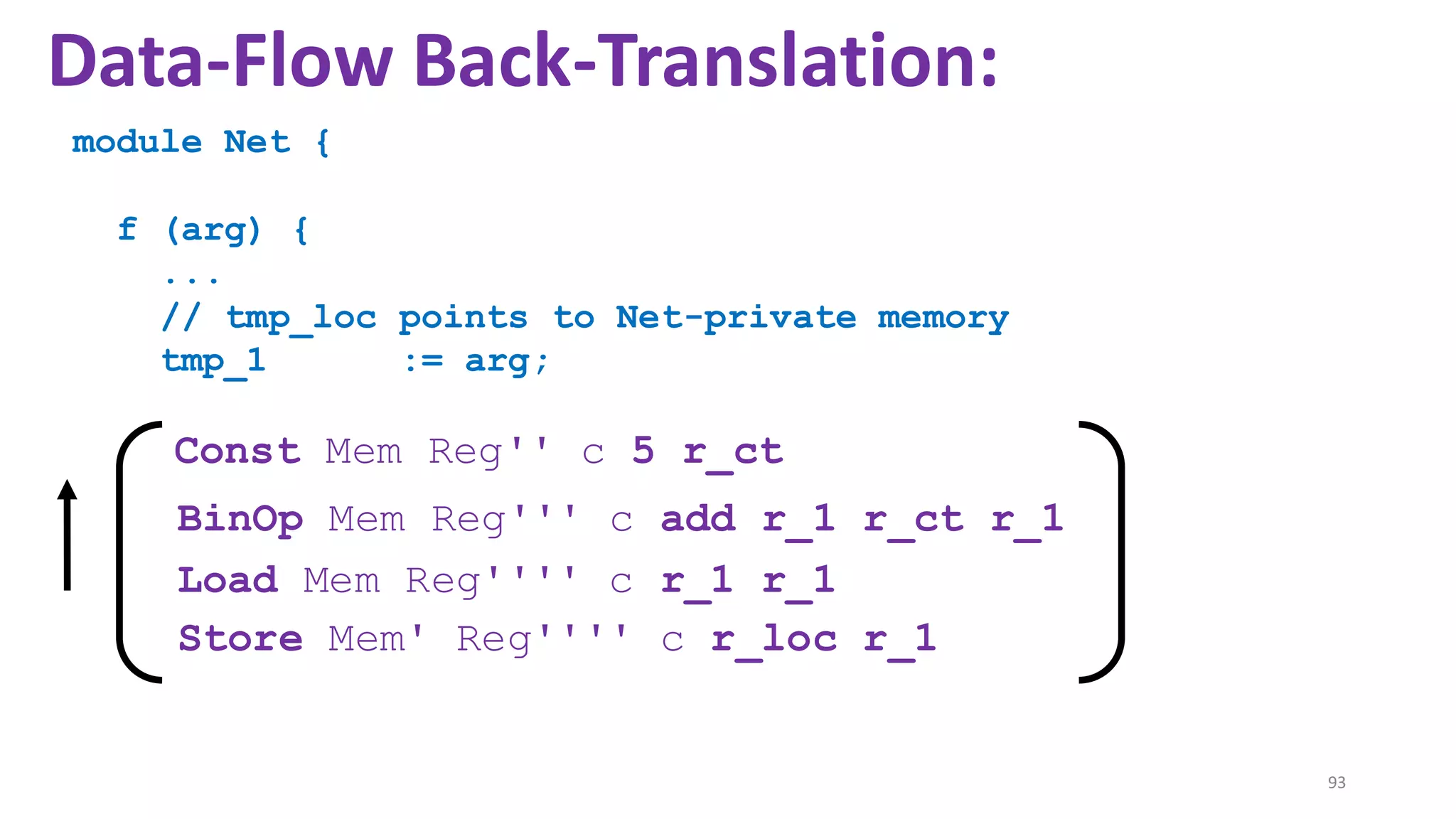
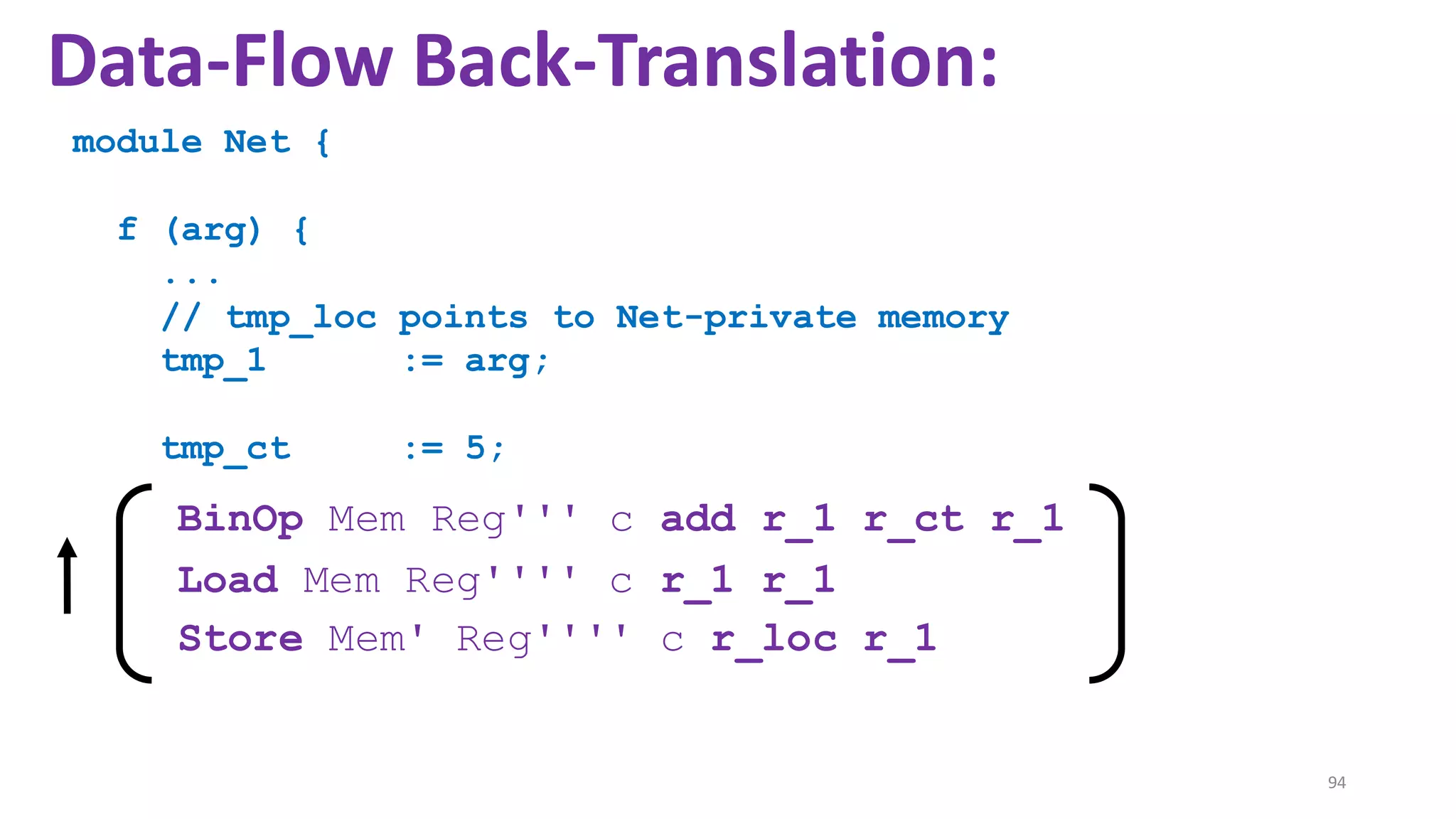
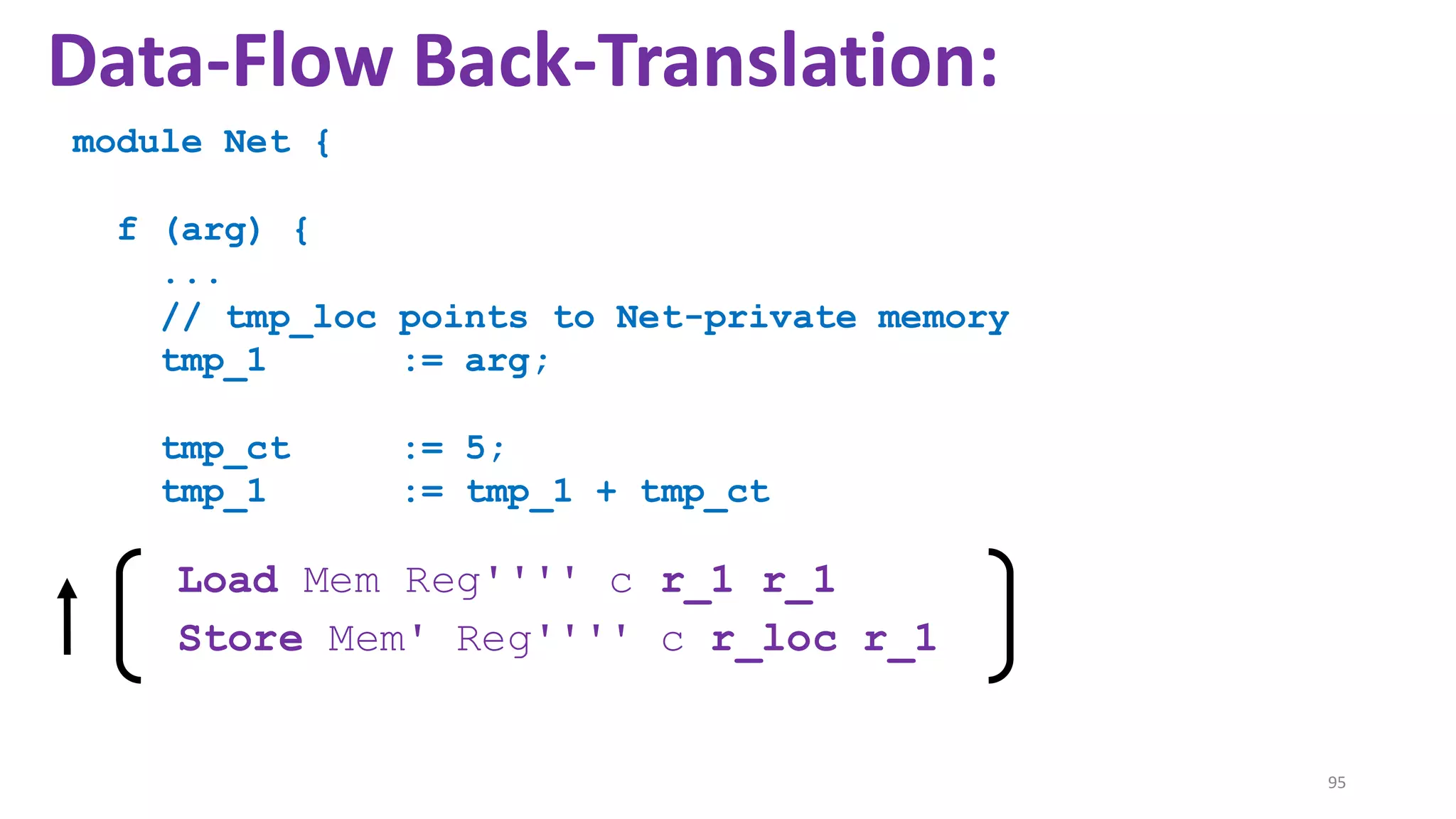
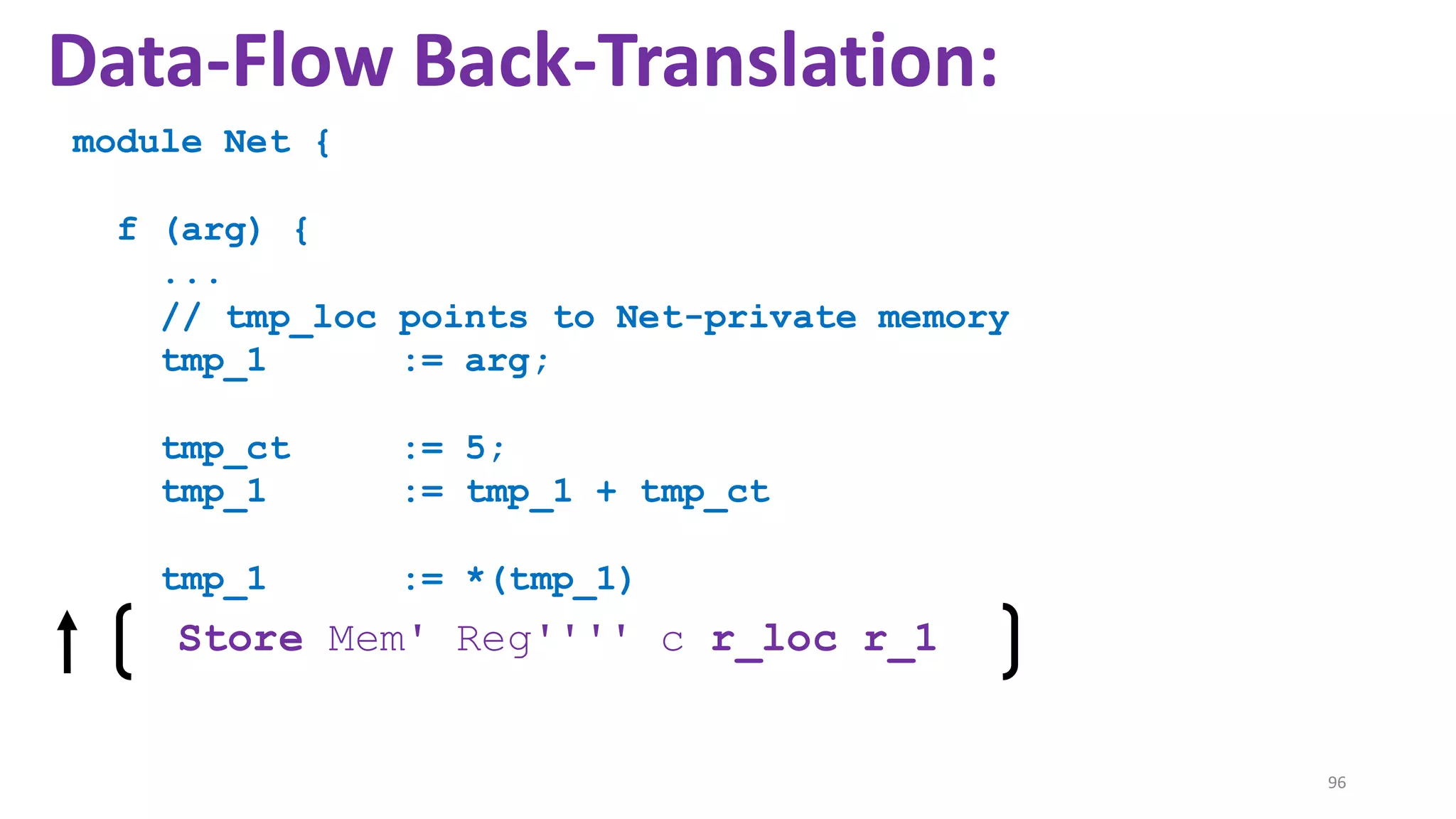
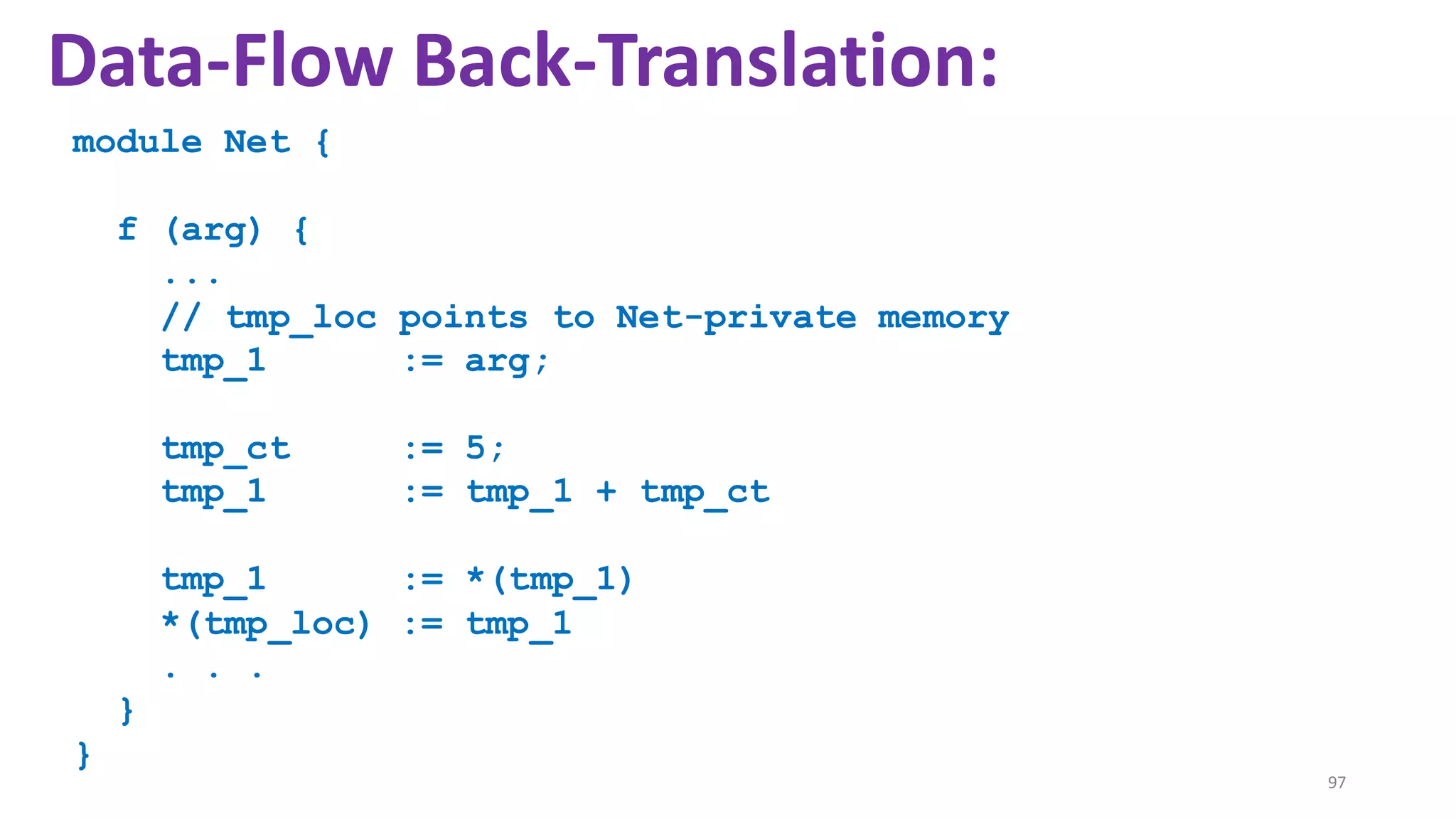
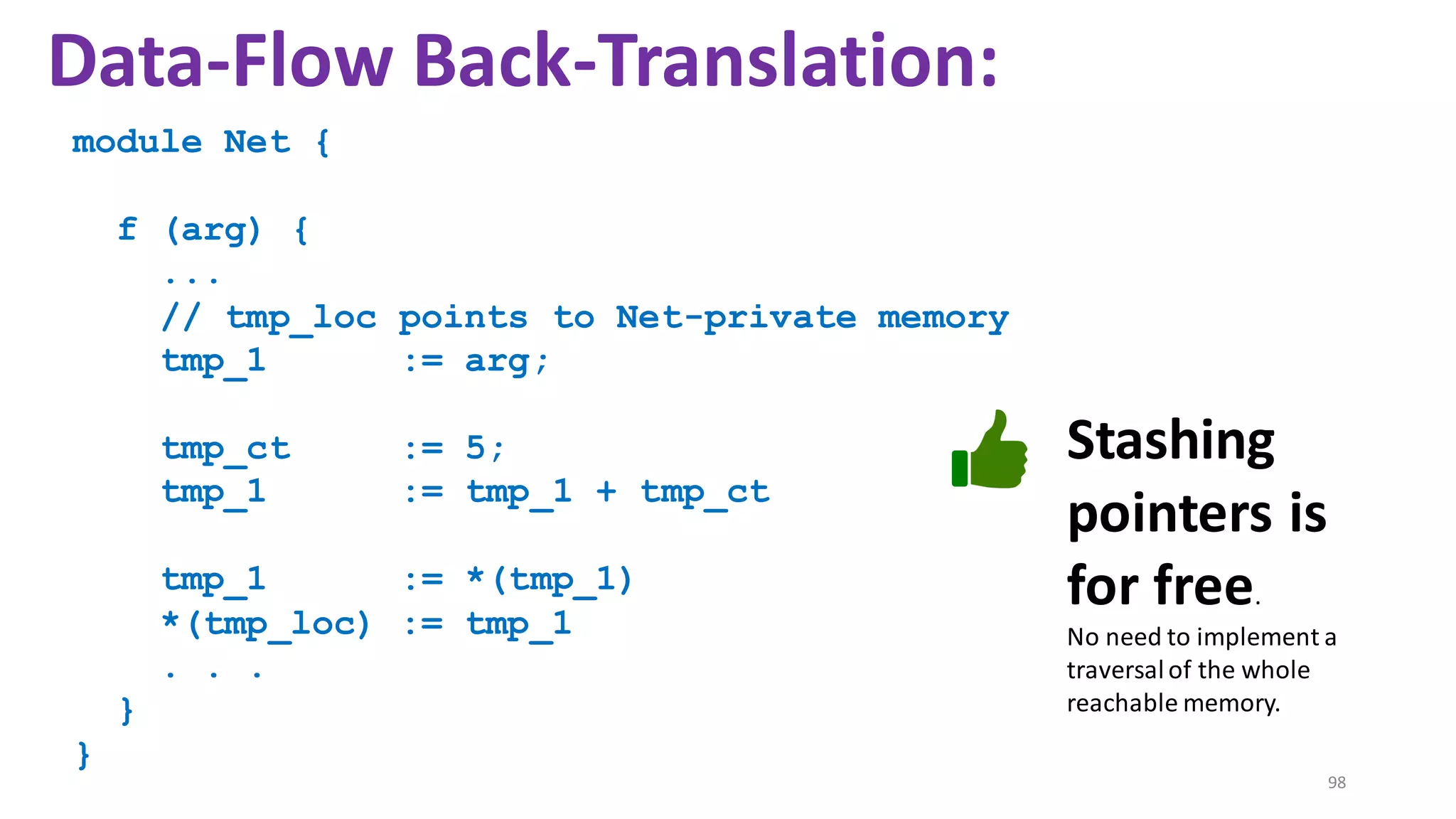
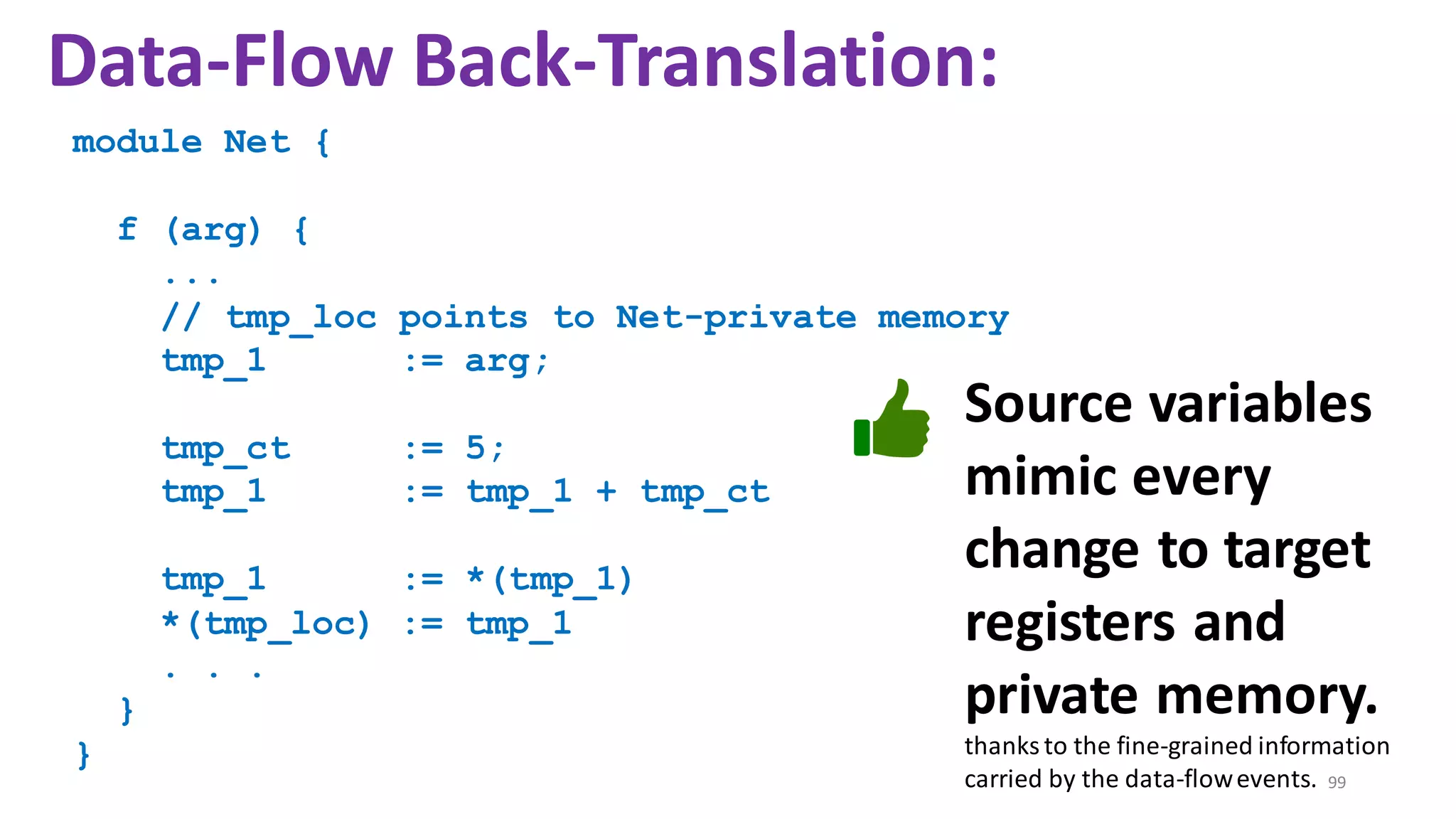
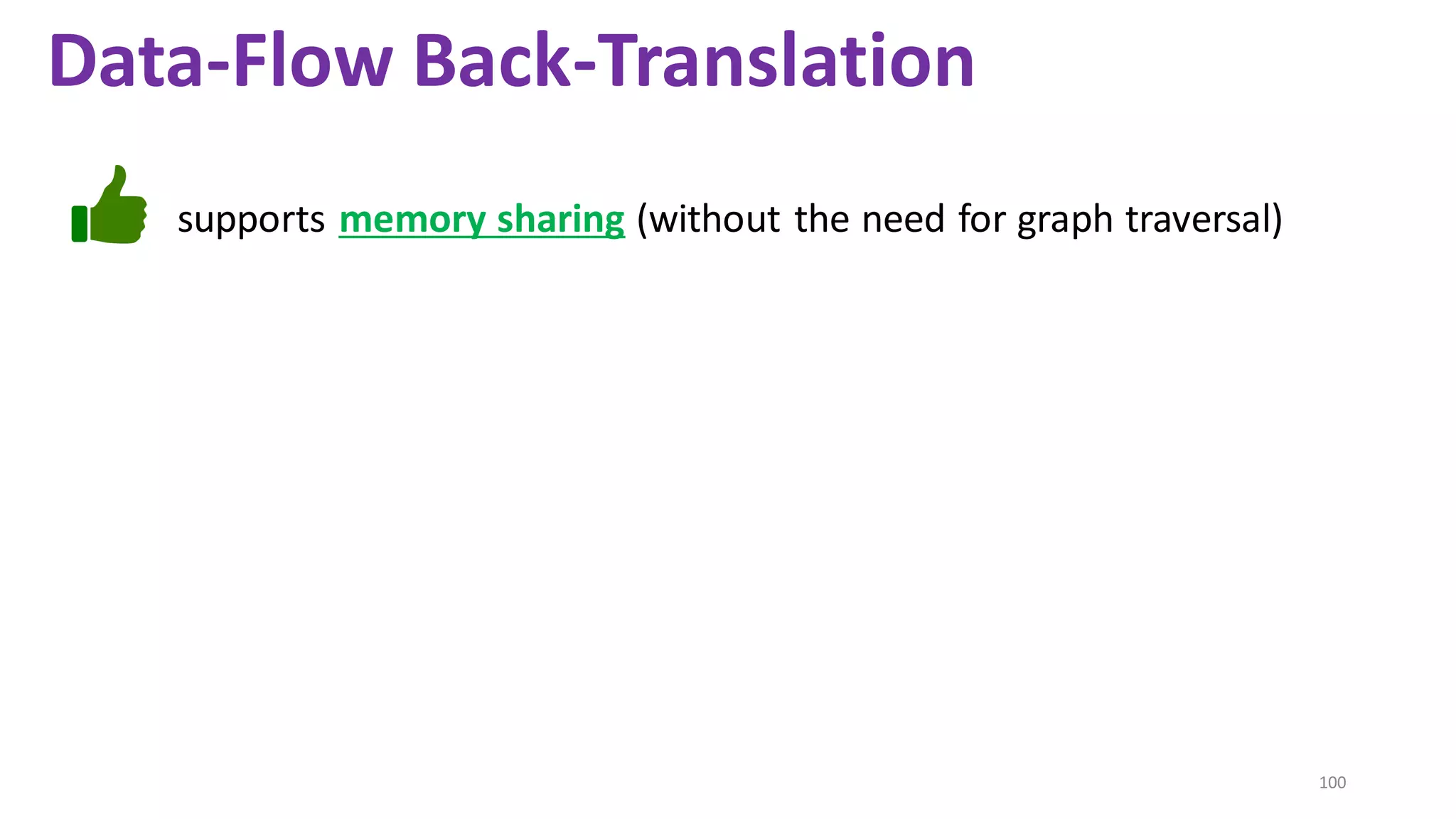
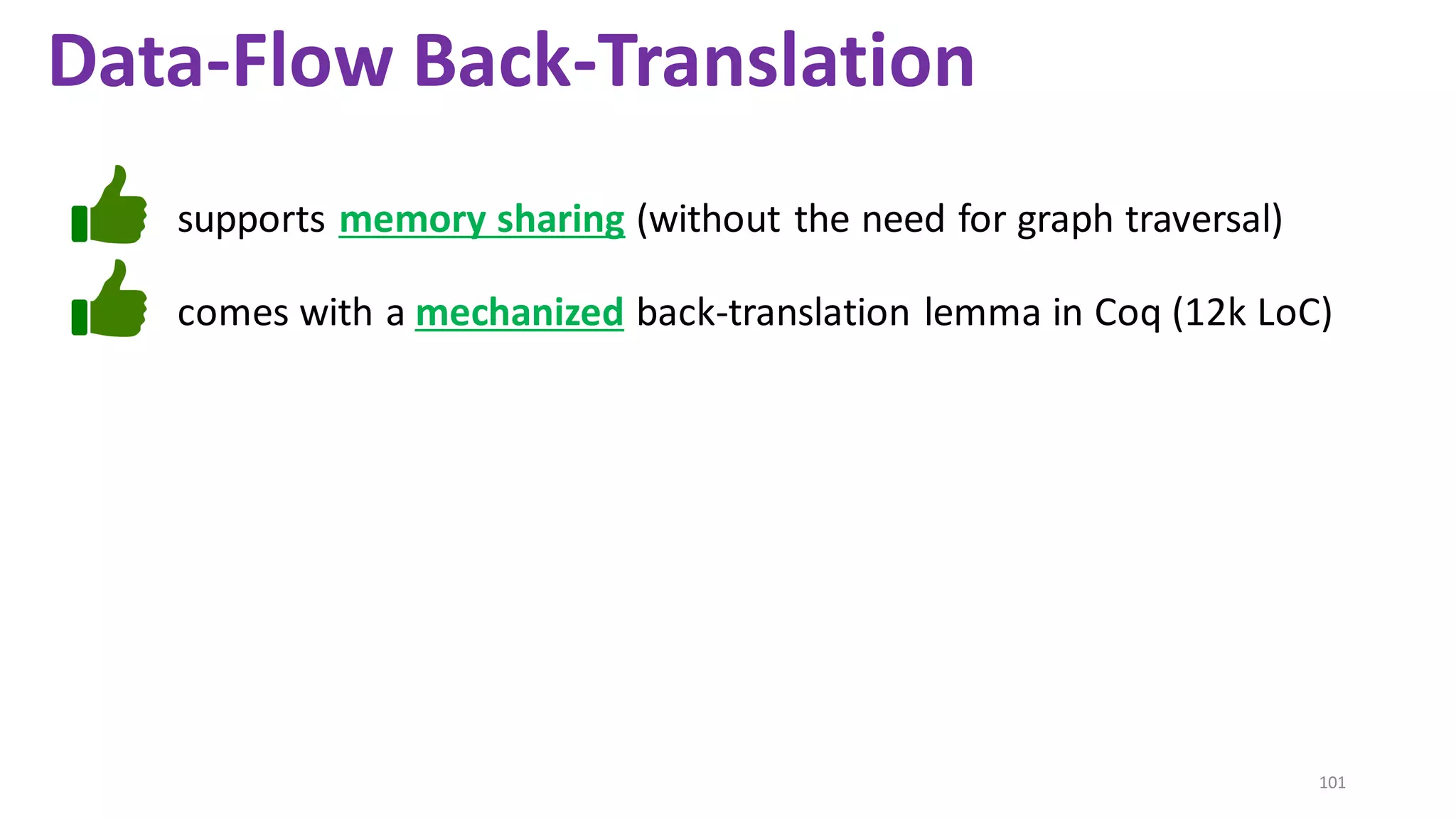
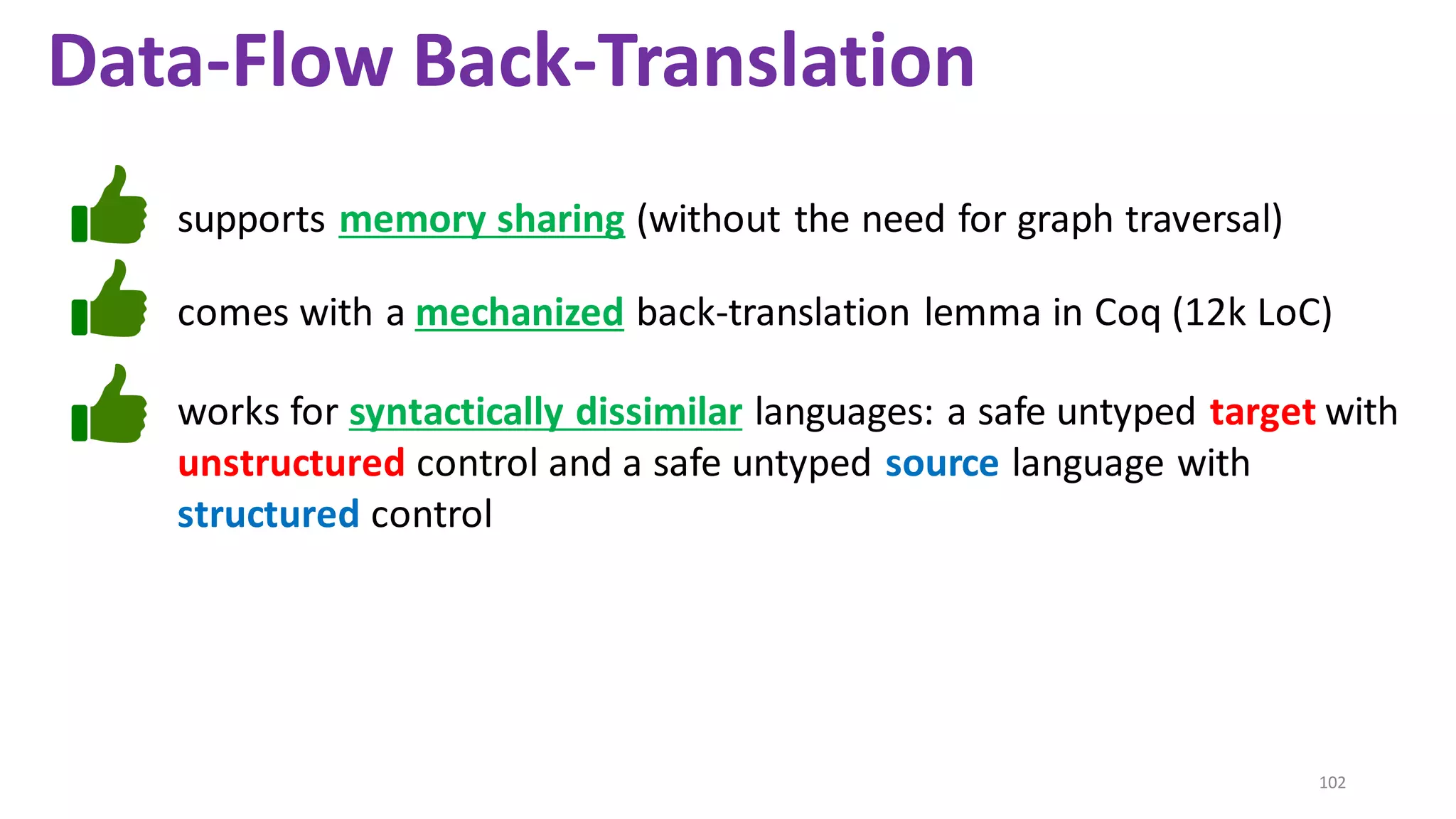

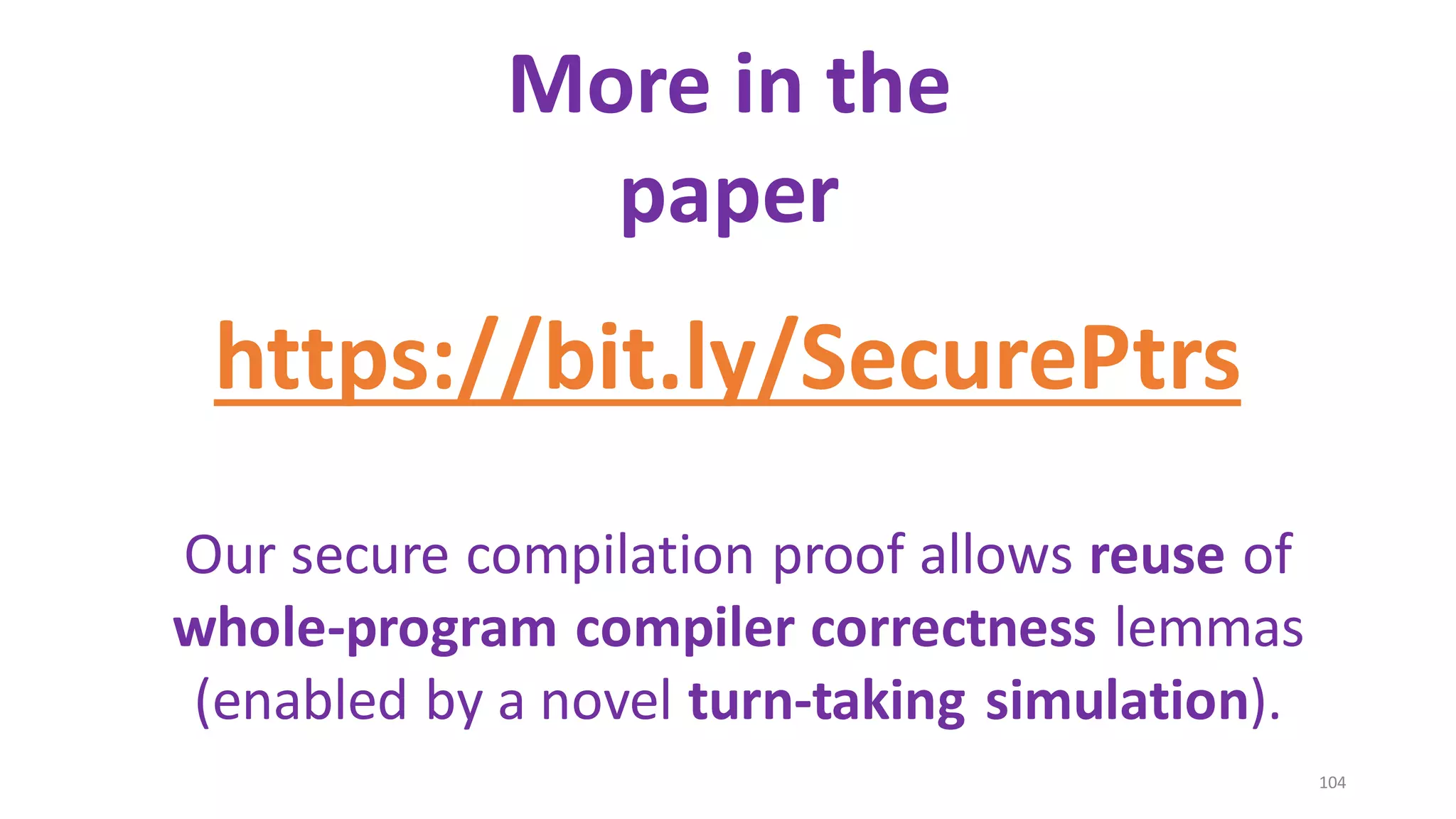
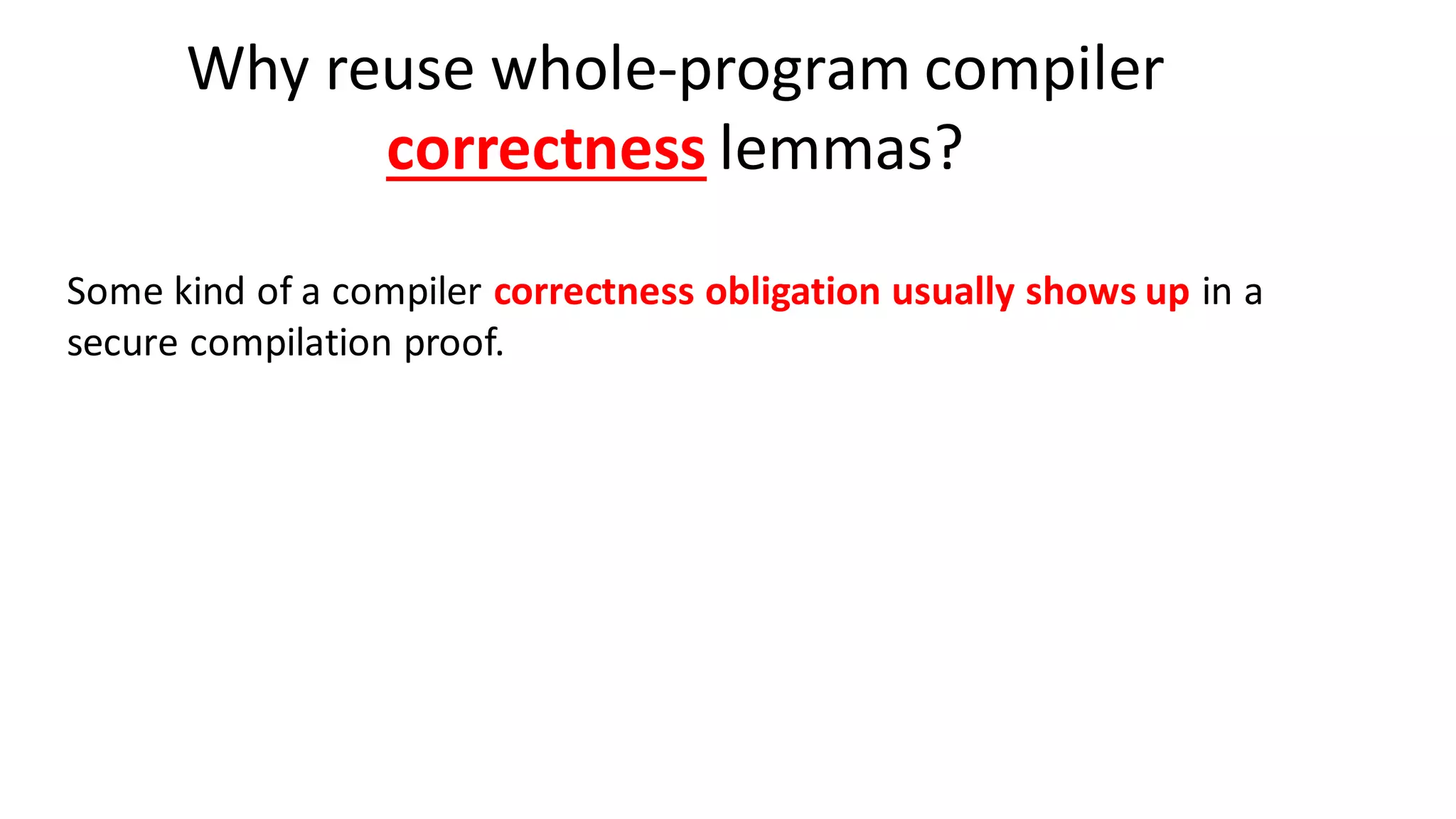
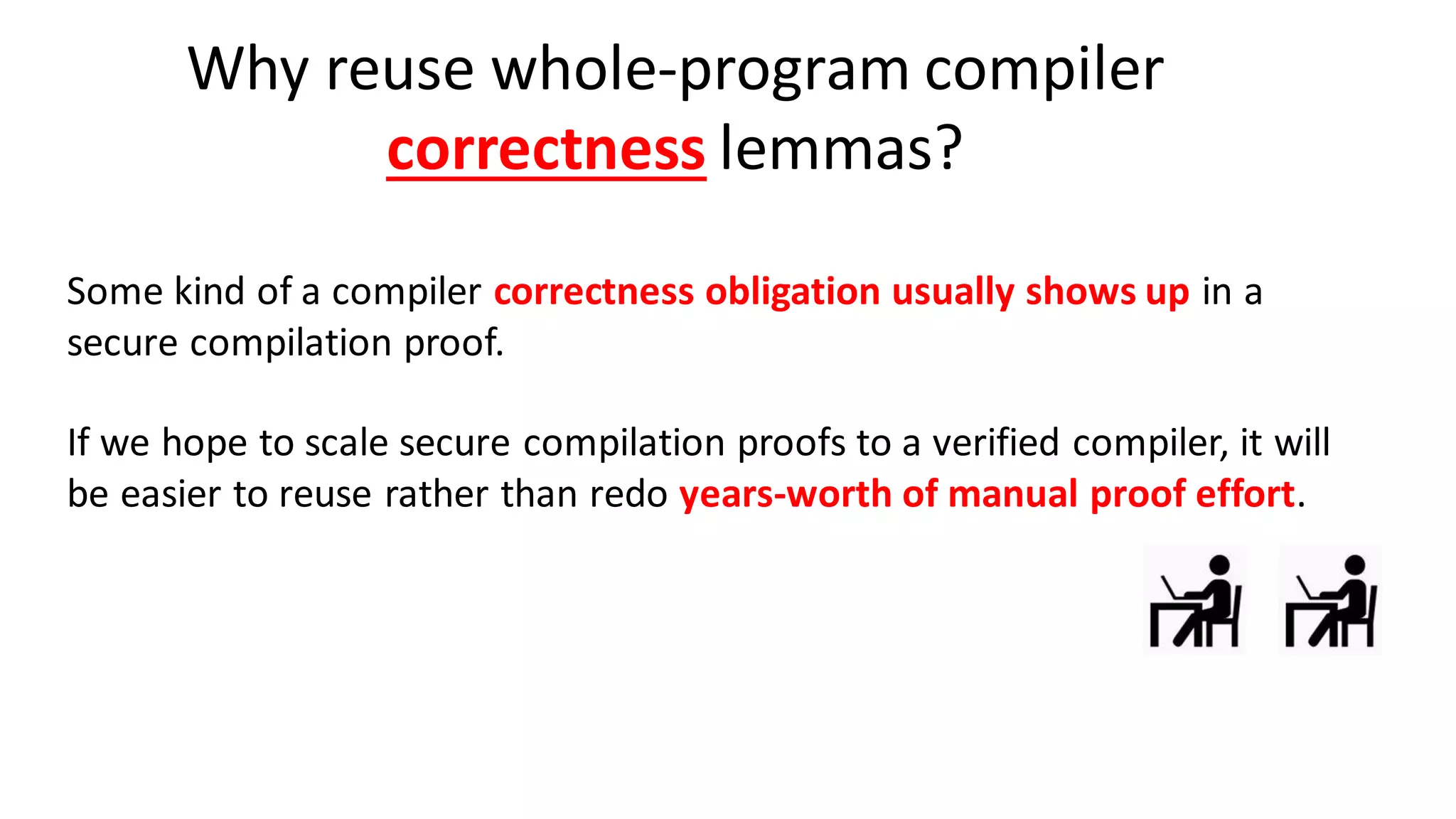

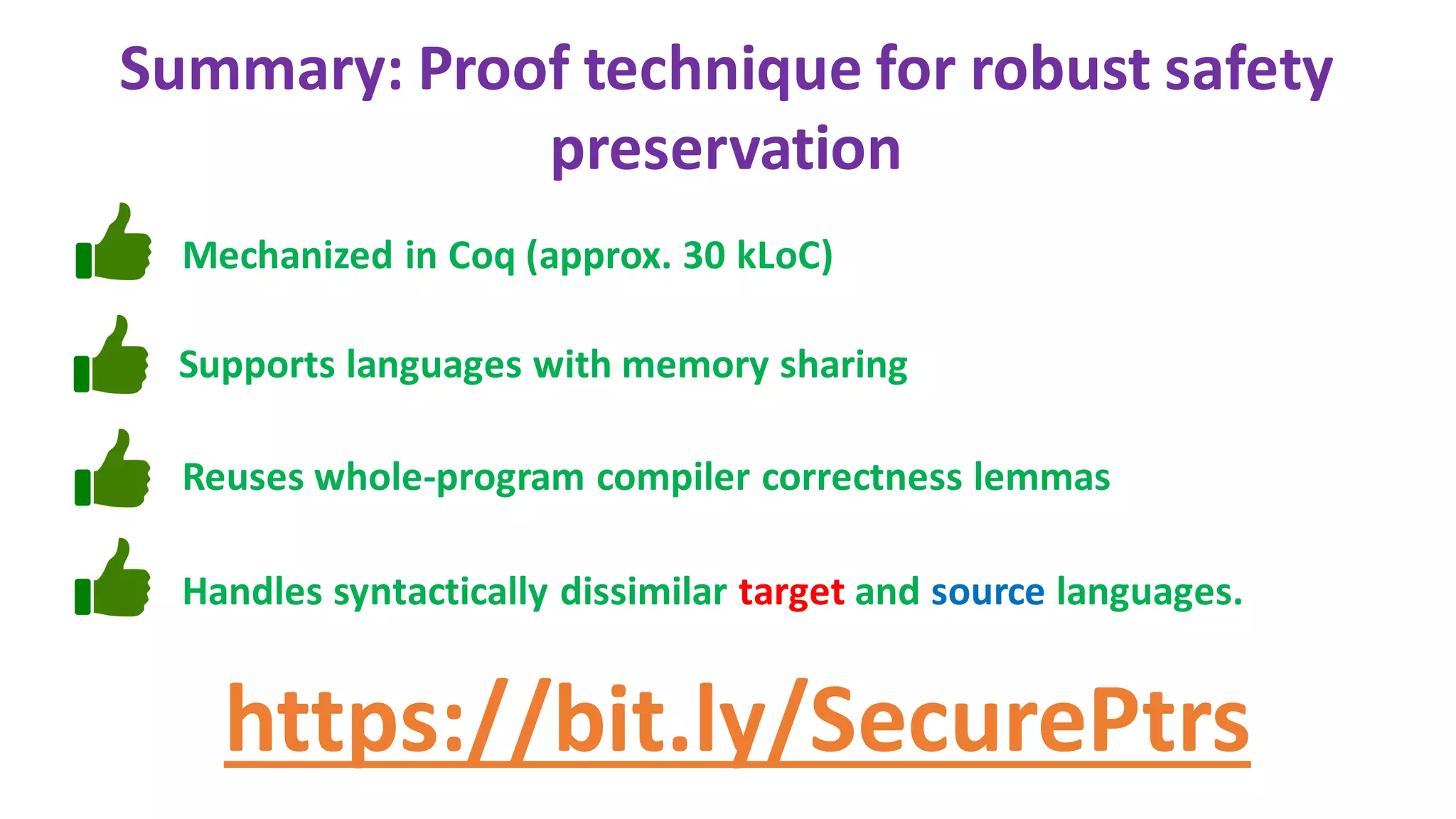

![State-of-the-art re reuse of whole-program
compiler correctness lemmas in secure compilation
[Abate et al. 2018 "When good components go bad"] [El-Korashy et al. 2021 "CapablePtrs"]
Mechanized in Coq
Supports memory sharing by
pointer passing
Detailed technique but not
machine checkable
Languages have static
memory partition with only
primitive values passable as
arguments.](https://image.slidesharecdn.com/prisc-2022-220122131600/75/SecurePtrs-Proving-Secure-Compilation-with-Data-Flow-Back-Translation-and-Turn-Taking-Simulation-110-2048.jpg)
![Scaled the proof of Abate et al. 2018 to languages
with memory sharing
[Abate et al. 2018 "When good components go bad"] [El-Korashy et al. 2021 "CapablePtrs"]
Mechanized in Coq
Supports memory sharing by
pointer passing
Detailed technique but not
machine checkable
Languages have static
memory partition with only
primitive values passable as
arguments.](https://image.slidesharecdn.com/prisc-2022-220122131600/75/SecurePtrs-Proving-Secure-Compilation-with-Data-Flow-Back-Translation-and-Turn-Taking-Simulation-111-2048.jpg)
![Scaled the proof of Abate et al. 2018 to languages
with memory sharing
[Abate et al. 2018 "When good components go bad"] [El-Korashy et al. 2021 "CapablePtrs"]
Mechanized in Coq
Supports memory sharing by
pointer passing
Detailed technique but not
machine checkable
Novel ternary turn-taking
relation to support
memory sharing.
(13k LoC in Coq)](https://image.slidesharecdn.com/prisc-2022-220122131600/75/SecurePtrs-Proving-Secure-Compilation-with-Data-Flow-Back-Translation-and-Turn-Taking-Simulation-112-2048.jpg)
![Borrowed some intuitions from CapablePtrs
[Abate et al. 2018 "When good components go bad"] [El-Korashy et al. 2021 "CapablePtrs"]
Key Ingredient: Rely on a ternary relation. Key Ingredient: Rely on a ternary relation.](https://image.slidesharecdn.com/prisc-2022-220122131600/75/SecurePtrs-Proving-Secure-Compilation-with-Data-Flow-Back-Translation-and-Turn-Taking-Simulation-113-2048.jpg)
![Borrowed some intuitions from CapablePtrs
[Abate et al. 2018 "When good components go bad"] [El-Korashy et al. 2021 "CapablePtrs"]
Key Ingredient: Rely on a ternary relation
(called recomposition) between three target-
language executions.
Key Ingredient: Rely on a ternary relation (called
TrICL) between two target-language executions, and
a third sourceexecuton.](https://image.slidesharecdn.com/prisc-2022-220122131600/75/SecurePtrs-Proving-Secure-Compilation-with-Data-Flow-Back-Translation-and-Turn-Taking-Simulation-114-2048.jpg)
![Borrowed some intuitions from CapablePtrs
[Abate et al. 2018 "When good components go bad"] [El-Korashy et al. 2021 "CapablePtrs"]
Key Ingredient: Rely on a ternary relation
(called recomposition) between three target-
language executions.
Key Ingredient: Rely on a ternary relation (called
TrICL) between two target-language executions, and
a third sourceexecuton.
Use ideas from the
strong/weak binary similarity
in CapablePtrs to make the
ternary recomposition
relation aware of memory
sharing.](https://image.slidesharecdn.com/prisc-2022-220122131600/75/SecurePtrs-Proving-Secure-Compilation-with-Data-Flow-Back-Translation-and-Turn-Taking-Simulation-115-2048.jpg)
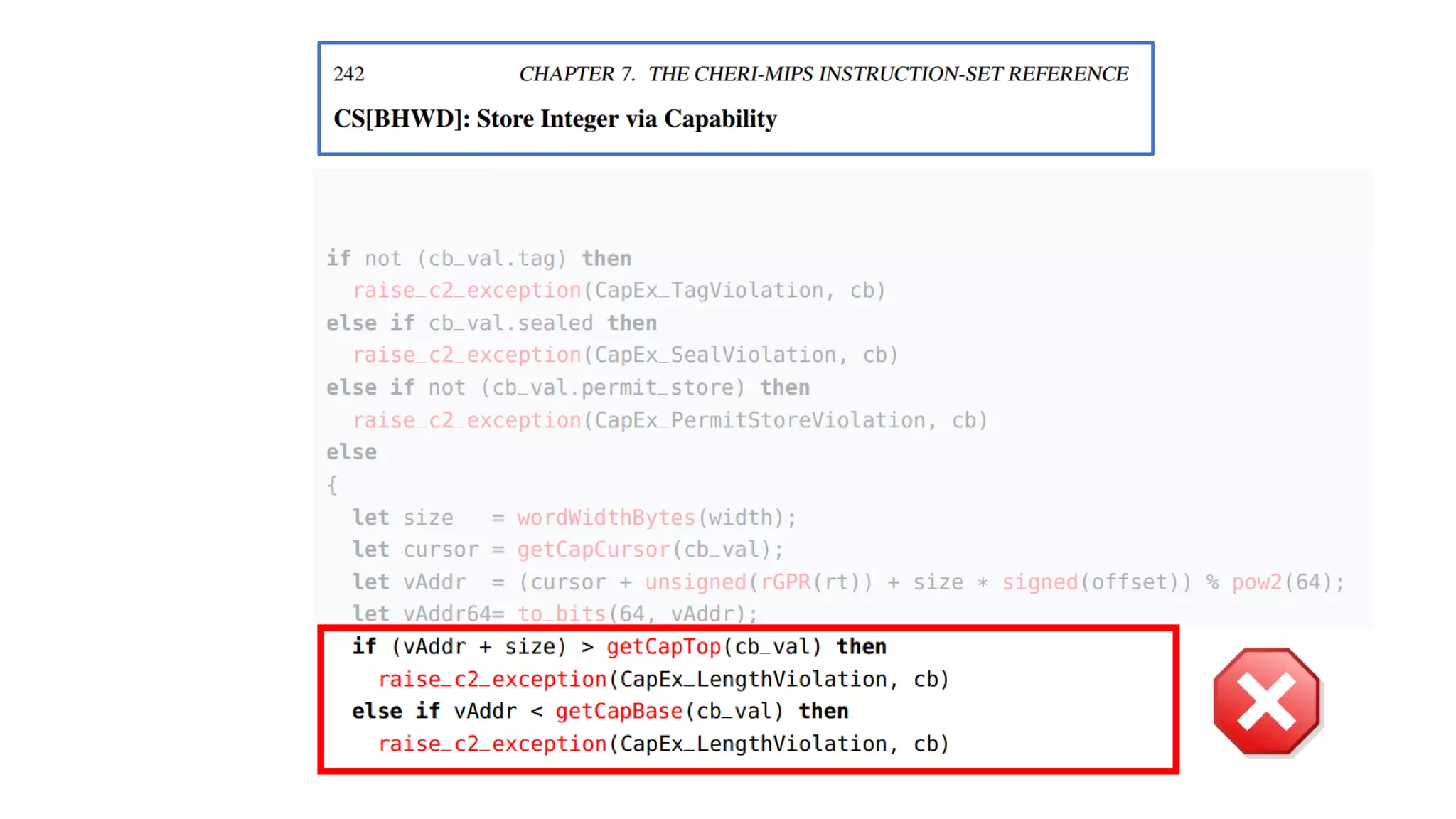
![Setup: Secure compilation of partial programs
import module Net
module Main {
char iobuffer[1024];
static long int user_balance_usd;
int main(void) {
Net.init_network(iobuffer)
Net.receive();
}
}
r1
init_network:
addi $r1 $r_arg 1024
sw $r2 0($r1)](https://image.slidesharecdn.com/prisc-2022-220122131600/75/SecurePtrs-Proving-Secure-Compilation-with-Data-Flow-Back-Translation-and-Turn-Taking-Simulation-117-2048.jpg)
![Setup: Secure compilation of partial programs
import module Net
module Main {
char iobuffer[1024];
static long int user_balance_usd;
int main(void) {
Net.init_network(iobuffer)
Net.receive();
}
}
r1
init_network:
addi $r1 $r_arg 1024
sw $r2 0($r1)
Compiler should
ensure that the
context
CANNOT access
the user balance](https://image.slidesharecdn.com/prisc-2022-220122131600/75/SecurePtrs-Proving-Secure-Compilation-with-Data-Flow-Back-Translation-and-Turn-Taking-Simulation-118-2048.jpg)
![119
Example: stash of the Net module
CapablePtrs [El-Korashy et al. 2021]](https://image.slidesharecdn.com/prisc-2022-220122131600/75/SecurePtrs-Proving-Secure-Compilation-with-Data-Flow-Back-Translation-and-Turn-Taking-Simulation-119-2048.jpg)
![120
Given a target interaction trace with Net
Call ? init_network
Example: stash of the Net module
CapablePtrs [El-Korashy et al. 2021]](https://image.slidesharecdn.com/prisc-2022-220122131600/75/SecurePtrs-Proving-Secure-Compilation-with-Data-Flow-Back-Translation-and-Turn-Taking-Simulation-120-2048.jpg)
![121
Given a target interaction trace with Net
Call ? init_network
Ret !
Example: stash of the Net module
CapablePtrs [El-Korashy et al. 2021]](https://image.slidesharecdn.com/prisc-2022-220122131600/75/SecurePtrs-Proving-Secure-Compilation-with-Data-Flow-Back-Translation-and-Turn-Taking-Simulation-121-2048.jpg)
![122
Given a target interaction trace with Net
Call ? init_network
Ret !
Call ? receive
Example: stash of the Net module
CapablePtrs [El-Korashy et al. 2021]](https://image.slidesharecdn.com/prisc-2022-220122131600/75/SecurePtrs-Proving-Secure-Compilation-with-Data-Flow-Back-Translation-and-Turn-Taking-Simulation-122-2048.jpg)
![123
Given a target interaction trace with Net
Call ? init_network
Ret !
Call ? receive
Ret !
Example: stash of the Net module
CapablePtrs [El-Korashy et al. 2021]](https://image.slidesharecdn.com/prisc-2022-220122131600/75/SecurePtrs-Proving-Secure-Compilation-with-Data-Flow-Back-Translation-and-Turn-Taking-Simulation-123-2048.jpg)
![124
Given a target interaction trace with Net
Call ? init_network
Ret !
Call ? receive
Ret !
Find a source
implementation
of Net that emits a related
interaction trace.
Example: stash of the Net module
CapablePtrs [El-Korashy et al. 2021]](https://image.slidesharecdn.com/prisc-2022-220122131600/75/SecurePtrs-Proving-Secure-Compilation-with-Data-Flow-Back-Translation-and-Turn-Taking-Simulation-124-2048.jpg)
![125
Given a target interaction trace with Net
Call ? init_network
Ret !
Call ? receive
Ret !
Before the source
implementation
of init_network
returns, it stashes its
argument in private
memory, e.g. in a variable
called
init_network_arg.
Example: stash of the Net module
CapablePtrs [El-Korashy et al. 2021]](https://image.slidesharecdn.com/prisc-2022-220122131600/75/SecurePtrs-Proving-Secure-Compilation-with-Data-Flow-Back-Translation-and-Turn-Taking-Simulation-125-2048.jpg)
![126
Given a target interaction trace with Net
Call ? init_network
Ret !
Call ? receive
Ret !
Before receive
returns, it uses the pointer
stashed in
init_network_arg to
hardcode in the iobuffer
all the green values that
appeared on the given trace.
Example: stash of the Net module
CapablePtrs [El-Korashy et al. 2021]](https://image.slidesharecdn.com/prisc-2022-220122131600/75/SecurePtrs-Proving-Secure-Compilation-with-Data-Flow-Back-Translation-and-Turn-Taking-Simulation-126-2048.jpg)
![127
In general, must stash the whole shared memory
CapablePtrs [El-Korashy et al. 2021]
The same function may have
been called more than once: init_network_arg_1_c1,
init_network_arg_2_c1,
.. .
init_network_arg_n_c1](https://image.slidesharecdn.com/prisc-2022-220122131600/75/SecurePtrs-Proving-Secure-Compilation-with-Data-Flow-Back-Translation-and-Turn-Taking-Simulation-127-2048.jpg)
![128
In general, must stash the whole shared memory
CapablePtrs [El-Korashy et al. 2021]
The same function may have
been called more than once: init_network_arg_1_c1,
init_network_arg_2_c1,
.. .
init_network_arg_n_c1
init_network_arg_1_c2,
init_network_arg_2_c2,
.. .
init_network_arg_m_c2](https://image.slidesharecdn.com/prisc-2022-220122131600/75/SecurePtrs-Proving-Secure-Compilation-with-Data-Flow-Back-Translation-and-Turn-Taking-Simulation-128-2048.jpg)